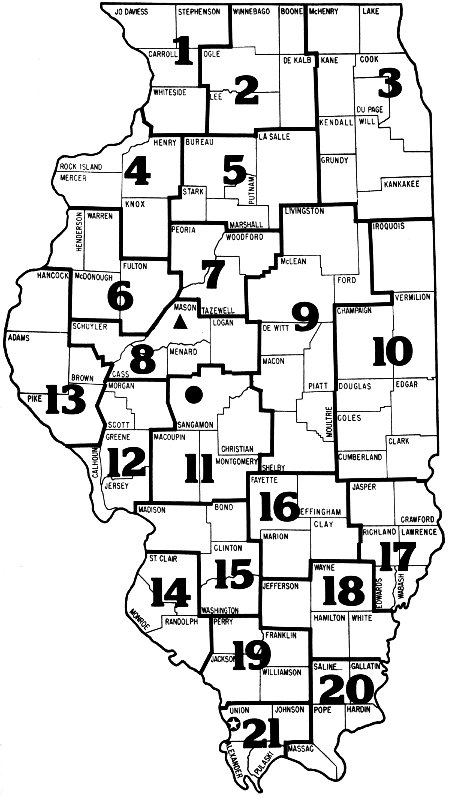

THIRD EDITION
By Robert H. Mohlenbrock
Department of Botany, Southern Illinois University
Photography by John A. Richardson and Robert H. Mohlenbrock
Illustrations by Miriam Wysong Meyer and Fredda J. Burton
Southern Illinois University
Printed by authority of the State of Illinois
Issued by
DEPARTMENT OF CONSERVATION
Division of Forestry
14
(17943—10M—4-80)
I am grateful to the late Mr. Fred Siemert, State Forester of the Illinois Division of Forestry, for suggesting the need for a new “Forest Trees of Illinois.” The first and second editions of this work have been immensely popular, and the need for a third edition is gratifying.
This third edition is only slightly modified from the second. A few illustrations and bark photographs have been substituted, and the key has been improved in places. New material has been added to the description of the water hickory.
I wish to give thanks to Mr. Al Mickelson of the Illinois Division of Forestry for encouraging this third edition, and to his assistants, Mr. John Sester and Mr. Ernest Kunze, for editing it for publication. Mark Mohlenbrock has redrawn the leaves and fruit illustrated on pages 101 and 169.
The initial edition of Forest Trees of Illinois was written in 1927 by W. R. Mattoon and R. B. Miller, two prominent foresters in the state at that time. This was revised in 1955 by Dr. George Damon Fuller, then of the Illinois State Museum, and E. E. Nuuttila, State Forester of Illinois.
In 1973, I prepared the first edition of the new Forest Trees of Illinois with new text, keys, photographs, and illustrations. An updated second edition was published in 1978. Because of the heavy demand for this work, this third edition has been prepared.
Woody plants are usually divided into trees and shrubs, but the difference between these growth forms is not always distinct. In this work, we consider a plant to be of tree stature if it has a single erect trunk which branches above the ground to form a crown. It must have a diameter of at least 3 inches 4½ feet above the ground and an overall height of 12 feet. Some of the plants included in this work are borderline between trees and shrubs. The height of a plant may be influenced by its geography. Thus, the Gray Dogwood (Cornus racemosa) in extreme southern Illinois may reach the dimensions of a small tree, but this same species in northern Illinois is also of a shrubby stature.
Almost every kind of plant in the world is known by a Common Name and a Latin Name. The Common Name is the one used locally by residents of the area. It is of limited value because people in different areas sometimes have different names for the same plant. For example, one of the trees in Illinois is known by some as the Ironwood, by others as the Blue Beech, by others as the American Hornbeam, and by still others as the Musclewood Tree. Then again, the name Ironwood applies to at least two different kinds of trees in Illinois. The Latin Name for each kind of tree is known the World over by the same name. Actually, the Latin Name is composed of two words, the genus name, which is always capitalized, and the specific epithet, which is not capitalized.
Of all the kinds of plants in the World, none is so well-loved, so stately and majestic, as a forest tree. More and more people each year are vacationing and seeking outdoor recreation. Many of them “take to the woods” for their leisure, because the forests of our state hold an unending fascination to many who enter them.
Moreover, trees provide us with building material for our homes, shade for our lawns and parks, and hundreds of other products used in our everyday living.
To know the trees we encounter is to enhance our appreciation for them. The purpose of FOREST TREES OF ILLINOIS is to bring to Illinoisans a means of identifying the trees that grow in this state.
In order to distinguish one kind of tree from another, it is necessary to learn the major characteristics which the forest trees of Illinois may possess. Illustrated below are several of the most commonly encountered characteristics of leaves and twigs. A thorough understanding of these structures will insure a quicker and more accurate identification.
On the pages following the illustrated glossary are keys to the trees of Illinois. A key is a botanical device which enables the user, through proper selection of a series of choices, to identify a specimen at hand. Separate keys are provided for trees during the spring, summer, and autumn seasons and during the winter season. Begin at the first pair of number 1’s, choose the statement that best fits the unknown specimen, and then go to the next pair of statements beneath. Continue this same procedure until the name of the plant is reached.
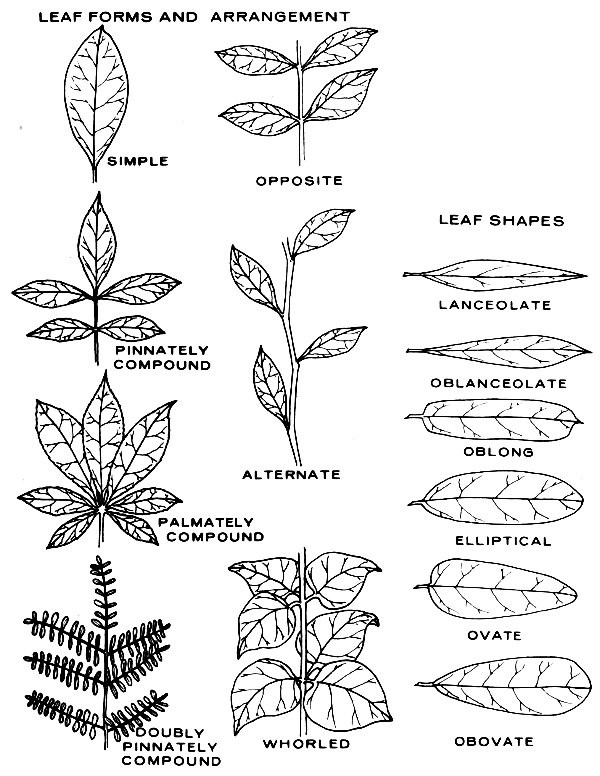
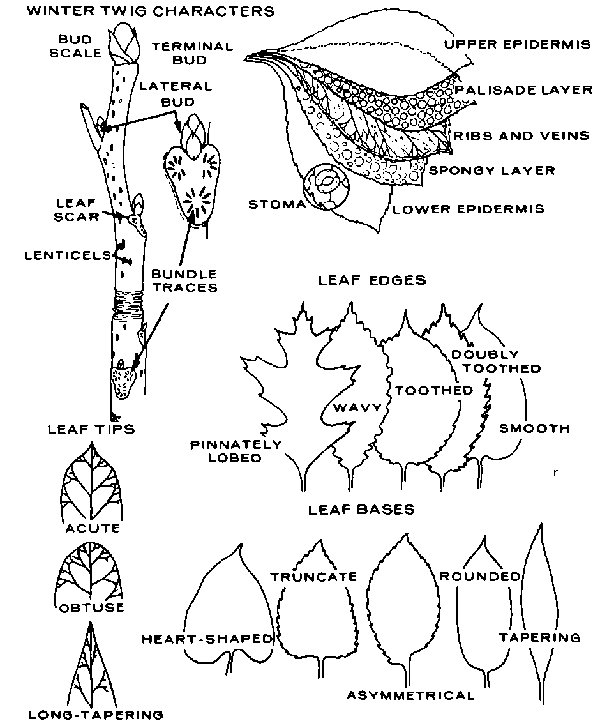
WINTER TWIG CHARACTERS
Leaves needle-like or scale-like, often evergreen.
Leaves broad and flat, never needle-like or scale-like, compound.
Leaves broad and flat, never needle-like or scale-like, simple, opposite or whorled.
Leaves broad and flat, never needle-like or scale-like, simple, alternate, neither toothed nor lobed.
Leaves broad and flat, never needle-like or scale-like; leaves simple, alternate, toothed but not lobed.
Leaves broad and flat, never needle-like or scale-like; leaves simple, alternate, lobed.
Growth Form: Medium tree up to 60 feet tall; trunk diameter up to 2 feet; crown rounded.
Bark: Smooth and pale brown at first, becoming darker and furrowed when old.
Twigs: Slender, brown, smooth or hairy, usually with pale lenticels; leaf scars opposite, U-shaped, with 3-7 bundle traces.
Buds: Rounded, reddish-brown, hairy, up to ¼ inch long.
Leaves: Opposite, simple; blades up to 4 inches long, nearly as broad, palmately 3- to 5-lobed, drooping on the sides, the edges sparsely and coarsely toothed, green and smooth or a little hairy on the upper surface, paler and much hairier on the lower surface; leaf-stalks up to 3 inches long, very hairy. The leaves turn yellow or orange in the autumn.
Flowers: Staminate and pistillate borne separately, but sometimes on the same tree, in dense clusters, yellowish-green, appearing as the leaves unfold.
Fruit: Borne in pairs, composed of a wing with a seed at the base, greenish, up to 1 inch long.
Wood: Heavy, strong, coarse-grained, light brown.
Uses: Furniture, interior finishing, cabinets.
Habitat: Woodlands.
Range: Virginia across southern Illinois to southeastern Oklahoma, south to Texas, east to Florida.
Distinguishing Features: The Southern Sugar Maple resembles the Black Maple because of its drooping leaves, but differs by its smaller, thicker leaves.
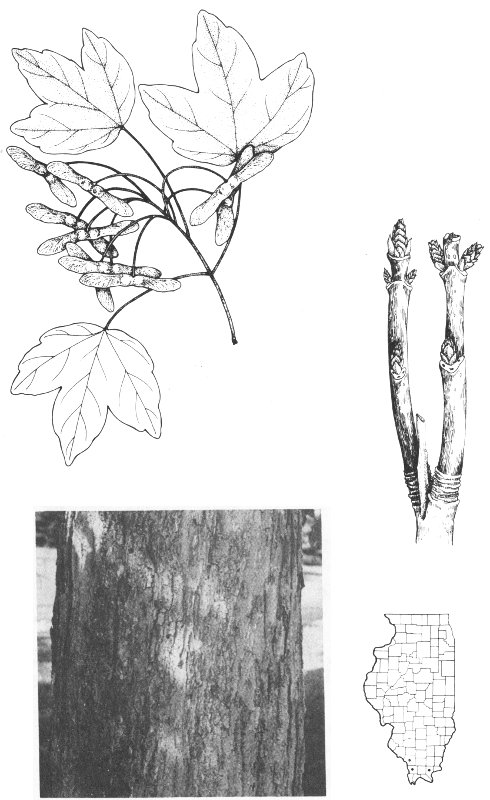
Other Name: Ash-leaved Maple.
Growth Form: Medium tree up to 60 feet tall; trunk diameter up to 4 feet; crown wide-spreading.
Bark: Light brown, ridged when young, becoming deeply furrowed with age.
Twigs: Smooth, green, glaucous, or rarely purplish, shiny, usually with white lenticels; leaf scars opposite, U-shaped, with 5-9 bundle traces.
Buds: Rounded, white-hairy, up to ⅛ inch long.
Leaves: Opposite, pinnately compound, with 3-7 leaflets; leaflets elliptic to ovate, up to 4 inches long, about half as broad, pointed at the tip, tapering or rounded at the sometimes asymmetrical base, smooth or usually coarsely toothed along the edges or even shallowly lobed, light green and smooth on the upper surface, paler and smooth or hairy on the lower surface.
Flowers: Staminate and pistillate borne on separate trees, several in a cluster, greenish-yellow, appearing as the leaves begin to unfold.
Fruit: Borne in pairs, in drooping clusters, composed of a curved wing with a seed at the base, greenish-yellow, up to 2 inches long.
Wood: Light weight, soft, close-grained, white.
Uses: Paper pulp, interior finishing, furniture.
Habitat: Moist woods.
Range: Vermont across to Saskatchewan, south to Texas, east to Florida.
Distinguishing Features: The Box Elder most nearly resembles ashes, but differs by its green or glaucous twigs and its paired fruits.
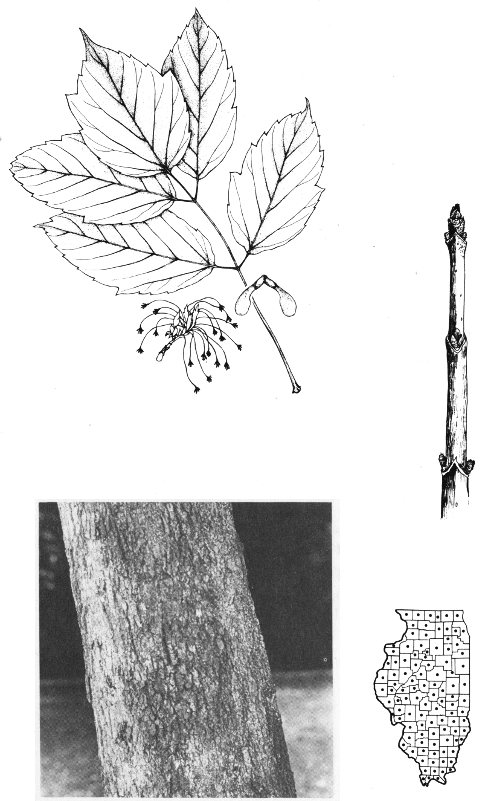
Growth Form: Medium tree up to 65 feet tall; trunk diameter up to 2½ feet; crown broad, with several upright branches.
Bark: Dark brown to black, smooth when young, soon becoming furrowed and scaly.
Twigs: Slender, brown, smooth, often with pale lenticels; leaf scars opposite, U-shaped, with 3-7 bundle traces.
Buds: Pointed, dark brown, finely hairy, up to one-fourth inch long.
Leaves: Opposite, simple; blades up to 6 inches long and nearly as broad, palmately 3- to 5-lobed, drooping on the sides, the edges of the leaves sparsely and coarsely toothed, green and smooth on the upper surface, yellow-green and smooth or hairy on the veins on the lower surface; leafstalks up to 5 inches long, smooth or hairy. The leaves turn yellow in the autumn.
Flowers: Staminate and pistillate borne separately, but sometimes on the same tree, in dense clusters, yellowish, appearing as the leaves unfold.
Fruit: Borne in pairs, composed of a wing with a seed at the base, reddish-brown to greenish, up to 1 inch long.
Wood: Heavy, strong, coarse-grained, brown.
Uses: Furniture, cabinets.
Habitat: Rich woodlands.
Range: New Hampshire across to Minnesota and South Dakota, south to Louisiana, east to Georgia.
Distinguishing Features: The Black Maple is distinguished from the Sugar Maple by its drooping leaves. It differs from the Southern Sugar Maple, which also has drooping leaves, by its larger, thinner leaves.
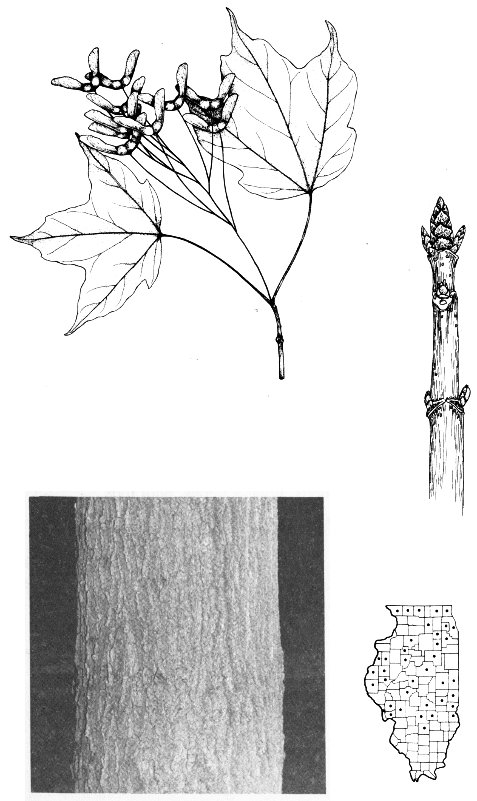
Growth Form: Medium tree up to 70 feet tall; trunk diameter up to 3 feet; crown oval or rounded.
Bark: Gray and smooth when young, becoming darker and scaly.
Twigs: Slender, mostly smooth, more or less reddish, usually with pale lenticels; leaf scars opposite, U-shaped, with 3-7 bundle traces.
Buds: Rounded, reddish, usually hairy, up to ¼ inch long.
Leaves: Opposite, simple; blades up to 6 inches long, nearly as broad, palmately 3- to 5-lobed, the edges of the leaves sharply toothed to nearly toothless, pale green and smooth on the upper surface, white or gray and either smooth or hairy on the lower surface; leafstalks smooth or finely hairy, up to 4 inches long.
Flowers: Staminate and pistillate borne separately, but sometimes on the same tree, in dense clusters, bright red or yellow, opening in February and March before the leaves begin to unfold.
Fruit: Borne in pairs, composed of an erect wing with a seed at the base, red or yellow, up to 1 inch long.
Wood: Heavy, close-grained, light brown.
Uses: Furniture, gun-stocks.
Habitat: Swamps, low woods, upland slopes, bluff tops.
Range: Newfoundland across to Ontario, south to eastern Texas, east to Florida.
Distinguishing Features: The Red Maple is characterized by its white lower leaf surfaces and its shallowly lobed leaves. The similar Silver Maple has very deeply lobed leaves.
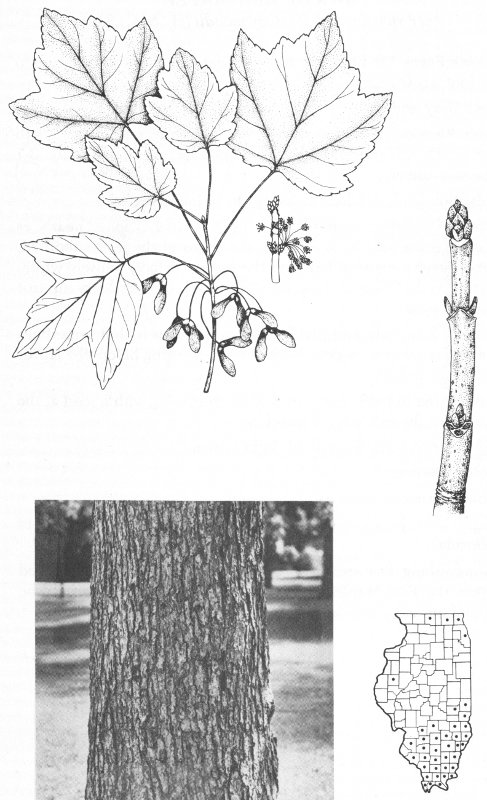
Growth Form: Medium tree up to 40 feet tall; trunk diameter up to 1 foot; crown narrow.
Bark: Gray and smooth when young, becoming darker and scaly.
Twigs: Slender, white-hairy when young, usually becoming smooth or nearly so, reddish; leaf scars opposite, U-shaped, with 3-7 bundle traces.
Buds: Rounded, reddish, hairy, up to ¼ inch long.
Leaves: Opposite, simple; blades up to 6 inches long, nearly as broad, palmately 3- to 5-lobed, the edges of the leaves toothed, green and somewhat hairy on the upper surface, densely white-hairy on the lower surface; leafstalks stout, densely hairy, up to 4 inches long.
Flowers: Staminate and pistillate borne separately, but sometimes on the same tree, in dense red clusters, opening before the leaves begin to unfold.
Fruit: Borne in pairs, composed of an erect wing with a seed at the base, bright red, over 1 inch long.
Wood: Heavy, coarse-grained, light brown.
Use: Furniture.
Habitat: Wooded swamps.
Range: New Jersey across to Missouri, south to Texas, east to Florida.
Distinguishing Features: The Swamp Red Maple is distinguished from the Red Maple by the dense coat of white hairs on the undersurface of the leaves and by the longer fruits.
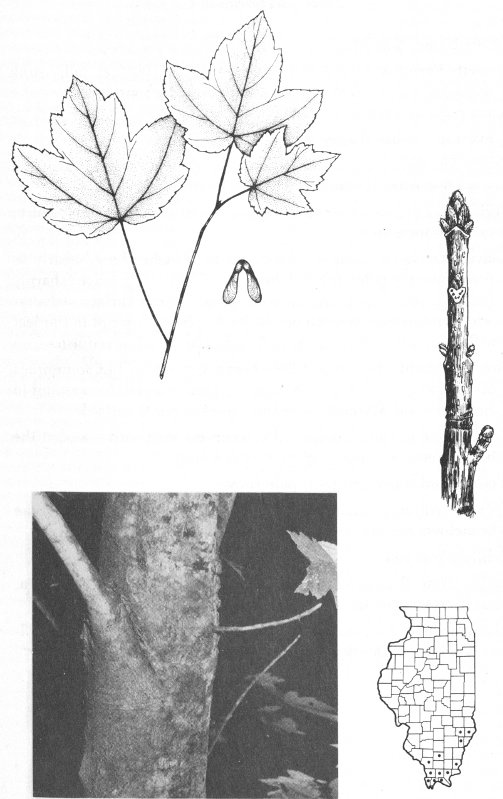
Other Name: Soft Maple.
Growth Form: Medium to large tree up to 100 feet tall; trunk diameter up to 5 feet; crown usually broadly rounded.
Bark: Gray or silvery, smooth at first, becoming loose and scaly or even somewhat shaggy when old.
Twigs: Slender, reddish-brown, smooth, often curving upward; leaf scars opposite, U-shaped, with 3-7 bundle traces.
Buds: More or less rounded, reddish-brown, smooth to finely hairy, up to ⅛ inch long.
Leaves: Opposite, simple; blades up to 8 inches long, nearly as broad, deeply palmately 5-lobed, the edges of the leaves sharply toothed, pale green and smooth on the upper surface, silvery-white and usually smooth on the lower surface, except in the leaf axils; leafstalks smooth, up to 5 inches long, often reddish.
Flowers: Staminate and pistillate borne separately, but sometimes on the same tree, in dense clusters, greenish-yellow, opening in February and March before the leaves begin to unfold.
Fruit: Borne in pairs, composed of a curved wing with a seed at the base, green or yellow, up to 3 inches long.
Wood: Hard, close-grained, pale brown.
Uses: Furniture; sometimes grown as an ornamental, but the branchlets are brittle.
Habitat: Wet soil.
Range: New Brunswick across to Minnesota and South Dakota, south to Oklahoma, Texas, east to northern Florida.
Distinguishing Features: The deeply lobed leaves which are silvery-white on the flower surface best distinguish this tree.
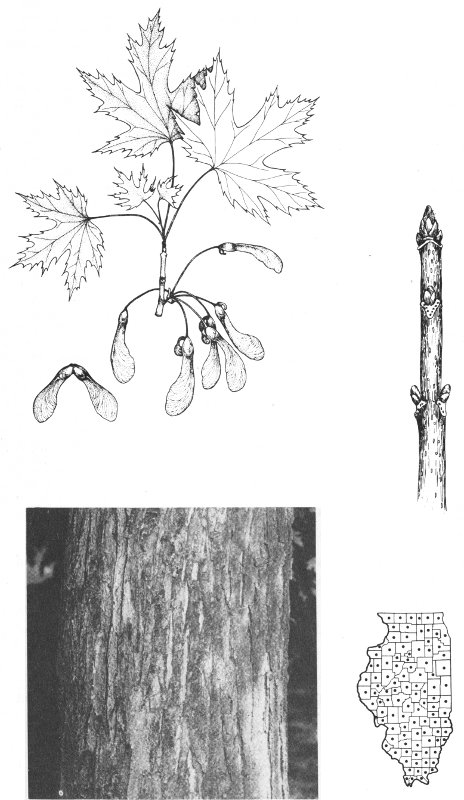
Other Name: Hard Maple.
Growth Form: Medium to large tree up to 80 feet tall; trunk diameter up to 3 feet; crown broadly rounded, with many branches.
Bark: Gray to dark brown to black, becoming furrowed and scaly.
Twigs: Slender, smooth, brown, often with pale lenticels; leaf scars opposite, U-shaped, with 3-7 bundle traces.
Buds: Pointed, dark brown, smooth or a little hairy, shiny, up to ¼ inch long.
Leaves: Opposite, simple; blades up to 5 inches long, nearly as broad or a little broader, palmately 3- to 5-lobed, the edges of the leaves sparsely and coarsely toothed, dark green and smooth on the upper surface, green or paler on the lower surface and usually smooth, or sometimes hairy on the veins; leafstalks up to 3 inches long, smooth and sometimes hairy. The leaves turn brilliant shades of yellow and orange in the autumn.
Flowers: Staminate and pistillate borne separately, but sometimes on the same tree, in dense clusters, greenish-yellow, appearing as the leaves begin to unfold.
Fruit: Borne in pairs, composed of a wing with a seed at the base, greenish-yellow to brownish, up to 1 inch long.
Wood: Heavy, strong, close-grained, light brown.
Uses: Furniture, interior finishing, cabinets; maple sugar is derived from the sap; frequently grown as an ornamental.
Habitat: Moist woods.
Range: Newfoundland across to Manitoba, south to eastern Texas, east to northern Florida.
Distinguishing Features: Leaves of the Sugar Maple differ from those of the Black Maple and the Southern Sugar Maple by being flat, rather than drooping along the edges. {Sap differs from the Norway Maple, Acer platanoides, by being clear rather than milky.}
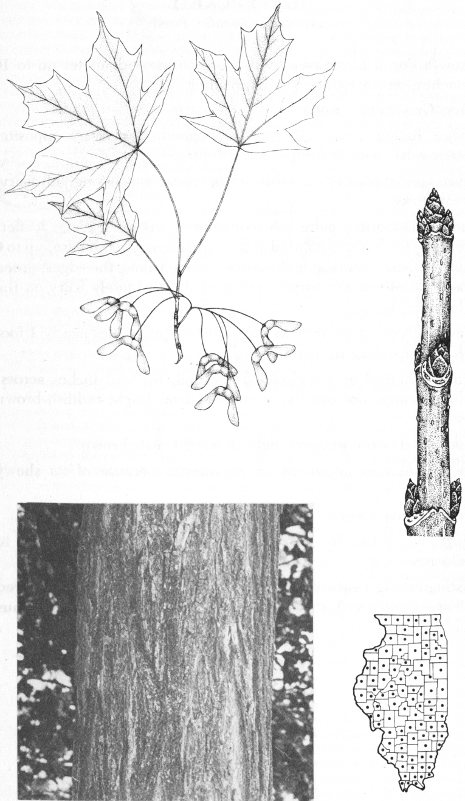
Growth Form: Small tree to 25 feet tall; trunk diameter up to 10 inches; crown rounded and spreading.
Bark: Gray to tan, smooth.
Twigs: Rather stout, gray to tan, smooth; leaf scars opposite, triangular, with 3 groups of bundle traces.
Buds: Ovoid, pointed, reddish-brown, up to ½ inch long, not hairy, not sticky.
Leaves: Opposite, palmately compound, with 5 leaflets; leaflets elliptic to obovate, pointed at the tip, tapering to the base, up to 6 inches long, less than half as wide, toothed along the edges, green and smooth on the upper surface, paler and finely hairy on the lower surface.
Flowers: Numerous, red, in large clusters sometimes nearly 1 foot long, appearing in April.
Fruit: Spherical or punching-bag shaped, up to 2 inches across, light brown, not prickly, containing 1 or 2 light reddish-brown seeds.
Wood: Soft, close-grained, light in weight, pale brown.
Use: Sometimes grown as an ornamental because of its showy flowers.
Habitat: Rich woods.
Range: North Carolina across to Missouri, south to Texas, east to Georgia.
Distinguishing Features: The smooth fruits and the beautiful red flowers distinguish this species from other members of the genus in Illinois.

Growth Form: Medium tree to 55 feet tall; trunk diameter up to 15 inches; crown broadly rounded.
Bark: Gray to pale gray, deeply furrowed and roughened when mature.
Twigs: Stout, pale brown, smooth; leaf scars opposite, triangular, with 3 groups of bundle traces.
Buds: Ovoid, pointed, reddish-brown to yellowish, up to ⅔ inch long, not hairy, not sticky.
Leaves: Opposite, palmately compound, with 5 or 7 leaflets; leaflets obovate to oblanceolate, long-pointed at the tip, tapering to the base, up to 6 inches long, less than half as wide, toothed along the edges, green and smooth on the upper surface, green or much whitened on the lower surface.
Flowers: Numerous, yellow-green, in large clusters sometimes nearly 1 foot long, appearing in April and May, the petals of each flower of different lengths.
Fruit: Prickly, spherical or nearly so, up to 1½ inch in diameter, pale brown, containing 1 large, smooth and shiny seed.
Wood: Soft, close-grained, light in weight, pale brown to nearly white.
Uses: Paper pulp. The tree is also sometimes grown as an ornamental.
Habitat: Usually rich woods.
Range: Pennsylvania across to Nebraska, south to Oklahoma, east to Alabama.
Distinguishing Features: The Ohio Buckeye differs from the Horse Chestnut {Aesculus hippocastanum} by its non-sticky buds. It differs from the Red Buckeye by the greenish-yellow flowers and prickly fruits.

Growth Form: Medium to large tree to 75 feet tall; trunk diameter up to 2 feet; crown spreading and irregular. The tree readily spreads by underground root-suckers.
Bark: Smooth or slightly roughened, light brown to dark brown.
Twigs: Stout, angular, smooth, gray to light brown, with lenticels; leaf scars alternate, large, broadly heart-shaped, slightly elevated, with usually 9 bundle traces.
Buds: Rounded, up to ⅛ inch in diameter, smooth or a little hairy, brown.
Leaves: Alternate, pinnately compound, with up to 41 leaflets; leaflets lanceolate, tapering to a long point at the tip, rounded at the base, up to 6 inches long, less than half as wide, smooth or somewhat hairy on both surfaces, often with some teeth along the edges. The leaves have an unpleasant odor when crushed.
Flowers: Some flowers with both stamens and pistils, others with one or the other, in large green or yellow clusters, each flower small, with 5 petals. The staminate flowers produce a very unpleasant odor. The flowers appear in June and July.
Fruit: Large clusters of winged seeds, yellow or orange, each fruit up to 2 inches long with one seed about in the middle.
Use: Tree-of-Heaven is grown as an ornamental, principally in urban areas where it is able to withstand considerable smoke and smog.
Habitat: Disturbed woods; readily adapts to urban conditions.
Range: Native of Asia; frequently planted in the United States and readily spreading from cultivation.
Distinguishing Features: The pinnately compound leaves with up to 41 leaflets, unpleasantly scented when crushed, make this a readily recognizable species.
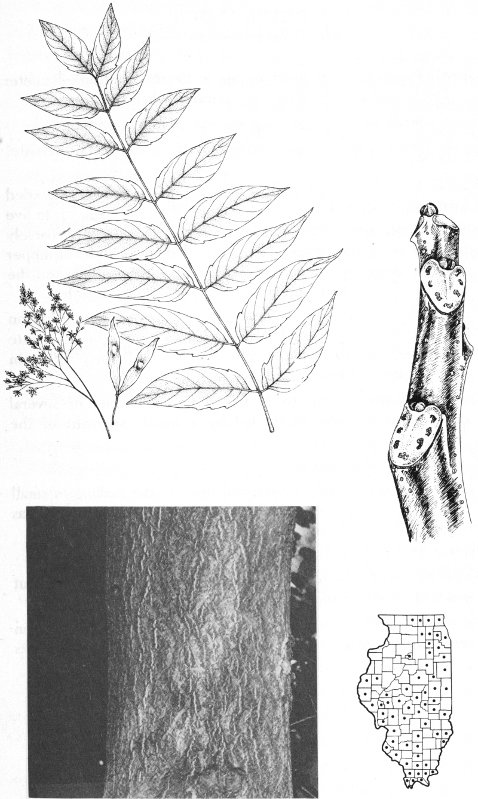
Growth Form: Small or medium tree to 45 feet tall; trunk diameter up to 12 inches; crown broadly rounded when mature.
Bark: Smooth at first, becoming shallowly fissured with age.
Twigs: Slender, gray or gray-brown, smooth; leaf scars alternate, with 3 bundle traces.
Leaves: Alternate, simple; blades nearly round or obovate, rounded at the tip, rounded or somewhat tapering to the base, up to five inches long, often nearly as broad, irregularly and rather coarsely toothed along the edges, dark green and smooth on the upper surface, green and smooth beneath, or sometimes hairy on the veins; leafstalks stout, up to 1 inch long, usually smooth.
Flowers: Staminate and pistillate flowers borne separately but on the same tree, appearing before the leaves unfold, the staminate in slender, drooping catkins up to 3 inches long, the pistillate in erect, oblong “cones” less than 1 inch long.
Fruit: Cone-shaped, up to ¾ inch long, composed of several nut-like seeds, each subtended by a woody segment of the “cone.”
Wood: Soft, straight-grained.
Uses: The wood is easily carved and used in the making of small wooden objects. It is also used for charcoal and fuel. The bark has reputed medicinal properties.
Habitat: Moist, disturbed areas.
Range: Native of Europe, Asia, and Africa; naturalized throughout much of northeastern North America.
Distinguishing Features: The small, woody “cones” and the often orbicular, irregularly toothed leaves are the distinguishing marks of this species.
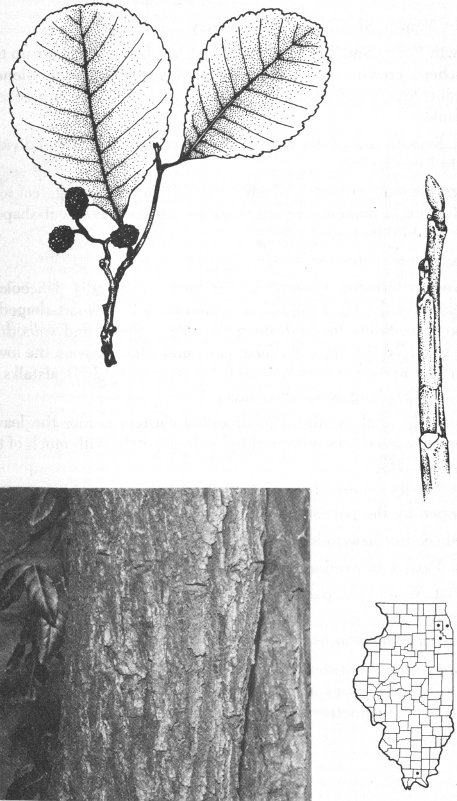
Other Names: Shadblow; Serviceberry.
Growth Form: Small tree up to 20 feet tall; trunk diameter up to 8 inches; crown rounded and spreading with many slender branchlets; trunk straight, slender, often divided into several trunks.
Bark: Smooth and silvery at first, later becoming darker and divided into loose scales.
Twigs: Slender, brown, with a few hairs when very young; leaf scars alternate, 2-ranked, slightly elevated, narrowly crescent-shaped, with 3 bundle traces.
Buds: Pointed, slender, brown, up to ½ inch long.
Leaves: Alternate, simple; blades oval to broadly lanceolate, pointed at the tip, rounded or sometimes a little heart-shaped at the base, finely toothed along the edges, green and smooth or nearly so on the upper surface, paler and often hairy on the lower surface, up to 4 inches long and about half as broad; leafstalks up to 2 inches long, smooth or hairy.
Flowers: Several produced in drooping clusters before the leaves appear, each showy with 5 white, oblong petals, with much of the flower hairy.
Fruit: Mostly spherical, up to ¼ inch in diameter, reddish-purple, capped by the persistent calyx, dry, 1- to 2-seeded.
Wood: Rather heavy, hard, close-grained, reddish-brown.
Uses: Fuel, tool handles; the fruit is edible.
Habitat: Wooded slopes; edge of cliffs.
Range: Quebec across to Minnesota, south to Nebraska, east to Louisiana and Florida.
Distinguishing Features: The Shadbush is recognized by its alternate, simple leaves which are usually heart-shaped at the base, and by its distinctive white flowers.
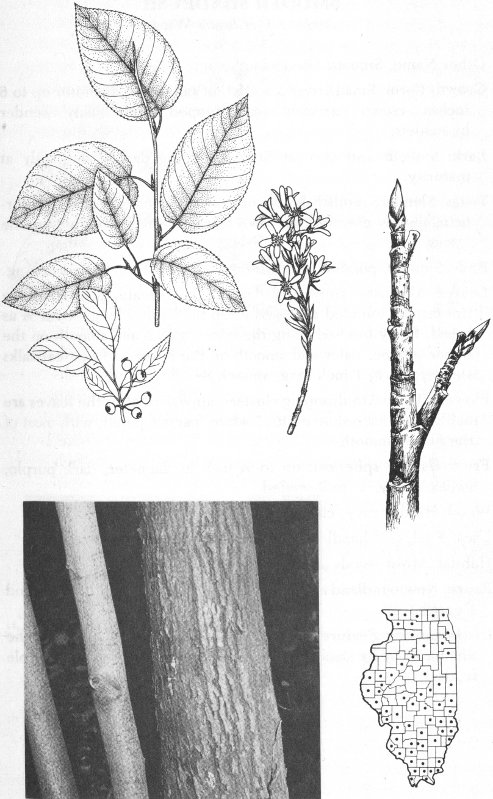
Other Name: Smooth Serviceberry.
Growth Form: Small tree up to 15 feet tall; trunk diameter up to 6 inches; crown narrowly round-topped, with many slender branchlets.
Bark: Smooth and gray at first, becoming darker and scaly at maturity.
Twigs: Slender, reddish-brown or grayish, smooth; leaf scars alternate, slightly elevated, narrowly crescent-shaped, with 3 bundle traces.
Buds: Slender, pointed, reddish-brown, smooth, up to ¾ inch long.
Leaves: Alternate, simple; blades elliptic to ovate, pointed at the tip, usually rounded at the base, up to 3 inches long, about ½ as broad, finely toothed along the edges, green and smooth on the upper surface, paler and smooth on the lower surface; leafstalks slender, up to 1 inch long, smooth.
Flowers: Up to 6 in drooping clusters, appearing after the leaves are half grown, each showy with 5 white, narrow petals, with most of the flower smooth.
Fruit: Usually spherical, up to ¼ inch in diameter, dark purple, sweet, fleshy, 1- to 2-seeded.
Wood: Hard, heavy, close-grained, dark brown.
Uses: Fuel, tool handles; the fruits are edible.
Habitat: Moist woods and slopes.
Range: Newfoundland across to Ontario, south to Iowa, Illinois, and Georgia.
Distinguishing Features: The Smooth Shadbush differs from the Shadbush by its smooth leafstalks and juicy, edible, dark purple fruits.
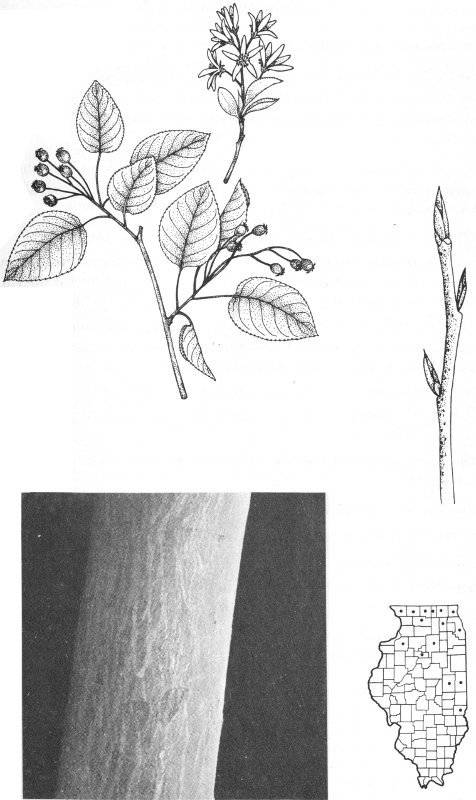
Other Name: Devil’s Walking-stick.
Growth Form: Small tree to 30 feet tall; trunk diameter up to 6 inches; crown widely spreading.
Bark: Dark brown, roughened, shallowly furrowed, with short, hard prickles.
Twigs: Stout, pale brown or gray, smooth except for many short, hard prickles; leaf scars alternate, broadly U-shaped, with about 15 bundle traces.
Buds: Cone-shaped, brown, smooth, up to ½ inch long.
Leaves: Alternate, doubly or triply pinnately compound, with very numerous leaflets; leaflets ovate to lance-ovate, pointed at the tip, tapering to rounded at the base, up to 3 inches long, about half as wide, coarsely toothed along the edges, green and smooth on the upper surface, paler and smooth on the lower surface, except usually for a few prickles along the veins.
Flowers: Numerous, in many umbrella-shaped clusters, appearing during late June and July, each with 5 small white petals and purple stalks.
Fruit: Black, spherical berries up to ⅛ inch in diameter, containing 2-5 seeds.
Wood: Light in weight, soft, brittle, close-grained, pale brown.
Use: Hercules’ Club is sometimes grown as an ornamental.
Habitat: Rich woods.
Range: New Jersey across to Iowa, south to Texas, east to Florida.
Distinguishing Features: The clusters of flowers and the leaves each may be as much as 4 feet long. The short, sharp prickles of the twigs are distinctive.
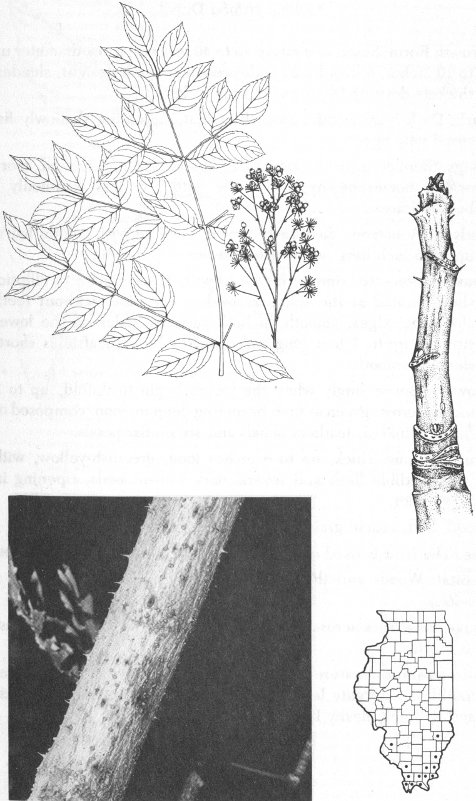
Growth Form: Small tree rarely up to 40 feet tall; trunk diameter up to 10 inches; crown broad and spreading; trunk straight, slender; thickets develop by means of root suckers.
Bark: Dark brown, thin, smooth at first, becoming shallowly fissured with age.
Twigs: Slender, smooth, gray; leaf scars alternate, 2-ranked, more or less horseshoe-shaped, usually with 5 or less commonly 7 bundle traces.
Buds: Very narrow, dark rusty-brown, covered with golden hairs, up to ⅔ inch long, without bud scales.
Leaves: Alternate, simple; blades broadly lance-shaped to elliptic, short-pointed at the tip, narrowed to the base, without teeth along the edges, smooth on both surfaces, paler on the lower surface, up to 1 foot long and 6 inches broad; leafstalks short, slender, smooth.
Flowers: Borne singly when the leaves begin to unfold, up to 2 inches across, green at first, becoming deep maroon, composed of three wrinkled, leathery sepals and six similar petals.
Fruit: Oblong, thick, up to 6 inches long, greenish-yellow, with yellow edible flesh and several dark brown seeds, ripening in September.
Wood: Soft, coarse-grained, light in weight, greenish-yellow.
Use: The fruit is used as a source of food; the wood has few uses.
Habitat: Woods and thickets, often many growing together in a colony.
Range: New York across to Michigan and Iowa, south to Texas, east to Florida.
Distinguishing Features: Pawpaw is distinguished by its large, toothless, alternate leaves, its slender buds without bud scales, and its thick, fleshy fruits.
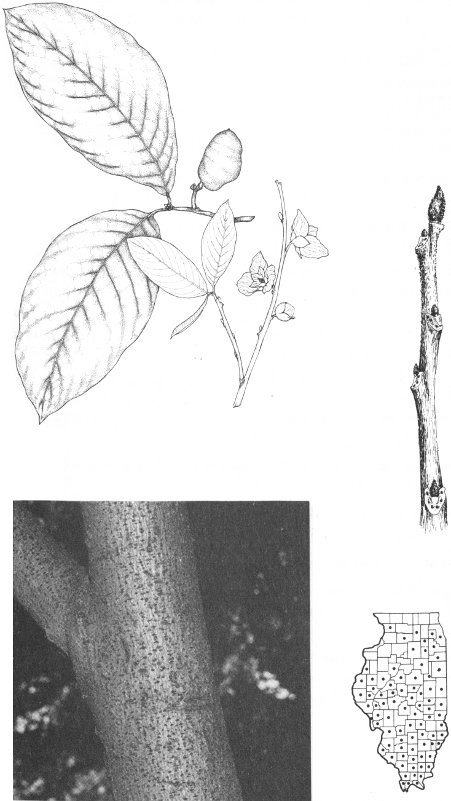
Other Name: Gray Birch.
Growth Form: Moderate tree up to 50 feet tall; trunk diameter up to 1½ feet; crown broadly rounded, with small branches.
Bark: Smooth and silvery or grayish, curling into strips, very rough when old.
Twigs: Slender, greenish-brown, smooth, with numerous lenticels; leaf scars alternate, half-elliptical, with 3 bundle traces.
Buds: Pointed, brown, usually somewhat hairy, up to ⅙ inch long.
Leaves: Alternate, simple; blades ovate, pointed at the tip, more or less rounded at the somewhat asymmetrical base, up to 5 inches long, and nearly half as wide, double-toothed, dark green and nearly smooth on the upper surface, paler and usually somewhat hairy on the lower surface; leafstalks yellow, hairy, up to one inch long. The leaves turn yellow in the autumn.
Flowers: Staminate and pistillate flowers borne separately but on the same tree, the staminate crowded in elongated clusters, the pistillate crowded in shorter, thicker clusters, appearing after the leaves have begun to unfold.
Fruit: Several winged nuts, crowded together in erect “cones” up to 1½ inches long.
Wood: Heavy, hard, strong, pale brown.
Uses: Furniture, flooring, boxes.
Habitat: Wooded slopes.
Range: Newfoundland across to Manitoba, south to Iowa, northern Illinois, northern Indiana, Ohio, and Delaware; also in the Appalachian Mountains to Georgia.
Distinguishing Features: The Yellow Birch differs from all other birches in Illinois by its silvery or grayish bark and its ovate leaves. The bark has the faint fragrance of wintergreen.

Other Name: Red Birch.
Growth Form: Up to 75 feet tall; trunk diameter up to 2 feet; crown irregularly rounded.
Bark: Curling, shredding, brownish-pink to reddish-brown.
Twigs: Slender, reddish-brown, with several short hairs; leaf scars alternate, half-elliptical, with 3 bundle traces.
Buds: Up to one-fourth inch long, pointed, hairy.
Leaves: Alternate, simple; blades rhombic to ovate, coarsely doubly toothed, paler and densely hairy on the lower surface, up to 3 inches long, acute at the tip, truncate or tapering to the base, the leafstalks woolly.
Flowers: Staminate and pistillate on same tree, inconspicuous, opening in late April and May, the staminate in slender drooping clusters, the pistillate in short, conelike, woolly clusters.
Fruit: Tiny, hairy nuts, each with a 3-lobed wing, crowded together in a cylindrical cone up to 1½ inches long and ½ inch thick.
Wood: Strong but light, pale brown.
Uses: Wood is used for furniture; sometimes planted as an ornamental.
Habitat: Along rivers and streams; bottomland woods.
Range: Massachusetts and New Hampshire across to southern Minnesota and eastern Kansas, south to eastern Texas and Florida.
Distinguishing Features: The shaggy, peeling reddish-brown bark readily distinguishes this tree from any other in Illinois, as does its rhombic, doubly toothed leaves.
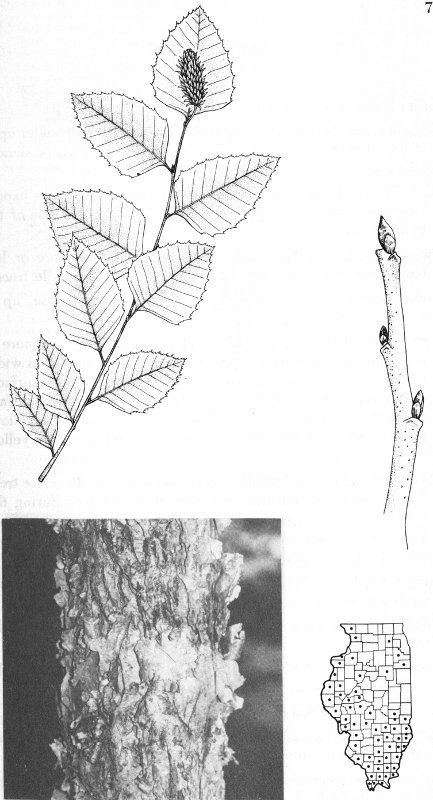
Other Name: Canoe Birch.
Growth Form: Medium tree up to 70 feet tall; trunk diameter up to 2 feet; crown broadly rounded, irregular, with many slender branches.
Bark: Thin and white or creamy, splitting at maturity into papery layers, becoming very dark and furrowed near the base of the trunk at maturity.
Twigs: Slender, zigzag, reddish-brown to blackish, more or less hairy; leaf scars alternate, half-elliptical, with 3 bundle traces.
Buds: Slender, pointed, dark brown, smooth or nearly so, up to one-fourth inch long.
Leaves: Alternate, simple; blades ovate, pointed at the tip, more or less rounded at the base, up to 3 inches long, over half as wide, coarsely toothed, dark green and smooth on the upper surface, yellow-green and smooth or somewhat hairy on the lower surface and with black dots on the lower surface; leafstalks yellow, smooth or finely hairy, up to 1 inch long. The leaves turn yellow in the autumn.
Flowers: Staminate and pistillate borne separately on the same tree, developing in the autumn and present on the tree during the winter, the staminate crowded into slender spikes up to 4 inches long, the pistillate crowded into thicker spikes up to 1¼ inches long, the flowers minute, without petals.
Fruit: Cone-like, cylindrical, drooping, composed of many minute seeds attached to 3-lobed wings.
Wood: Light in weight, hard, strong, durable, close-grained, light reddish-brown.
Uses: Bark used to cover canoes; wood used for pulp, fuel, toothpicks, and spools; sometimes grown as an ornamental.
Habitat: Rich, wooded slopes and stream banks.
Range: Labrador across to Alaska, south to Montana, Colorado, northern Illinois, and West Virginia.
Distinguishing Features: The Paper Birch is readily distinguished by its white bark which peels off into thin, papery layers.
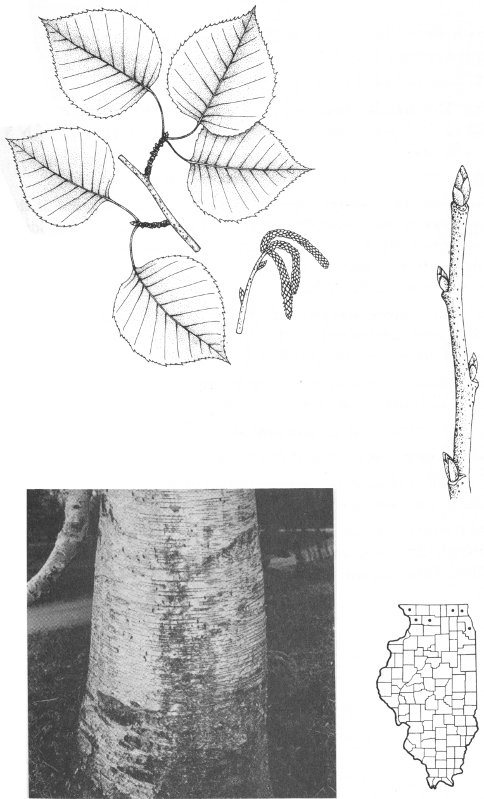
Growth Form: Small tree to 20 feet tall; trunk diameter up to 8 inches; crown rounded.
Bark: Gray or light brown, smooth.
Twigs: Moderately stout, greenish-gray, smooth or finely hairy, zigzag; leaf scars alternate, nearly spherical, elevated, with 5 bundle traces.
Buds: Cone-shaped, more or less smooth, up to 3 mm long.
Leaves: Alternate, simple; blades ovate, tapering to a point at the tip, more or less heart-shaped at the base, up to 8 inches long, sometimes nearly as broad, toothed, sometimes 2- or 3-lobed, usually rough-hairy on both surfaces; leafstalks up to 2 inches long, smooth or finely hairy.
Flowers: Staminate and pistillate flowers borne separately, on separate trees, appearing as the leaves unfold, the staminate in pendulous catkins, the pistillate in dense, hairy, spherical heads.
Fruit: Spherical, semi-fleshy, orange, up to 1 inch in diameter, with red fruits projecting.
Use: Often planted as an ornamental.
Habitat: Along roads, around old homes.
Range: Native of Asia; occasionally found along roads and in fencerows in the eastern United States.
Distinguishing Features: The leaves, some of which are 2- or 3-lobed, are very reminiscent of mulberry leaves. Mulberry leaves, however, are not densely rough-hairy.
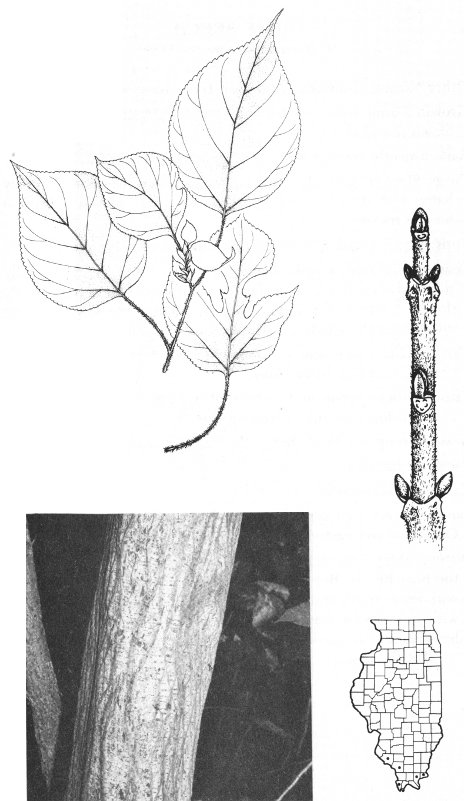
Other Names: Ironwood; American Hornbeam; Musclewood.
Growth Form: Up to 30 feet tall; trunk diameter up to 1½ feet; crown rounded.
Bark: Smooth, blue-gray, ridged, appearing “muscular.”
Twigs: Slender, difficult to break, reddish-brown, smooth or finely hairy; leaf scars alternate, crescent-shaped, elevated, with 3 bundle traces.
Buds: Small, angular, tapering to a short point.
Leaves: Alternate, simple; blades thin, pointed at the tip, usually rounded at the base, 2-4 inches long and about half as wide, finely doubly toothed, the upper surface smooth, the lower surface either smooth or hairy; leafstalks up to ½ inch long, hairy.
Flowers: Staminate and pistillate on same tree but in different catkins, opening during May.
Fruit: Nutlets borne at the base of a three-lobed green “leaf,” crowded together into a fruiting cluster.
Wood: Strong and hard, hence the name Ironwood.
Use: Tool handles.
Habitat: Moist woods.
Range: Nova Scotia across to central Minnesota, south to eastern Oklahoma and eastern Texas, east to central Florida.
Distinguishing Features: Several other trees may be confused with the Blue Beech. Beech, which has smooth gray bark, has leaves with fewer teeth and twigs with pointed buds. Hop Hornbeam, with very similar leaves, has a flaky bark. The elms, which also have somewhat similar leaves, usually have the leaves asymmetrical at the base.
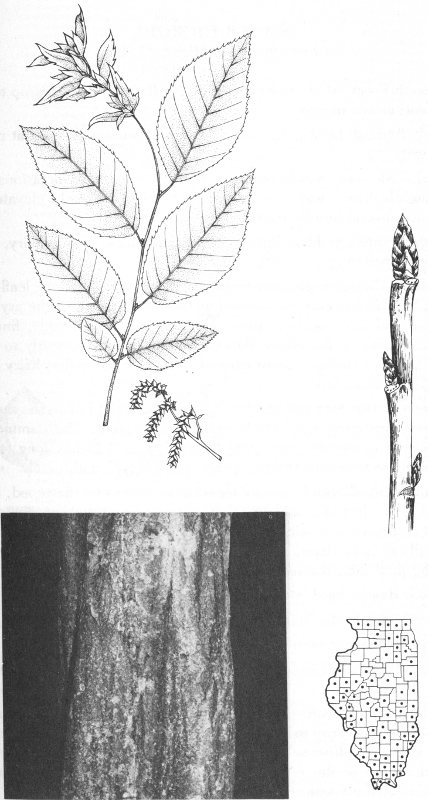
Growth Form: Medium tree to 75 feet tall; trunk diameter up to 2 feet; crown narrow.
Bark: Reddish-brown, furrowed, becoming somewhat scaly at maturity.
Twigs: Slender, reddish-brown or gray, smooth or occasionally slightly hairy; leaf scars alternate, 3-lobed, scarcely elevated, with several bundle traces.
Buds: Pointed, reddish-brown with yellow scales, usually hairy, up to ¼ inch long.
Leaves: Alternate, pinnately compound, with 7-17 leaflets; leaflets lance-shaped, curved, pointed at the tip, tapering to the asymmetrical base, up to 5 inches long, up to 2 inches wide, finely toothed along the edges, dark green and smooth or nearly so on the upper surface, brownish and smooth or somewhat hairy on the lower surface.
Flowers: Staminate and pistillate borne separately, but on the same tree, appearing when the leaves are partly grown, the staminate several in slender, drooping catkins up to 3 inches long, the pistillate fewer, in shorter spikes, neither type with petals.
Fruit: Short-ellipsoid, usually tapering to either end, flattened, up to 1½ inches long and two-thirds as broad, the husk 4-winged, dark brown but with yellow scales, thin, splitting only about halfway to the base, the nut flattened, 4-angled, reddish-brown, the shell thin, the seed bitter.
Wood: Heavy, hard, strong, close-grained, dark brown.
Uses: Fence posts, fuel.
Habitat: Swampy woods and drained floodplains.
Range: Virginia across to southeastern Missouri, south to Texas, east to Florida.
Distinguishing Features: Water Hickory is similar to Pecan and Bitternut Hickory in having 7 or more leaflets per leaf. However, it lacks the yellow buds of the Bitternut Hickory and the slender, edible nut of the Pecan. The leaves are generally hairier than those of the Pecan.
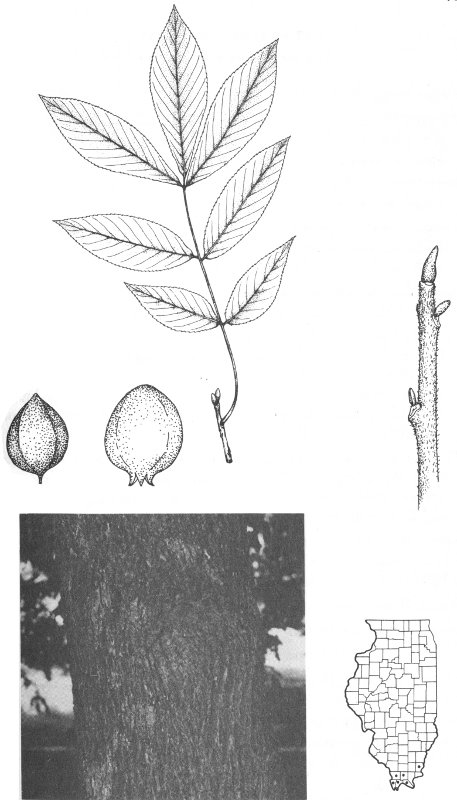
Other Name: Yellow-bud Hickory.
Growth Form: Medium tree up to 75 feet tall; trunk diameter up to 2½ feet; crown broadly rounded and often irregular; trunk straight, columnar.
Bark: Brown, thin, separating into small, platy scales or shallow ridges and fissures.
Twigs: Slender, grayish or orange-brown, smooth, usually with lenticels; leaf scars alternate, shield-shaped, scarcely elevated, with usually several bundle traces.
Buds: Narrow, slender, pointed, covered by a dense, bright yellow coat of glandular dots and small hairs, up to ¾ inch long.
Leaves: Alternate, pinnately compound, with usually 7-9 leaflets; leaflets lance-shaped, usually curved, long-pointed at the tip, tapering or rounded at the base, toothed along the edges, yellow-green and smooth on the upper surface, somewhat lighter and usually hairy on the lower surface, up to 6 inches long and usually less than half as wide.
Flowers: Staminate and pistillate borne separately, but on the same tree, appearing after the leaves have begun to unfold, minute, without petals, the staminate in slender, drooping catkins, the pistillate in groups of 1 or 2.
Fruit: More or less spherical, up to 1¼ inches in diameter, the husk thin, yellowish, with 4 distinct ridges extending about halfway down, the nut somewhat flattened, the seed very bitter.
Wood: Heavy, hard, strong, dark brown.
Uses: Fuel, fence posts.
Habitat: Bottomland woods; dry hills; along roads.
Range: Southern Ontario across to central Minnesota, south to eastern Texas, east to north-central Florida.
Distinguishing Features: Bitternut Hickory is easily recognized by its slender, mustard-yellow buds. It differs further from the Water Hickory by its rounded fruits.
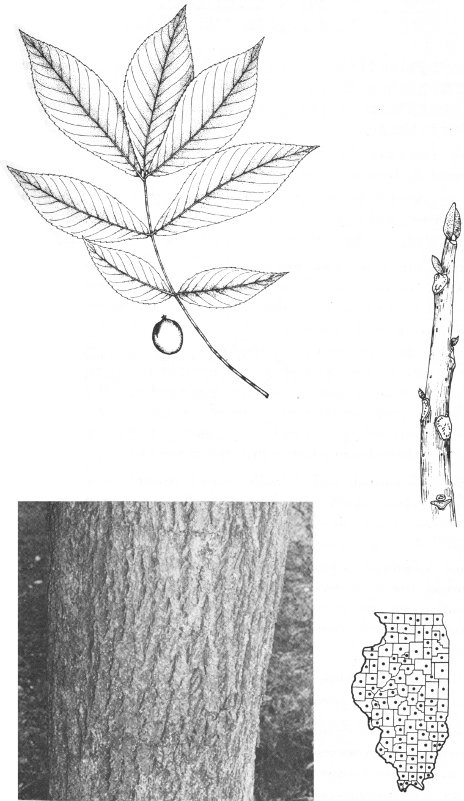
Growth Form: Medium tree up to 75 feet tall; trunk diameter up to 2 feet; crown oblong or obovoid, with many small, spreading branchlets; trunk straight, columnar, sometimes branching fairly low to the ground.
Bark: Light gray to black, not scaly or peeling off into shreds, at maturity furrowed and ridged.
Twigs: Slender, brown or gray, shiny, smooth, tough, usually with lenticels; leaf scars alternate, shield-shaped or 3-lobed, scarcely elevated, usually with several bundle traces.
Buds: More or less rounded but coming to a short point at the tip, tan or grayish, the outermost scales tipped with a few small hairs, never with small yellow dots, the inner scales hairy all along the edges, up to ½ inch long.
Leaves: Alternate, pinnately compound, with usually 5, sometimes 7 leaflets; leaflets lance-shaped, pointed at the tip, tapering at the bottom, toothed along the edges, green and smooth on the upper surface, green and smooth or sometimes hairy on the veins on the lower surface, up to 5 inches long and up to 2 inches broad, the upper three leaflets larger than the lower two.
Flowers: Staminate and pistillate borne separately, but on the same tree, appearing after the leaves have begun to expand, minute, without petals, the staminate in slender, drooping catkins, the pistillate in groups of 1-3.
Fruit: Spherical to pear-shaped, up to 1 inch long, not quite as broad, the husks thin, greenish, usually not splitting all the way to the base, the nut somewhat compressed and with a very hard shell, the seed sweet. Occasional trees have fruits up to 2 inches long.
Wood: Heavy, strong, hard, brown.
Uses: Fuel, fence posts, tool handles.
Habitat: Wooded slopes and ridges.
Range: Vermont across to southern Michigan and northern Illinois, south across Missouri to eastern Texas, east to central Florida.
Distinguishing Features: Pignut Hickory is best recognized by its rather small leaflets which usually are five in number, the tight bark, and the characteristic pear-shaped fruits.
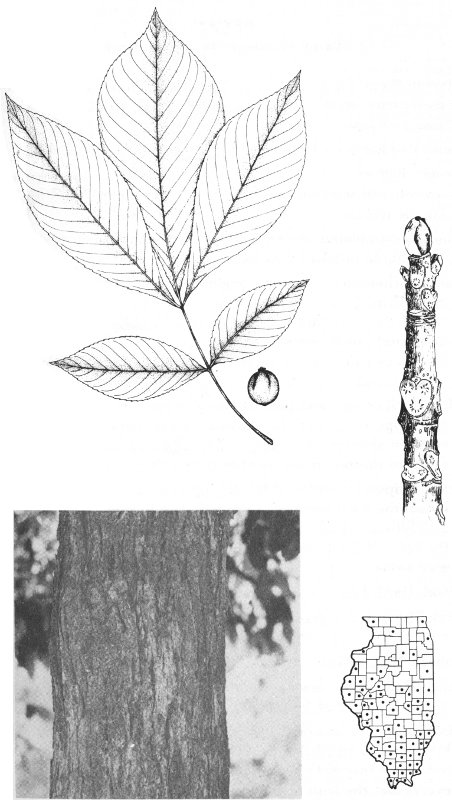
Growth Form: Large tree up to 150 feet tall; trunk diameter up to 3 feet; crown widely spreading and rounded; trunk rather short, stout, straight.
Bark: Reddish-brown, becoming roughened into platy scales.
Twigs: Rather stout, brown, hairy when young, but becoming smooth; leaf scars alternate, 3-lobed, scarcely elevated, with 3-18 bundle traces.
Buds: Long-pointed, covered with yellow glandular dots and fine hairs, up to one-half inch long.
Leaves: Alternate, pinnately compound, with 9-19 leaflets; leaflets lance-shaped, curved, long-pointed at the tip, rounded or tapering to the asymmetrical base, finely doubly-toothed, yellow-green and usually smooth on the upper surface, paler and either smooth or hairy on the lower surface, up to 8 inches long and 3 inches broad.
Flowers: Staminate and pistillate borne separately, but on the same tree, appearing when the leaves are partly grown, the staminate many in slender, drooping, yellow-green catkins, the pistillate fewer in shorter spikes, neither type with petals.
Fruit: Ellipsoid, pointed at the tip, up to 2 inches long and 1 inch broad, the husk narrowly 4-winged, dark brown but with yellow scales, thin, usually splitting nearly to the base, the nut pointed at the tip, reddish-brown with black markings, the shell thin, the seed sweet.
Wood: Hard, heavy, coarse-grained, light reddish-brown.
Uses: The nuts are prized for their tastiness; the wood is used for interior finishing, furniture, fuel, and tool handles.
Habitat: Moist woods, particularly along rivers.
Range: Indiana to Iowa, south through southeastern Kansas to eastern Texas, east to Alabama; Mexico.
Distinguishing Features: The Pecan differs from all other hickories by its greater number of leaflets. The Black Walnut and Butternut, which may have as many leaflets, have a partitioned pith. In every case, the fruit of the Pecan is distinctive.
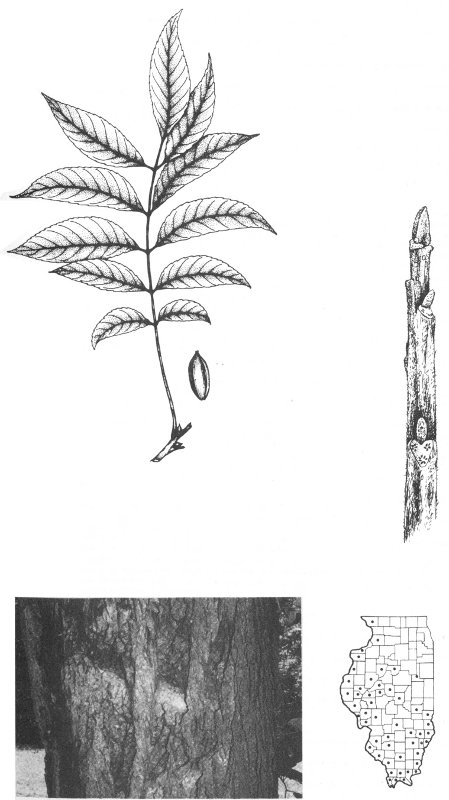
Other Names: Big Shellbark Hickory; Riverbank Hickory.
Growth Form: Large tree up to 100 feet tall; trunk diameter up to 3 feet; crown oblong to ovoid, with drooping lower branches; trunk straight, columnar, stout.
Bark: Light gray, soon separating into long, thick, vertical plates which curve away from the trunk.
Twigs: Stout, gray or brown, conspicuously dotted with orange lenticels; leaf scars alternate, shield-shaped or 3-lobed, not elevated, usually with several bundle traces.
Buds: Elongated, dark brown, hairy, up to ¾ inch long, the outer scales with a long, stiff point.
Leaves: Alternate, pinnately compound, with 5-9 leaflets; leaflets lance-shaped to ovate, pointed at the tip, tapering or rounded at the base, finely toothed along the edges, dark green and mostly smooth on the upper surface, paler and softly hairy on the lower surface, up to 10 inches long and up to half as wide.
Flowers: Staminate and pistillate borne separately, but on the same tree, appearing after the leaves have begun to unfold, minute, without petals, the staminate in slender, drooping catkins, the pistillate in clusters of 2-5.
Fruit: Spherical, often depressed at the top, up to 2¼ inches across, the husk divided all the way to the base into four sections, minutely orange-speckled and sometimes hairy, the nut with conspicuous ridges, the seed very sweet.
Wood: Heavy, hard, close-grained, dark brown.
Uses: Wood is used for tool handles and fuel; nuts are sold commercially because of their edible qualities.
Habitat: Rich bottomlands.
Range: Southwestern Pennsylvania and southern Michigan across to central Illinois and southern Iowa, south to northeastern Oklahoma, Arkansas, and eastern Tennessee; also in scattered areas of New York, Virginia, North Carolina, Georgia, Alabama, and Mississippi.
Distinguishing Features: The shaggy bark and large leaflets resemble those of the Shagbark Hickory, but the Kingnut Hickory has orange-dotted twigs and usually seven leaflets which lack minute tufts of hairs at the tip of each tooth.
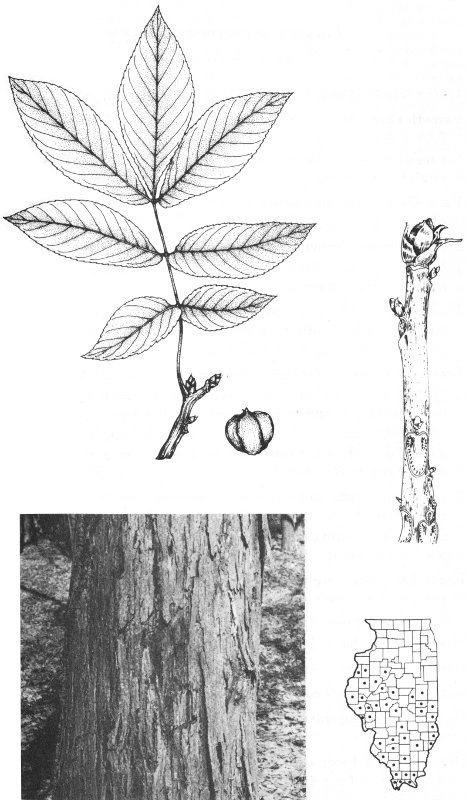
Other Names: False Shagbark Hickory; Small-fruited Hickory.
Growth Form: Medium to large tree up to 80 feet tall; trunk up to 2 feet in diameter; crown oblong or broadly rounded, with upright, spreading upper branches and drooping lower branches; trunk straight, columnar.
Bark: Gray, tight and rather smooth when young, usually peeling off into narrow plates at maturity.
Twigs: Slender, brown or gray, tough, smooth, usually with lenticels; leaf scars alternate, 3-lobed, not elevated, usually with several bundle traces.
Buds: More or less rounded but coming to a short point at the tip, tan or grayish, usually minutely yellow-dotted, the scales hairy all along the edges up to ⅔ inch long.
Leaves: Alternate, pinnately compound, with usually 7, sometimes 5, leaflets; leaflets lance-shaped sometimes curved, pointed at the tip, tapering or somewhat rounded at the base, finely toothed along the edges, green and smooth on the upper surface, minutely dotted and sometimes with some hairs on the lower surface, up to 6 inches long, up to 2 inches broad.
Flowers: Staminate and pistillate borne separately, but on the same tree, after the leaves have begun to unfold, minute, without petals, the staminate crowded in slender, drooping catkins, the pistillate in groups of 1-2.
Fruit: Ellipsoid, rarely spherical, up to 1¼ inch long, the husk green and minutely warty, thin, splitting all the way to the base, the nut somewhat 4-angled, the seed sweet.
Wood: Heavy, hard, brown.
Uses: Tool handles, fuel.
Habitat: Wooded slopes.
Range: New Hampshire across to Wisconsin, south to Arkansas, east to Georgia.
Distinguishing Features: This Hickory cannot always be reliably distinguished from the Pignut Hickory. However, it usually has a somewhat scaly bark, seven leaflets, minutely yellow-dotted buds, and fruits which split all the way to the base.

Growth Form: Medium to large tree up to 80 feet tall; trunk diameter up to 3½ feet; crown rounded, with some of the branches often hanging.
Bark: Gray, separating into long, shreddy scales giving the trunk a shaggy appearance.
Twigs: Stout, reddish-brown to gray, smooth or somewhat hairy; leaf scars alternate, 3-lobed, not elevated, with several bundle traces.
Buds: Ovoid, rounded or short-pointed at the tip, up to 1 inch long, hairy, the scales conspicuously yellow-green or reddish as they unfold in the spring.
Leaves: Alternate, pinnately compound, with 5-7 leaflets; leaflets ovate, obovate, or less commonly lance-shaped, usually short-pointed at the tip, tapering to the base, up to 10 inches long, up to 5 inches wide, finely toothed along the edges, with the tip of each tooth with a minute tuft of hairs, green or yellow-green and smooth on the upper surface, paler and smooth or somewhat hairy on the lower surface.
Flowers: Staminate and pistillate borne separately, but on the same tree, appearing after the leaves have begun to unfold, minute, without petals, the staminate crowded in slender, drooping catkins, the pistillate in groups of 2-5.
Fruit: Spherical or occasionally punching-bag shaped, up to 2 inches across, the husk yellow-green to reddish-brown, up to ½ inch thick, splitting all the way to the base, the nut 4-angled, nearly white, the seed sweet.
Wood: Heavy, hard, light brown, close-grained.
Uses: Tool handles, fuel; the nuts are tasty.
Habitat: Low, shaded woods.
Range: Maine across to Minnesota, south to eastern Texas, east to Florida.
Distinguishing Features: The Shagbark Hickory is distinguished by its shaggy bark, its usually 5 large leaflets, and its large winter buds.
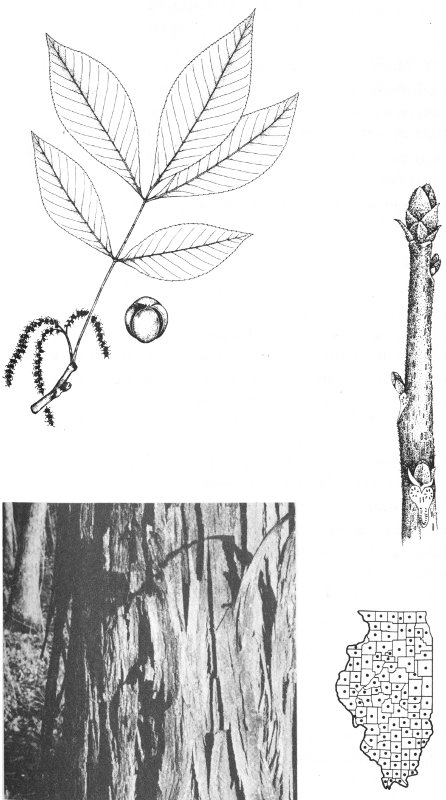
Other Names: Red Hickory; Texas Hickory; Buckley’s Hickory.
Growth Form: Small tree up to 25 feet tall; trunk diameter up to 1 foot; crown oblong to rounded, with numerous, small branchlets; trunk straight or somewhat crooked, slender but sturdy.
Bark: Brown to black, not scaly or peeling off into shreds, becoming somewhat furrowed and ridged at maturity.
Twigs: Slender, gray, tough, almost always smooth; leaf scars alternate, three-lobed, not elevated, usually with several bundle traces.
Buds: Ovoid, short-pointed, up to ½ inch long, covered by shiny silvery-golden scales and tipped with a small tuft of hairs.
Leaves: Alternate, pinnately compound, with 5-7 leaflets; leaflets lance-shaped, pointed at the tip, tapering to the base, finely toothed along the edges, dark green and smooth or sometimes hairy on the upper surface, paler and smooth or hairy on the lower surface, up to 6 inches long, less than half as wide, the stalks covered with reddish and yellowish scales and hairs.
Flowers: Staminate and pistillate borne separately, but on the same tree, appearing after the leaves have begun to unfold, minute, without petals, the staminate crowded in slender, drooping catkins, the pistillate in groups of 1-2.
Fruit: Spherical to ellipsoid, up to 1½ inches across, the husk yellow-green, thin, minutely hairy or scaly, splitting nearly to the base, the nut 4-angled, the seed sweet.
Wood: Heavy, hard, brown.
Uses: Fuel, fence posts.
Habitat: Dry ridges and cliffs.
Range: Southern Indiana across to Kansas, south to Texas and Louisiana.
Distinguishing Features: The Black Hickory differs from the somewhat similar Pignut and Sweet Pignut Hickories by the yellow scales along the leafstalks.
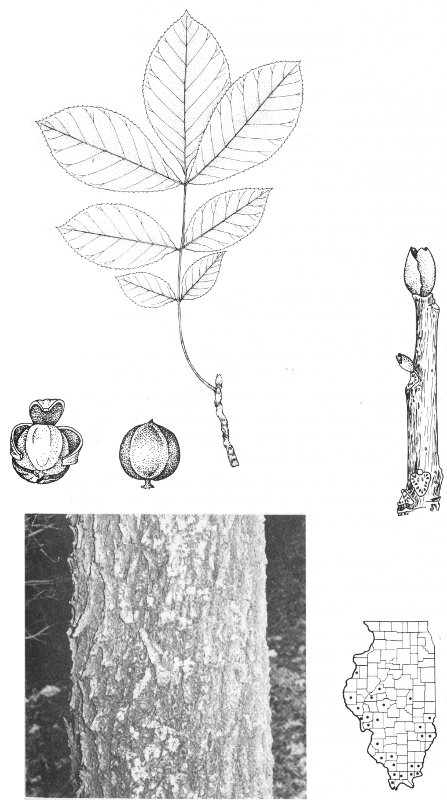
Other Name: White Hickory.
Growth Form: Medium or tall tree to 90 feet tall; trunk diameter up to 3 feet; crown rounded, the branchlets either erect or hanging.
Bark: Dark gray, shallowly furrowed, not scaly, often with a diamond-shaped pattern.
Twigs: Slender or relatively stout, usually hairy, gray; leaf scars alternate, 3-lobed, not elevated, with several bundle traces.
Buds: Ovoid, rounded or pointed at the tip, up to nearly 1 inch long, reddish-brown, hairy.
Leaves: Alternate, pinnately compound, with 5-9 leaflets; leaflets broadly lanceolate to oblanceolate, pointed at the tip, rounded or tapering to the base, up to 8 inches long, about half as wide, finely toothed along the edge, yellow-green and hairy on the upper surface, paler and hairy on the lower surface.
Flowers: Staminate and pistillate borne separately, but on the same tree, appearing after the leaves have begun to unfold, minute, without petals, the staminate crowded in slender, drooping catkins, the pistillate in groups of 2-5.
Fruit: Ellipsoid or obovoid or spherical, up to 2 inches across, the husk reddish-brown, up to ¼ inch thick, smooth or slightly hairy, the nut sometimes 4-angled, reddish-brown, the seed sweet but small.
Wood: Heavy, hard, strong, coarse-grained, dark brown.
Uses: Tool handles, fuel, fence posts.
Habitat: Dry wooded slopes; shaded woods.
Range: Massachusetts across to southern Ontario, south to eastern Texas, east to Florida.
Distinguishing Features: Mockernut Hickory is distinguished from all other Illinois hickories by its usually 7 or 9 hairy leaflets with hairy leafstalks and hairy twigs. The large fruits with the small seeds within, which may account for the common name, are also distinctive.
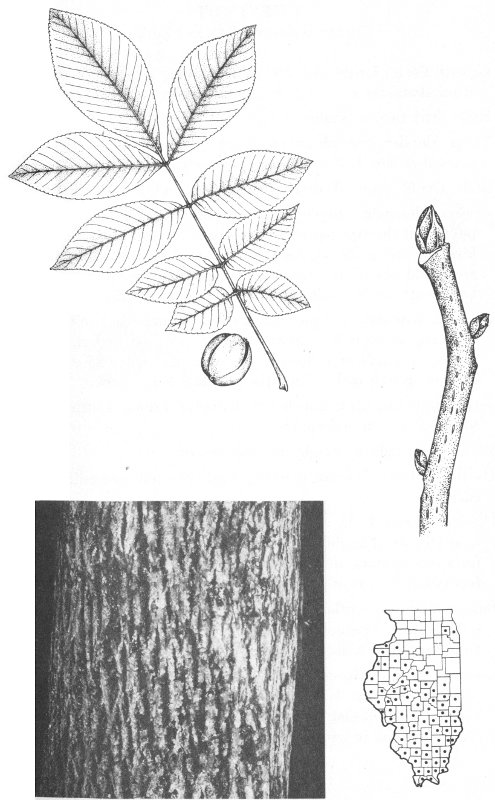
Growth Form: Large tree, formerly attaining a height of 100 feet; trunk diameter up to 3 feet; crown broadly rounded.
Bark: Dark brown, shallowly furrowed.
Twigs: Slender, reddish-brown, angular, glabrous or nearly so; leaf scars alternate, half-round, elevated, with several bundle traces.
Buds: Ovoid, pointed, up to ⅓ inch long, dark brown, smooth.
Leaves: Alternate, simple; blades lanceolate to oblong-lanceolate, pointed at the tip, tapering to the base, up to 8 inches long and less than half as broad, coarsely toothed along the edges, yellow-green and smooth on the upper surface, paler and smooth on the lower surface; leafstalks up to ½ inch long, usually finely hairy.
Flowers: Staminate and pistillate borne separately, but on the same tree, appearing in June after the leaves are fully grown, without petals, greenish or yellowish, the staminate many in elongated catkins up to 8 inches long, the pistillate 1-3 together.
Fruit: Spiny bur up to 2 inches in diameter, brown, splitting open to reveal 3 flattened nutlets.
Wood: Soft, light in weight, reddish-brown.
Uses: Furniture, interior finishing, fuel. The nuts are edible delicacies.
Habitat: Formerly in rocky woods, once occupying several acres near Olmstead in Pulaski County. Now virtually extinct, except for a few sprouts, due to a disease of the bark. A tree about 40 feet tall still exists near Little Grassy Lake in Williamson County.
Range: Maine to southern Ontario and southern Minnesota, south to Delaware, Kentucky, and southern Illinois, and in the mountains to central Alabama.
Distinguishing Features: In addition to its large, spiny fruits, the Chestnut can be distinguished by its sharply toothed leaves. Yellow Chestnut Oak may sometimes have similar leaves, but the pith of the oak is star-shaped.
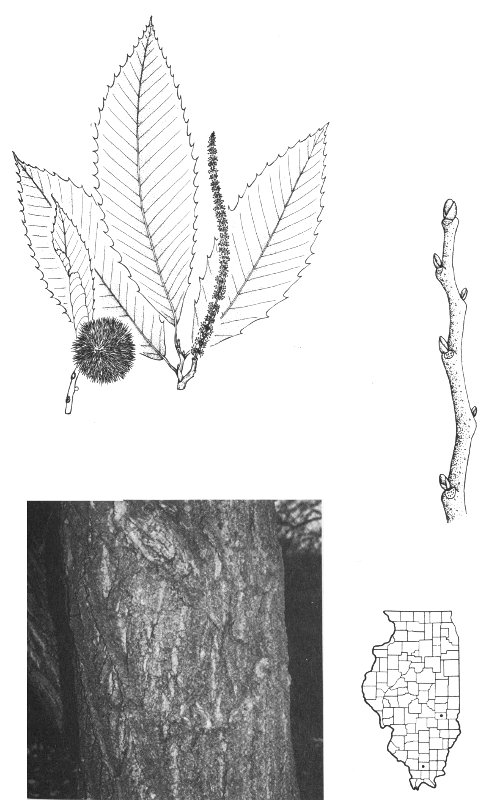
Other Names: Lady Cigar Tree; Indian Bean.
Growth Form: Short to medium tree up to 40 feet tall; trunk diameter up to 1 foot; crown broadly rounded.
Bark: Light brown, with thin, platy scales.
Twigs: Stout, smooth or slightly hairy, orange-brown to grayish, with conspicuous lenticels; leaf scars in whorls of 3, round-elliptic, elevated, with 12 or more bundle traces.
Buds: Round, reddish-brown, slightly hairy, very small.
Leaves: Whorled, simple; blades ovate, short-pointed at the tip, heart-shaped at the base, up to 8 inches long and about as broad, smooth along the edges, yellow-green and smooth on the upper surface, paler and finely hairy on the lower surface; leafstalks stout, smooth, up to 6 inches long.
Flowers: Large, showy, several in a large cluster, appearing in May and June, the clusters usually more than 6 inches long, each flower up to 2 inches long, the petals white and spotted with purple.
Fruit: Elongated capsules up to 1½ feet long and ½ inch thick, brown, splitting into 2 parts to reveal several winged, hairy seeds about 1 inch long.
Wood: Light in weight, soft, coarse-grained, pale brown.
Uses: Fence posts, railroad ties; ornamental.
Habitat: Along railroads, streams, in fields; planted elsewhere.
Range: Native from Texas to Georgia and Florida; widely planted elsewhere.
Distinguishing Features: The leaves of this species, when crushed, give off a very unpleasant aroma.
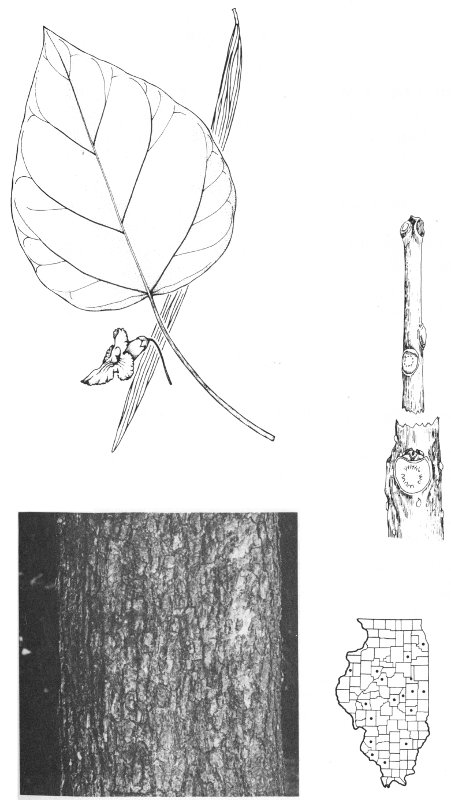
Other Names: Western Catalpa; Lady Cigar Tree; Indian Bean.
Growth Form: Medium tree up to 60 feet tall; trunk diameter up to 3 feet; crown broad, widely spreading.
Bark: Light brown, dark brown, or black, usually with rather deep furrows.
Twigs: Stout, smooth, brown, with conspicuous lenticels; leaf scars in whorls of 3, with one of the 3 scars smaller than the other 2, round-elliptic, elevated, with 12 or more bundle traces.
Buds: Round, brown to black, smooth, very small.
Leaves: Whorled, simple; blades ovate, long-pointed at the tip, heart-shaped at the base, up to 1 foot long and about ⅔ as broad, smooth along the edges, dark green and smooth or sparsely hairy on the upper surface, soft hairy on the lower surface; leafstalks stout, up to 6 inches long.
Flowers: Large, showy, several in an elongated cluster, appearing in May and June, the clusters up to six inches long, each flower up to 2½ inches long, the petals white and lined with purple.
Fruit: Elongated capsules up to 1½ feet long and ¾ inch thick, brown, splitting into 2 parts to reveal several winged, hairy seeds about 1 inch long.
Wood: Light in weight, soft, coarse-grained, pale brown.
Uses: Fence posts, interior finishing, railroad ties.
Habitat: Low woods; often planted in a variety of habitats.
Range: Southern Indiana, southern Illinois, and southern Missouri, south to Texas, Arkansas and Tennessee; commonly planted elsewhere.
Distinguishing Features: The two Catalpas in Illinois are hard to tell apart. This one usually has deeply furrowed bark, shorter clusters of flowers, petals merely lined with purple rather than spotted, and leaves which are not unpleasantly scented when crushed.
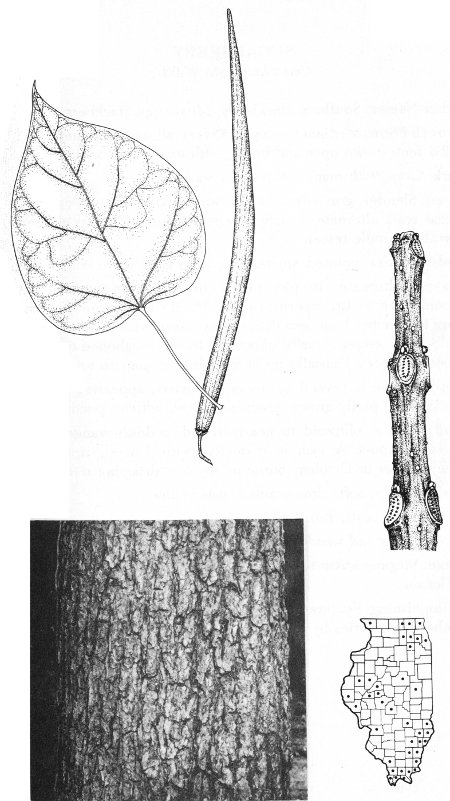
Other Names: Southern Hackberry; Mississippi Hackberry.
Growth Form: Medium tree up to 75 feet tall; trunk diameter up to 2½ feet; crown open and broad, with drooping branches.
Bark: Gray, with many conspicuous warts.
Twigs: Slender, gray or reddish-brown, smooth, sometimes zigzag; leaf scars alternate, usually crescent-shaped, slightly elevated, with 3 bundle traces.
Buds: Slender, pointed, smooth, brown or gray, up to ⅛ inch long.
Leaves: Alternate, simple; blades usually lance-shaped, long-pointed at the tip, tapering or rounded at the asymmetrical base, up to 6 inches long, less than half as broad, with few or no teeth along the edges, usually smooth or barely roughened on one or both surfaces; leafstalks up to ½ inch long, smooth or hairy.
Flowers: One to several in drooping clusters, appearing after the leaves are partly grown, greenish-yellow, without petals.
Fruit: Fleshy, ellipsoid to nearly round, reddish-orange to yellowish, about ¼ inch in diameter, with 1 seed, ripening in September or October, borne on slender, drooping stalks.
Wood: Heavy, soft, close-grained, pale yellow.
Uses: Fence posts, furniture.
Habitat: Lowland woods to dry hilltops.
Range: Virginia across to southern Missouri, south to Texas, east to Florida.
Distinguishing Features: The Sugarberry differs generally from other hackberries by its narrower, mostly toothless leaves.
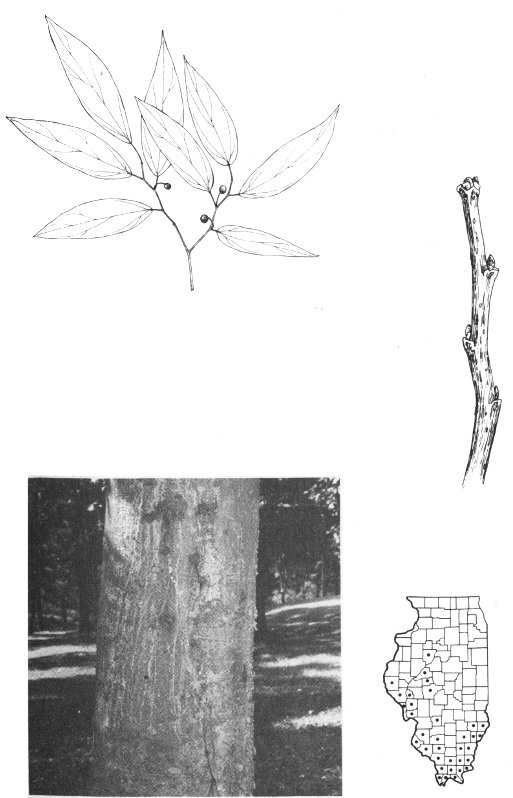
Other Name: Sugarberry.
Growth Form: Medium or large tree up to 80 feet tall; trunk diameter up to 5 feet; crown usually oblong, with many small branchlets.
Bark: Gray, smooth on young trees and soon bearing “warts,” becoming rough and scaly on old trees.
Twigs: Slender, gray to reddish-brown, smooth, sometimes zigzag; leaf scars alternate, usually crescent-shaped, with 3 bundle traces.
Buds: Slender, oval, pointed, brown or gray, finely hairy, about ¼ inch long.
Leaves: Alternate, simple; blades ovate or broadly lance-shaped, long-pointed at the tip, rounded or tapering at the asymmetrical base, up to 6 inches long and up to half as broad, usually coarsely toothed along the edges except sometimes near the base, smooth or more often rough-hairy on one or both surfaces; leafstalks up to 1 inch long, smooth or hairy.
Flowers: Arranged in drooping clusters, or sometimes solitary, appearing after the leaves are partly grown, greenish-yellow, without petals.
Fruit: Fleshy, nearly round, dark purple, about ⅓ inch in diameter, with 1 seed, ripening in September and October, borne on slender, drooping stalks.
Wood: Heavy, soft, close-grained, pale yellow.
Uses: Fence posts, furniture.
Habitat: Low woodlands.
Range: Massachusetts across to Manitoba and South Dakota, southern Oklahoma, Alabama, and Virginia.
Distinguishing Features: Hackberry leaves resemble those of some elms, but have 3 main veins arising from the base of the blade. This Hackberry differs from other hackberries in Illinois by its larger, usually coarsely toothed leaves and its larger, dark purple fruits.
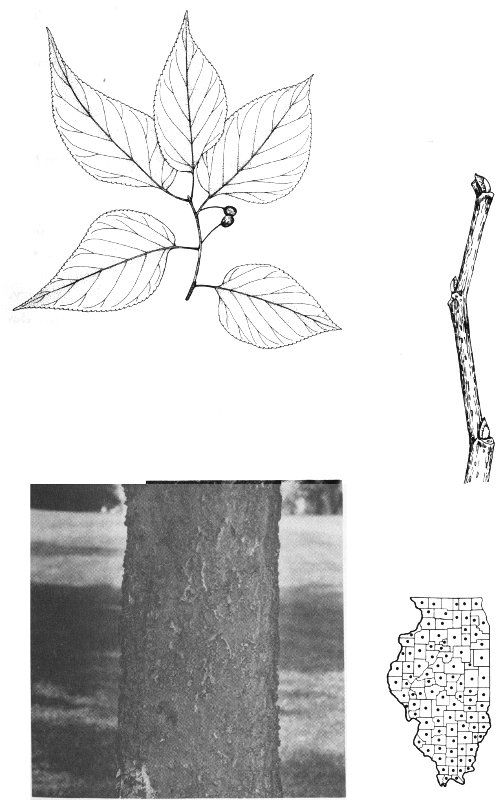
Growth Form: Small tree to 25 feet tall; trunk diameter up to 10 inches; crown irregular, with numerous slender branchlets.
Bark: Gray, smooth on young trees and soon bearing “warts,” becoming rough and scaly on old trees.
Twigs: Slender, green to reddish-brown, smooth at maturity; leaf scars alternate, crescent-shaped, with 3 bundle traces.
Buds: Slender, oval, pointed, grayish-brown, finely hairy, up to ⅛ inch long.
Leaves: Alternate, simple; blades ovate, pointed at the tip, rounded or somewhat heart-shaped at the base, up to 3 inches long, often at least half as broad, with a few coarse teeth along the edges, or sometimes lacking teeth, often leathery, smooth or hairy on one or both surfaces; leafstalks up to ½ inch long, smooth or hairy.
Flowers: One or a few in drooping clusters, appearing after the leaves are partly grown, finely hairy, greenish-yellow, without petals.
Fruit: Fleshy, spherical, reddish-purple, up to ½ inch in diameter, 1-seeded, ripening September and October.
Wood: Heavy, close-grained, yellowish.
Use: Fence posts.
Habitat: Edge of bluffs, woods.
Range: New Jersey across to Illinois and Kansas, south to Oklahoma, Louisiana, and northern Florida.
Distinguishing Features: This small tree is extremely variable in that its leaves may or may not have teeth, they may or may not be hairy, and they may or may not be leathery. It differs from the Sugarberry primarily by its broader leaves and from the Common Hackberry by its smaller fruits and usually less-toothed leaves.
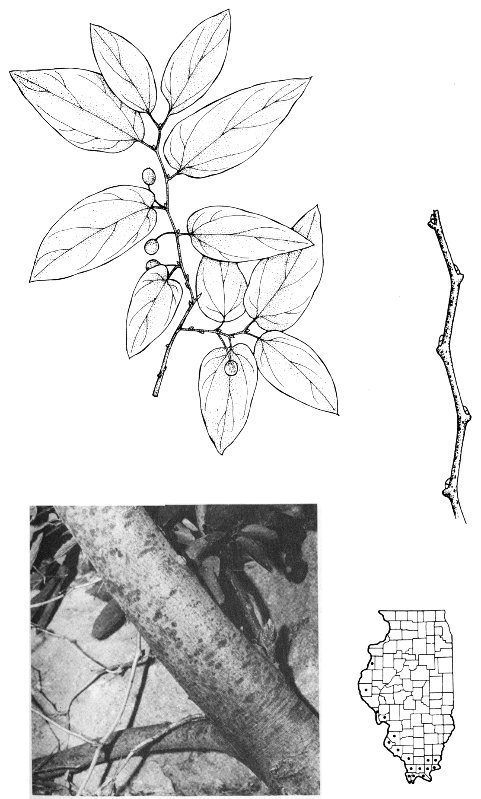
Growth Form: Small tree to 35 feet tall; trunk diameter up to 1 foot; crown usually broad and flattened.
Bark: Reddish-brown, separating into long plates and thin scales.
Twigs: Slender, zigzag, smooth, angular, brown; leaf scars alternate, somewhat elevated, triangular, hairy across the top, with 3 bundle traces.
Buds: Small, rounded, chestnut-brown, smooth or nearly so.
Leaves: Alternate, simple; blades heart-shaped, contracted to a short point at the tip, up to 6 inches long and nearly as broad, smooth on the upper surface, smooth or with some hairs on the lower surface, without teeth along the edges; leafstalks slender, up to 5 inches long, usually smooth.
Flowers: In small clusters on last year’s branches or on the trunks, rose-purple, each pea-shaped, about ½ inch long, appearing when the leaves are first beginning to unfold.
Fruit: Legumes up to 4 inches long and ½ inch broad, flat, smooth, brown at maturity, with several seeds.
Wood: Hard, heavy, close-grained, dark reddish-brown.
Use: The major importance of this small tree lies in its value as an ornamental, because of its spectacular appearance when in flower.
Habitat: Rich woods.
Range: Connecticut across to southern Wisconsin, south to Texas, east to northern Florida; also Mexico.
Distinguishing Features: The heart-shaped, toothless leaves easily identify this tree.

Growth Form: Small to medium tree to 45 feet tall; trunk diameter up to 14 inches; crown widely spreading.
Bark: Gray, smooth.
Twigs: Slender, reddish-brown, with some lenticels, somewhat zigzag; leaf scars alternate, narrow and completely encircling the bud, with 3-7 bundle traces.
Buds: Three or four crowded together, resembling at first a single bud, hairy, without scales, covered at first by the hollow base of the leafstalk.
Leaves: Alternate, pinnately compound, with 7-11 leaflets; leaflets oval, pointed at the tip, tapering to the base, up to 4 inches long and up to half as wide, smooth on both surfaces, toothless along the edges. The leaflets turn yellow in the autumn.
Flowers: In long, drooping clusters up to 1 foot long, white, slightly fragrant, appearing during June.
Fruit: Legumes up to 4 inches long and about ½ inch wide, flat, smooth, pale brown, with 4-6 seeds.
Wood: Hard, heavy, strong, close-grained, yellow to light brown.
Uses: Fuel. In olden days, a yellow dye was extracted from this tree.
Habitat: Rich, wooded slopes.
Range: North Carolina across to southern Missouri and Arkansas, south to northern Alabama and northern Georgia.
Distinguishing Features: The large, pinnately compound leaflets and the smooth, gray trunk distinguish this tree.
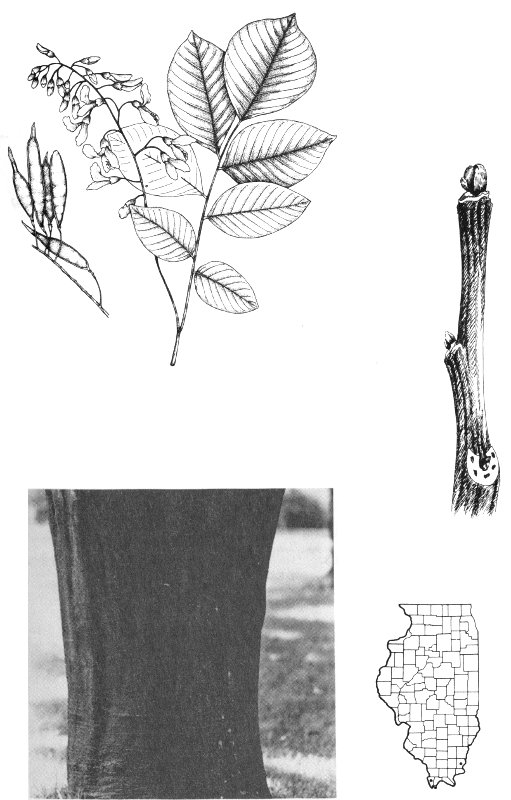
Growth Form: Small tree to 20 feet tall; trunk diameter up to 3 inches; crown flattened.
Bark: Brown, slightly roughened, with shallow furrows.
Twigs: Slender, reddish-brown or greenish, smooth; leaf scars alternate, crescent-shaped, somewhat elevated, with 3 bundle traces.
Buds: Narrowly ovoid, pointed, smooth, up to ¼ inch long.
Leaves: Alternate, although often clustered toward the tip of the twig, simple; blades oval to ovate, pointed at the tip, tapering or rounded at the base, up to 5 inches long, about half as broad, the edges smooth or finely round-toothed, green and mostly smooth on the upper surface, paler and frequently hairy on the lower surface; leafstalks up to 2 inches long, usually finely hairy.
Flowers: Several in crowded round-topped clusters, appearing in May and June, each flower white, with 4 narrow petals.
Fruit: Blue, spherical berries up to ⅓ inch in diameter, borne on a red stalk.
Wood: Heavy, hard, close-grained, brown.
Use: Tool handles.
Habitat: Rich woods.
Range: Newfoundland across to southern Ontario and Minnesota, south to Missouri, Alabama, and Georgia.
Distinguishing Features: This is the only American dogwood with the leaves arranged in an alternate manner.
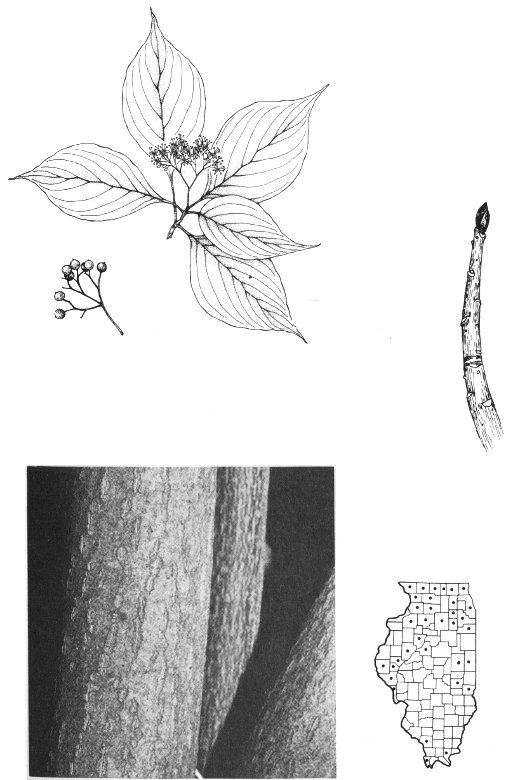
Growth Form: Small tree to 30 feet tall; trunk diameter up to 3 inches; crown open and irregular.
Bark: Reddish-brown, scaly, shallowly furrowed.
Twigs: Slender, pale brown, purplish, or gray, smooth or slightly hairy; leaf scars opposite, crescent-shaped, slightly elevated, with 3 bundle traces.
Buds: Slender, flattened, pointed, finely hairy, up to ⅛ inch long.
Leaves: Opposite, simple; blades elliptic to narrowly ovate, pointed at the tip, tapering to rounded at the base, up to 4 inches long, up to half as wide, smooth along the edges, green and with short hairs on the upper surface, paler and hairy on lower surface; leafstalks up to ½ inch long, hairy.
Flowers: Several in round-topped clusters, appearing in May and June, each flower white, with 4 narrow petals.
Fruit: White, spherical berries up to ¼ inch in diameter, borne on red stalks.
Wood: Hard, heavy, close-grained, brown.
Use: Tool handles.
Habitat: Woods; edges of prairies.
Range: New York across to Minnesota, south to Nebraska and Texas, east to Florida.
Distinguishing Features: This is the only dogwood in Illinois that is rough-hairy on the upper surface of the leaves.
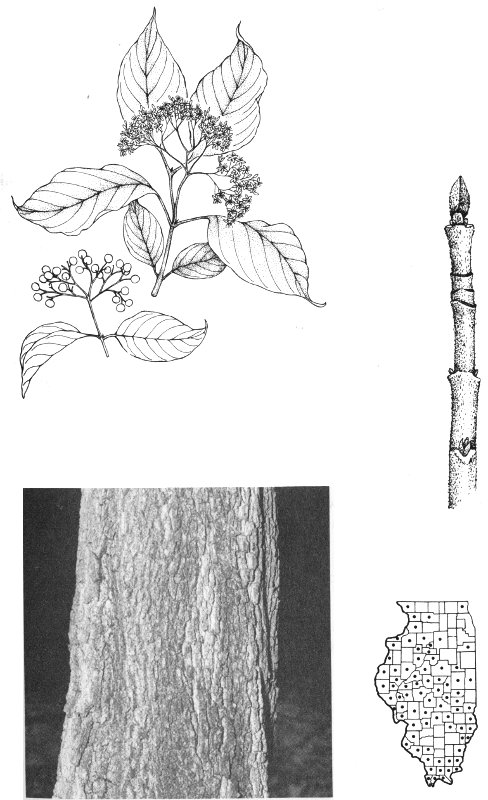
Growth Form: Small to medium tree to 40 feet tall; trunk diameter rarely more than 2 feet; crown rounded.
Bark: Brown, divided into squarish plates.
Twigs: Slender, greenish to light brown, smooth, often curving upward at the tip; leaf scars opposite, crescent-shaped, elevated, with 3 bundle traces.
Buds: Of two kinds, the leaf buds slender, pointed, the flower buds flat and biscuit-shaped.
Leaves: Opposite, simple; blades elliptic to ovate, pointed at the tip, tapering or rounded at the base, up to 6 inches long, less than half as broad, the veins deeply impressed, the edges without teeth, green and smooth or sparsely hairy on the upper surface, pale and finely hairy or sometimes smooth on the lower surface; leafstalks up to ¾ inch long, smooth or finely hairy.
Flowers: Several crowded together in a yellow-green cluster, each cluster subtended by 4 large white petal-like bracts, appearing in late April and May.
Fruit: Red, ovoid berries up to ½ inch long, shiny, with mealy flesh and 1 or 2 seeds.
Wood: Hard, strong, heavy, close-grained, brown.
Uses: The wood is used in the making of tool handles, although the real value of the Flowering Dogwood is its ornamental potential.
Habitat: Woods.
Range: Maine across to Kansas, south to Texas, east to Florida; also in Mexico.
Distinguishing Features: The opposite, toothless leaves with deeply impressed veins distinguish this species.
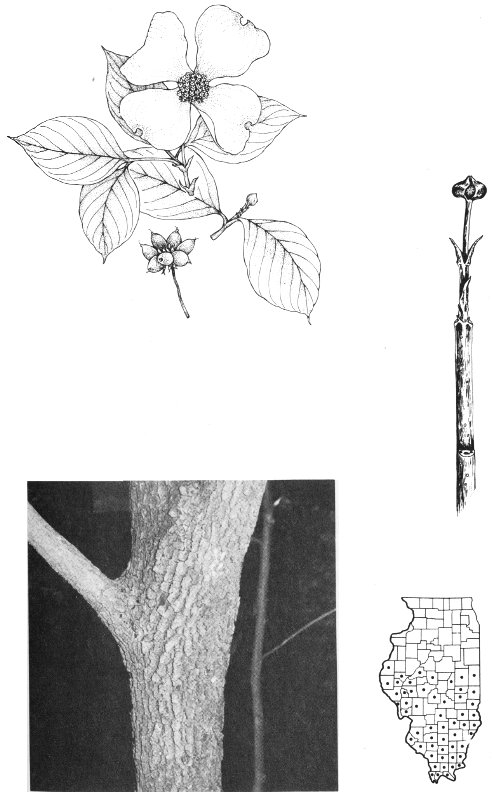
Several other dogwoods, most of them rarely if ever attaining the stature of small trees, occur in Illinois.
Gray Dogwood (Cornus racemosa Lam.). This plant rarely exceeds a height of 10 feet. It is distinguished by its slender gray twigs, its small white flowers borne in clusters about as broad as high, and its white berries about ¼ inch in diameter. The Racemose Dogwood occurs in a variety of habitats, including prairies and woods.
Stiff Dogwood (Cornus foemina Mill.). This small dogwood has brownish twigs with white pith and bluish fruits. Its leaves usually are smooth on both surfaces. It occurs in low, wet woods.
Round-leaved Dogwood (Cornus rugosa Lam.). As the name implies, this shrubby dogwood has roundish leaves which are woolly on the lower surface. The greenish twigs have white pith. The berries are pale blue. The Round-leaved Dogwood grows in dry, rocky woods.
Red Osier (Cornus stolonifera Michx.). Red Osier has dark red twigs with white pith. The leaves are pale and somewhat hairy on the lower surface. The berries are white or grayish. Red Osier usually grows along shores, often forming thickets.
Silky Dogwood (Cornus obliqua Raf.). This plant is usually a shrub, but may get as much as 15 feet tall. It has twigs with pale brown pith. The leaves are pale on the lower surface, and usually have white, appressed hairs. The berries are blue. Silky Dogwood grows in low ground.
Willow Dogwood (Cornus amomum Mill.). The Willow Dogwood rarely exceeds a height of 10 feet. Like the Silky Dogwood, it has twigs with pale brown pith. The leaves usually have reddish-colored hairs on the lower surface. The berries are pale blue. Willow Dogwood grows in low ground.
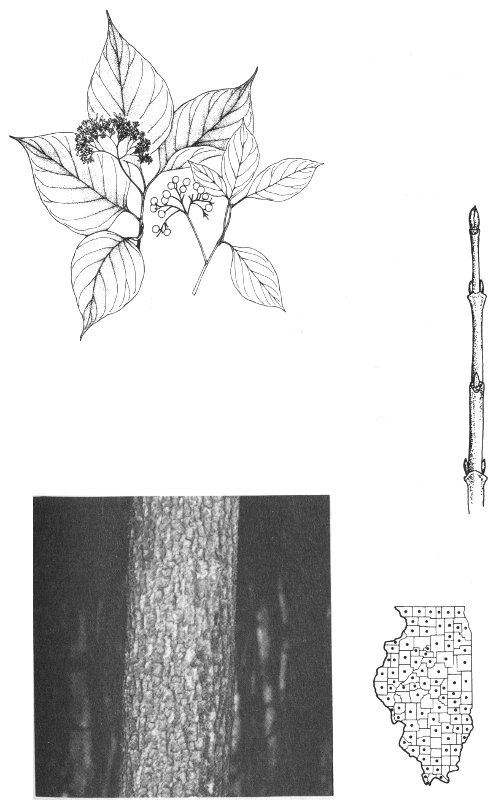
Gray Dogwood
Growth Form: Small tree to 20 feet tall; trunk diameter up to 8 inches; crown broadly rounded.
Bark: Dark brown, scaly.
Twigs: Moderately stout, light brown, smooth, usually with sharp spines up to 4 inches long; leaf scars alternate, crescent-shaped, slightly elevated, with 3 bundle traces.
Buds: Rounded, up to ¼ inch in diameter, reddish-brown, usually smooth.
Leaves: Alternate, simple; blades broadest above the middle, rounded or short-pointed at the tip, tapering to the base, up to 4 inches long, up to 1½ inches broad, leathery, toothed along the edges, at least in the upper half of the leaf, dark green, smooth, shiny on the upper surface, paler and smooth on the lower surface; leafstalks stout, up to 1 inch long, smooth.
Flowers: Showy, several in a cluster, appearing in May and June, each up to ¾ inch across, with 5 white petals.
Fruit: Spherical or nearly so, up to ½ inch in diameter, red, fleshy but dry, with 1-2 nutlets.
Wood: Heavy, hard, close-grained, brown.
Use: Sometimes grown as an ornamental.
Habitat: Wooded slopes, thickets.
Range: Southern Ontario across to Minnesota, south to Texas, east to South Carolina.
Distinguishing Features: Cock-spur Thorn differs from most other hawthorns in Illinois by its leathery, shiny leaves which are broadest above the middle.
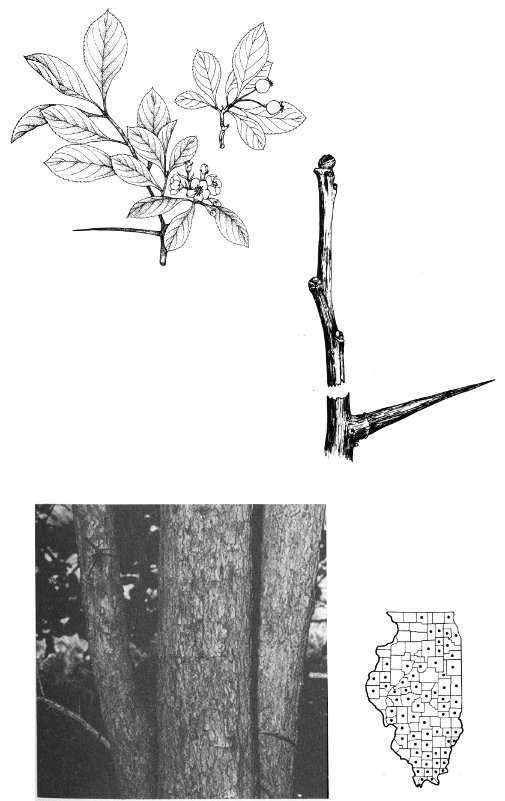
Growth Form: Small tree to 25 feet tall; trunk diameter up to 14 inches; crown widely spreading.
Bark: Gray-brown, scaly, deeply furrowed.
Twigs: Moderately stout, gray or brown, smooth or slightly hairy, rarely with spines; leaf scars alternate, crescent-shaped, slightly elevated, with 3 bundle traces.
Buds: Rounded, up to ¼ inch in diameter, reddish-brown, usually hairy.
Leaves: Alternate, simple; blades ovate, broadest near the base, short-pointed at the tip, rounded at the base, up to 4 inches long and nearly as broad, coarsely toothed along the edges, occasionally with shallow lobes, yellow-green and hairy on the upper surface, paler and hairy on the lower surface; leafstalks stout, up to 1 inch long, hairy.
Flowers: Showy, several in a cluster, appearing in April and May, each up to 1 inch across, with 5 white petals.
Fruit: Spherical or nearly so, up to 1 inch in diameter, red, fleshy but dry, with 4-5 nutlets.
Wood: Heavy, hard, close-grained, brown.
Habitat: Moist woods.
Range: Southern Ontario across to Minnesota, south to Oklahoma, east to Alabama.
Distinguishing Features: The Red Haw is distinguished by its densely hairy, ovate leaves which are often shallowly lobed.
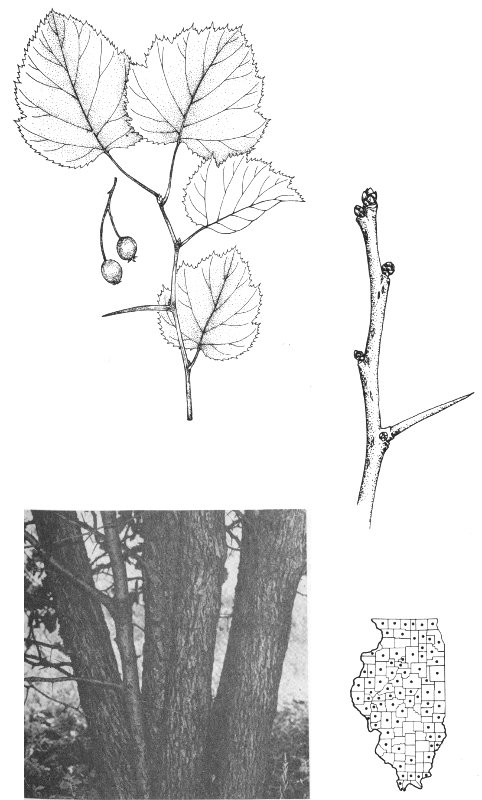
Growth Form: Small tree to 15 feet tall; trunk diameter up to 8 inches; crown broad and irregular.
Bark: Dark gray, scaly, furrowed.
Twigs: Slender, reddish-brown, smooth, with spines up to 2 inches long; leaf scars alternate, crescent-shaped, slightly elevated, with 3 bundle traces.
Buds: Rounded, up to ⅛ inch in diameter, reddish-brown, smooth or nearly so.
Leaves: Alternate, simple; blades mostly ovate, broadest below the middle, pointed at the tip, rounded at the base, up to 3 inches long and about ⅔ as broad, coarsely toothed along the edges and frequently shallowly lobed, bluish-green and smooth on the upper surface, paler and smooth on the lower surface; leafstalks stout, up to 1 inch long, smooth or somewhat hairy.
Flowers: Showy, several in a cluster, appearing in May and early June, each up to 1 inch across, with 5 white petals.
Fruit: Spherical or nearly so, up to ¾ inch in diameter, dark red to purple, fleshy but dry, with 5 nutlets.
Wood: Heavy, hard, close-grained, brown.
Habitat: Woods and thickets.
Range: Newfoundland to southern Ontario, south to Arkansas, east to North Carolina.
Distinguishing Features: The Pruinose Haw is distinguished by its bluish-green leaves which are widest just below the middle.
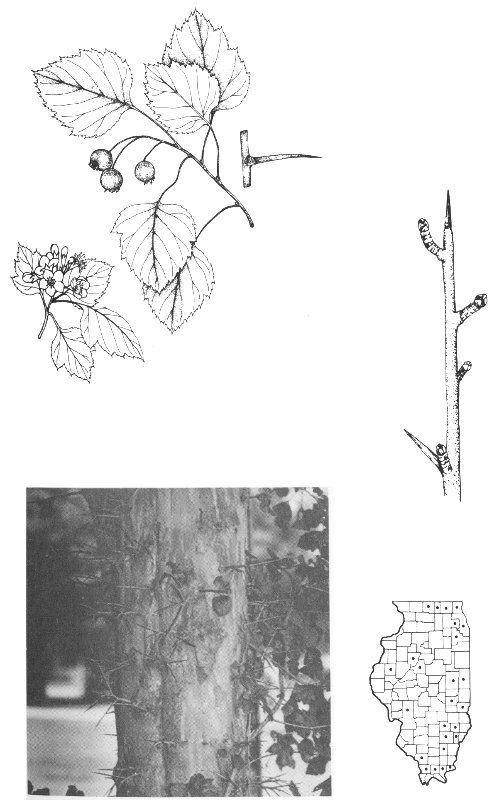
Many other hawthorns occur in Illinois. Several of them have been found only a very few times. Most of them are difficult to distinguish unless leaves, flowers, and fruits are available. A few of the hawthorns which are likely to be encountered are described on this and the following page.
Scarlet Hawthorn (Crataegus coccinioides Ashe). This hawthorn grows to a height of 15 feet and has very scaly brown bark. The slender gray twigs have many stout, sharp spines up to 2 inches long. The ovate leaves are coarsely toothed and usually shallowly lobed. There are some hairs on both surfaces of the leaves. The spherical fruits, when mature, are deep red speckled with several pale dots. There are usually 5 nutlets inside each fruit. The Scarlet Hawthorn is found primarily on rocky hills.
Urn-shaped Hawthorn (Crataegus calpodendron (Ehrh.) Medic.) The Urn-shaped Hawthorn is named for the shape of its fruit, which is usually about ½ inch long, red, with sweet flesh and 2-3 nutlets inside. This small tree only grows to a height of about 15 feet. The leaves are usually ovate and are coarsely toothed and often shallowly lobed. They have a greenish-yellow color and are hairy, at least on the underneath surface. This hawthorn frequently grows along rocky streams.

Urn-Shaped Hawthorn
Green Haw (Crataegus viridis L.). The Green Haw is primarily a tree of low, wet woods, where it grows to a height of nearly 30 feet and has a gray, scaly bark. The rather variable leaves range from elliptic to elliptic-ovate and toothed to occasionally shallowly lobed. The leaves are thin and smooth on both surfaces, except for some tufts of hair along the axils of the veins on the lower surface. The orange-red fruits are spherical and about ⅓ inch in diameter. There are 5 nutlets embedded in the rather sweet flesh.
Dotted Haw (Crataegus punctata Jacq.). This hawthorn grows to a height of about 20 feet and has many stout thorns on its twigs. The leaves generally are broadest above the middle and are obovate. The edges of the leaves are usually toothed from the middle to the tip. Sometimes lobes are formed. The leaves have a relatively thick texture and are hairy on the veins of the under surface of the leaves. The usually spherical fruit is about ¾ inch in diameter and contains 3 or 5 nutlets. The Dotted Thorn often forms thickets along the edges of woods or in rocky fields.

Green Hawthorn
Dotted Hawthorn
Growth Form: Medium tree up to 50 feet tall; trunk diameter up to 1 foot; crown broad and rounded or flattened. (At one time in the Wabash Valley, Persimmon trees nearly 3 feet in diameter were known.)
Bark: Dark gray to black, broken at maturity into squarish blocks.
Twigs: Slender, brown, smooth or hairy, usually with lenticels; leaf scars alternate, half-elliptic, with 1 bundle trace.
Buds: More or less rounded, smooth, dark reddish-brown, up to ⅛ inch long.
Leaves: Alternate, simple; blades elliptic to oval, pointed at the tip, tapering or rounded at the base, up to 5 inches long and about half as broad, smooth along the edges, dark green, smooth, and shiny on the upper surface, paler and smooth on the lower surface; leafstalks stout, up to 1 inch long, smooth or sparsely hairy.
Flowers: Staminate and pistillate usually borne on separate trees, appearing after the leaves are half grown, the staminate in clusters of 2-3, tubular, up to ½ inch long, the pistillate solitary, ½ to ¾ inch long. Sometimes flowers with both stamens and pistils can be found.
Fruit: Fleshy, spherical, but with the greenish calyx persistent at one end, yellow-orange to orange (rarely blue), up to 2 inches in diameter, sweet when ripe, few-seeded.
Wood: Heavy, hard, the heartwood nearly black.
Uses: Golf club heads, billiard cues.
Habitat: Dry woods, rich bottomland woods, edge of fields, fence rows.
Range: Connecticut across to southern Iowa and eastern Kansas, south to eastern Texas, east to Florida.
Distinguishing Features: The leaves of the Persimmon are most often confused with those of the Sour Gum, but usually the tip is not as abruptly pointed in the Persimmon. The pith of the Persimmon also lacks the distinct partitions found in the Sour Gum.
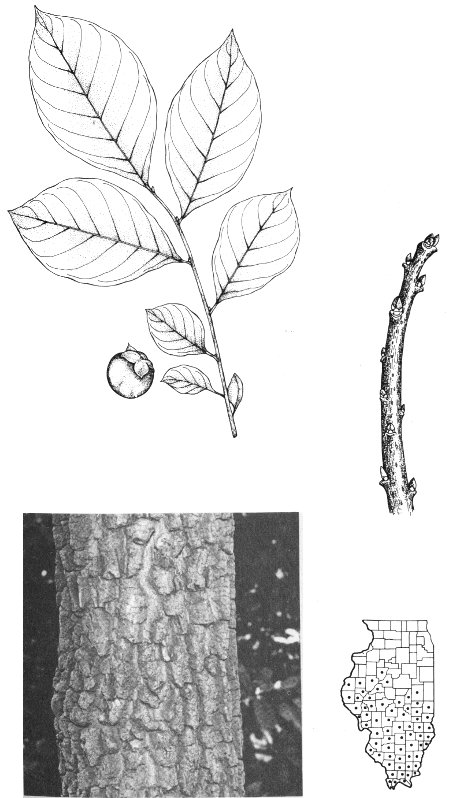
Growth Form: Large tree to nearly 100 feet tall; trunk diameter up to 4 feet; crown widely spreading, usually rounded.
Bark: Smooth, gray, thin, often marred by human carving.
Twigs: Gray or yellowish, slender, smooth, more or less zigzag; leaf scars alternate, half-round, with 3 bundle traces.
Buds: Slender, narrow, long-pointed, smooth, reddish-brown, up to ¾ inch long.
Leaves: Alternate, simple; blades up to 4 inches long and 2½ inches broad, oblong, pointed at the tip, rounded or tapering to the somewhat asymmetrical base, coarsely toothed along the edges, blue-green to yellow-green, smooth and shiny on the upper surface, smooth or finely hairy on the lower surface; leaf stalk very short, sometimes hairy.
Flowers: Staminate and pistillate borne separately on the same tree, appearing after the leaves have unfolded, the staminate numerous in small spherical heads, the pistillate in groups of 2.
Fruit: Spiny burs up to ¾ inch long, prickly, reddish-brown, containing 1-3 triangular nuts.
Wood: Hard, strong, close-grained, deep reddish-brown.
Uses: Fuel, chairs, tool handles.
Habitat: Rich woods.
Range: Nova Scotia across to Ontario, south to eastern Texas, east to northern Florida.
Distinguishing Features: The stately Beech is recognized by its smooth gray bark and its long, pointed winter buds.
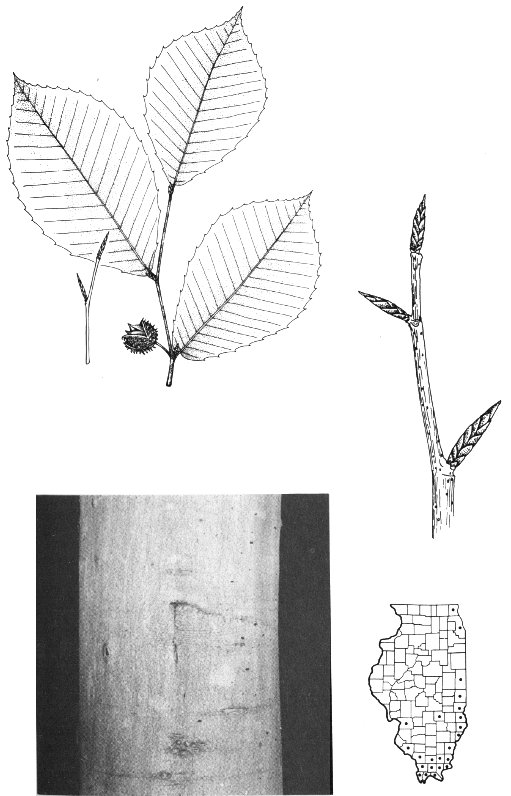
Growth Form: Small tree to 30 feet tall; trunk diameter up to 5 inches; crown spreading, irregular.
Bark: Brown, shallowly furrowed or nearly smooth.
Twigs: Slender, brown, warty or smooth; leaf scars opposite, shield-shaped, with 1 bundle trace.
Buds: Spherical, up to ⅛ inch in diameter, smooth.
Leaves: Opposite, simple; blades elliptic, pointed at the tip, tapering to the base, up to 4 inches long, up to 1½ inches broad, finely toothed along part of the edges, yellow-green and nearly smooth on the upper surface, paler and smooth on the lower surface; leafstalks slender, usually smooth, up to ½ inch long.
Flowers: Staminate and pistillate borne separately on different trees, appearing before the leaves begin to unfold; staminate many in rounded clusters, yellow, without petals; pistillate several in branched clusters, yellowish, without petals.
Fruit: Slender, oblong, slightly curved, dark purple, about 1 inch long, up to ¼ inch wide, fleshy but dry, containing 1 seed.
Use: Occasionally planted as an ornamental.
Habitat: Swamps, along rivers.
Range: South Carolina across to Kansas, south to Texas, east to Florida.
Distinguishing Features: Swamp Privet is distinguished by its opposite, pointed leaves which are finely toothed along the edges.
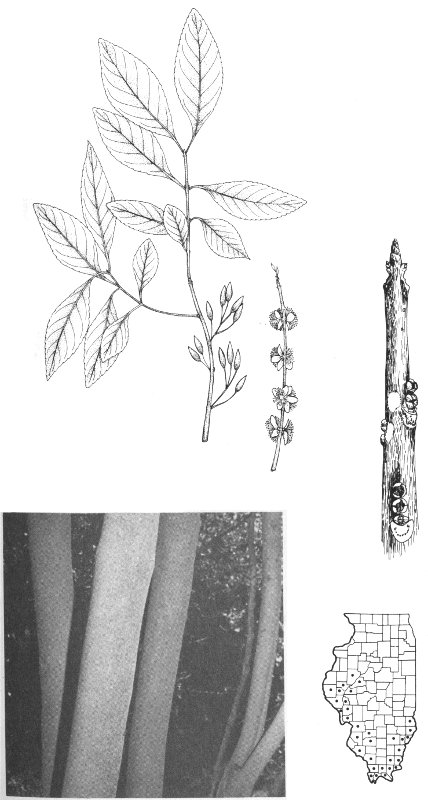
Growth Form: Large tree up to 100 feet tall; trunk diameter up to 4 feet; crown pyramidal or ovoid, with slender branches; trunk straight, columnar.
Bark: Light or dark gray, with diamond-shaped furrows between flat-topped, sometimes scaly, ridges.
Twigs: Slender, gray or brown, sometimes with a few hairs; leaf scars opposite, horseshoe-shaped, with several bundle traces forming a half-moon.
Buds: Rounded, dark brown, finely hairy, up to ½ inch long.
Leaves: Opposite, pinnately compound, with 5-9 leaflets; leaflets lance-shaped to lance-ovate, often curved, pointed at the tip, rounded or tapering to the base, up to 5 inches long and about half as broad, shallowly toothed along the edges, green and smooth on the upper surface, paler and smooth or hairy on the lower surface.
Flowers: Staminate and pistillate borne on separate trees before the leaves begin to expand, minute, without petals, purplish, in crowded clusters, soon becoming elongated and less crowded.
Fruit: Paddle-shaped, winged, up to 2½ inches long and ¼ inch wide, several in a cluster, 1-seeded at the base.
Wood: Heavy, strong, hard, coarse-grained, brown.
Uses: Furniture, baseball bats, tool handles, interior finishing.
Habitat: Bottomlands and wooded slopes.
Range: Nova Scotia across to Minnesota, south to Texas and Florida.
Distinguishing Features: White Ash differs from Green Ash in having distinctly paler lower leaf surfaces. Plants with hairy leaves resemble Red Ash, but the fruits do not have the wing extending down beyond the seed in the White Ash.
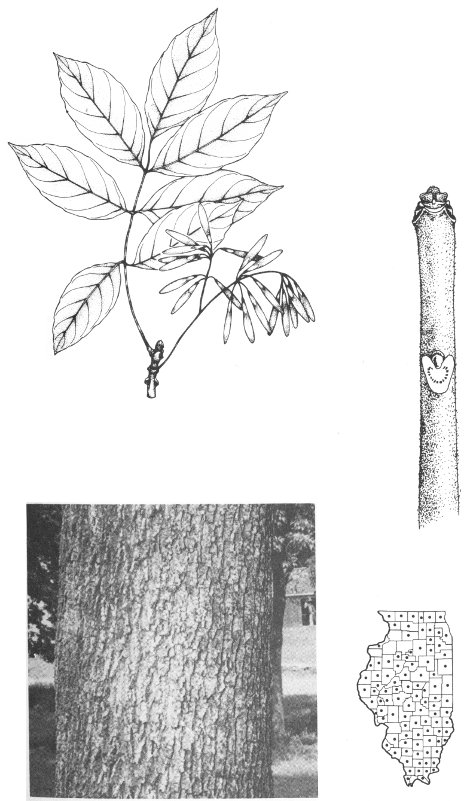
Growth Form: Medium tree up to 70 feet tall; trunk diameter up to 2 feet; crown broadly rounded, with many stout, straight branches.
Bark: Light gray, scaly, without diamond-shaped furrows.
Twigs: Stout, gray or brown, smooth; leaf scars elliptic or oval, with several bundle traces arranged in a half moon.
Buds: Conical, blue-black, finely hairy, about one-fourth inch long.
Leaves: Opposite, pinnately compound, with 7-11 leaflets; leaflets without stalks, lance-shaped, long-pointed at the tip, tapering or rounded at the sometimes asymmetrical base, up to 6 inches long, less than one-half as wide, toothed along the edges, dark green and smooth on the upper surface, paler and with rusty hairs along the veins on the lower surface. The leaflets turn reddish-brown in the autumn.
Flowers: Small, in elongated clusters, appearing before the leaves begin to unfold, purplish, without any petals, some with both stamens and pistils, others only with stamens, others only with pistils.
Fruit: Oblong, winged fruits, barely notched at the tip, up to 1½ inches long, up to one-half inch broad, with a single seed at the base.
Wood: Soft, heavy, dark brown.
Uses: Cabinets, baskets, fence posts.
Habitat: Swampy woods.
Range: Newfoundland across to Manitoba, south to Iowa, central Illinois, West Virginia, and Delaware.
Distinguishing Features: This is the only ash in Illinois where none of the leaflets has stalks.
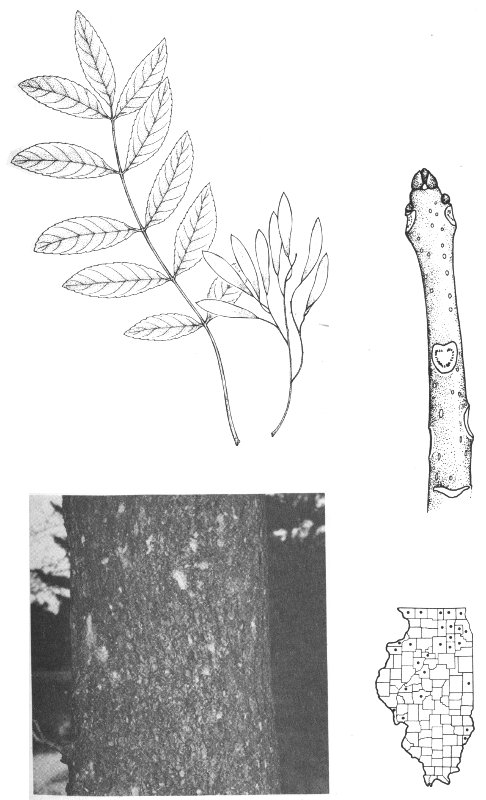
Growth Form: Medium tree up to 60 feet tall; trunk diameter up to 2 feet; crown usually pyramidal; trunk straight, rather stout, sometimes slightly buttressed at base.
Bark: Light or dark gray, with diamond-shaped furrows between flat-topped, sometimes scaly ridges.
Twigs: Slender to rather stout, gray or brown, covered by velvety hairs, leaf scars opposite, half-round and straight across the top, with several bundle traces forming a half-moon.
Buds: Rounded, dark brown, finely hairy, about ¼ inch long.
Leaves: Opposite, pinnately compound, with 7-9 leaflets; leaflets elliptic to elliptic-ovate, pointed at the tip, tapering to the base, up to 6 inches long, about ⅓ as wide, sparsely toothed along the edges, hairy on both surfaces.
Flowers: Staminate and pistillate on separate trees, appearing after the leaves have begun to open, minute, crowded in purplish or greenish dense clusters.
Fruit: A cluster of paddle-shaped fruits, each fruit up to 2½ inches long and less than ½ inch broad, with a single seed at one end.
Wood: Hard, strong, heavy, coarse-grained, pale brown.
Uses: Tool handles, interior finishing, furniture.
Habitat: Bottomland forests.
Range: Nova Scotia across to North Dakota, south to Kansas, east to Louisiana and northern Florida.
Distinguishing Features: Red Ash is characterized by its hairy leaf stalks and its narrow wings along the stalks between the leaflets.

Growth Form: Medium tree up to 60 feet tall; trunk diameter up to 2½ feet; crown broadly rounded, with slender, spreading branches.
Bark: Light or dark gray, with diamond-shaped furrows between flat-topped, sometimes scaly, ridges.
Twigs: Slender to rather stout, gray or brown, smooth; leaf scars half-round and straight across the top, with several bundle traces forming a half-moon.
Buds: Rounded, dark brown, finely hairy, up to one-fourth inch long.
Leaves: Opposite, pinnately compound, with 7-9 leaflets; leaflets lance-shaped to elliptic, long-pointed at the tip, tapering to the base, up to 6 inches long and one-and-one-half inches wide, toothed along the edges, green and smooth on both surfaces. The leaflets turn reddish-brown or yellowish in the autumn.
Flowers: Staminate and pistillate flowers borne on separate trees, in branched clusters, appearing as the leaves begin to unfold, small, purplish, without petals.
Fruit: Lance-shaped or reversely lance-shaped, winged fruits, usually rounded at the tip, up to 2½ inches long and less than one-third inch broad, with a single seed at the base.
Wood: Hard, heavy, strong, light brown.
Uses: Interior finishing, tool handles, baseball bats; sometimes grown as an ornamental.
Habitat: Bottomland forests.
Range: Maine across to Saskatchewan and Minnesota, south to Texas, east to Florida.
Distinguishing Features: The Green Ash has leaflets which are green on both surfaces.
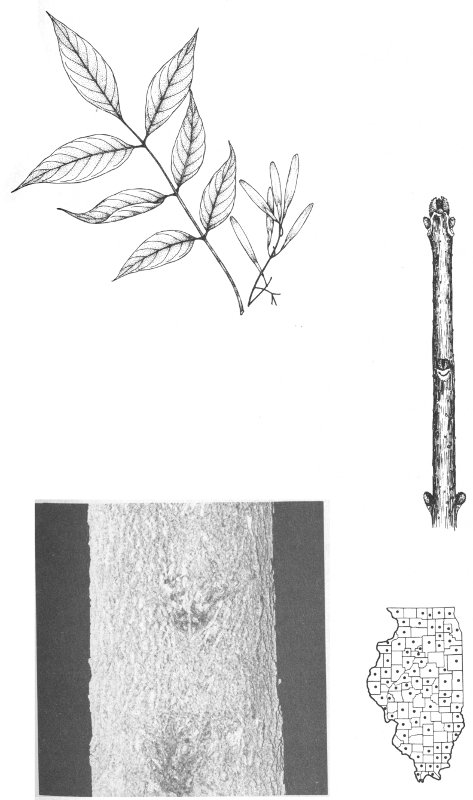
Other Name: Square-stemmed Ash.
Growth Form: Moderate tree to seventy feet tall; trunk diameter up to 3 feet; crown irregular, with many short, sturdy branches.
Bark: Gray, scaly, without diamond-shaped furrows.
Twigs: Stout, square, gray or brown, smooth; leaf scars half-round and concave across the top, with several bundle traces forming a half-moon.
Buds: Rounded, gray, finely hairy, up to one-half inch long.
Leaves: Opposite, pinnately compound, with 5-11 leaflets; leaflets lance-shaped, long-pointed at the tip tapering to the sometimes asymmetrical base, up to 6 inches long, less than half as wide, coarsely toothed along the edges, yellowish-green and smooth on the upper surface, paler and usually with tufts of hairs along the veins on the lower surface. The leaflets turn yellow in the autumn.
Flowers: Small, in branched clusters, appearing as the leaves begin to unfold, purplish, without any petals.
Fruit: Oblong, winged fruits, notched at the tip, up to 2 inches long and one-half inch broad, with a single seed near the bottom.
Wood: Hard, heavy, yellow-brown.
Uses: Flooring; the inner bark produces a blue dye when placed in water.
Habitat: Wooded slopes, limestone cliffs.
Range: Western Pennsylvania across Wisconsin to Iowa, south to Oklahoma, Arkansas, and Alabama; southern Ontario.
Distinguishing Features: The square stems immediately distinguish this tree from any other ash in Illinois.
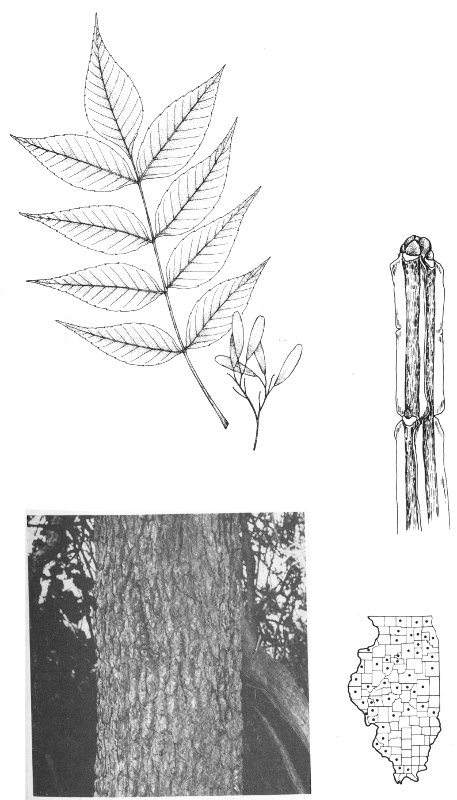
Growth Form: Large tree sometimes nearly 100 feet tall; trunk diameter up to 3 feet; crown broadly rounded, with stout spreading branches.
Bark: Gray, becoming scaly.
Twigs: Stout, gray or brown, usually velvety; leaf scars opposite, horseshoe-shaped, with several bundle traces arranged in a half-moon.
Buds: More or less conical, brown, hairy, about one-fourth inch long.
Leaves: Opposite, compound, with 7-9 leaflets; leaflets lance-shaped to elliptic, pointed at the tip, rounded or tapering at the slightly asymmetrical base, up to 10 inches long and about half as wide, smooth or finely toothed along the edges, yellow-green and smooth on the upper surface, paler and velvety-hairy on the lower surface. The leaves turn yellow in the autumn.
Flowers: Staminate and pistillate flowers borne on separate trees, in elongated clusters, appearing before the leaves, small, greenish-purple, without any petals.
Fruit: Oblong, winged fruits, usually rounded at the tip, up to 3 inches long and one-half inch broad, with a single seed near the bottom.
Wood: Heavy, strong, hard, close-grained, brown.
Uses: Boxes, paper pulp, fuel.
Habitat: Floodplains, swamps.
Range: New York across Ohio to southern Illinois and southern Missouri, south to Louisiana, east to Florida.
Distinguishing Features: The Pumpkin Ash is the only ash in Illinois with velvety-hairy twigs and usually toothless leaves.

Growth Form: Small to medium tree to 60 feet tall; trunk diameter up to 2 feet; crown widely but irregularly spreading; trunk short and stout.
Bark: Dark gray or dark brown, shallowly furrowed.
Twigs: Slender, gray or brown, smooth, usually with unbranched thorns; leaf scars alternate, more or less 3-lobed, with 3 bundle traces.
Buds: Rounded, nearly hidden beneath the leaf scars, dark brown, smooth, up to ⅛ inch long.
Leaves: Alternate, both singly and doubly pinnately compound on the same tree, with many leaflets; leaflets oblong to oblong-ovate, rounded or slightly pointed at the tip, rounded at the slightly asymmetrical base, toothless or minutely toothed along the edges, smooth except for some hairs along the veins, up to 1 inch long, about half as wide.
Flowers: Some flowers with both stamens and pistils, others with only one or the other, in elongated clusters up to 4 inches long, greenish, small, appearing in May and June.
Fruit: Short, pointed legumes up to 2 inches long and 1 inch broad, borne several in a drooping cluster, chestnut-brown, smooth, with 1 or 2 seeds and no pulp.
Wood: Hard, heavy, coarse-grained, reddish-brown.
Uses: Fence posts, coarse construction.
Habitat: Swampy woods.
Range: North Carolina across to southern Missouri, south to Texas, east to Florida.
Distinguishing Features: The short, 1- or 2-seeded legume without pulp differentiates this locust from the Honey Locust.
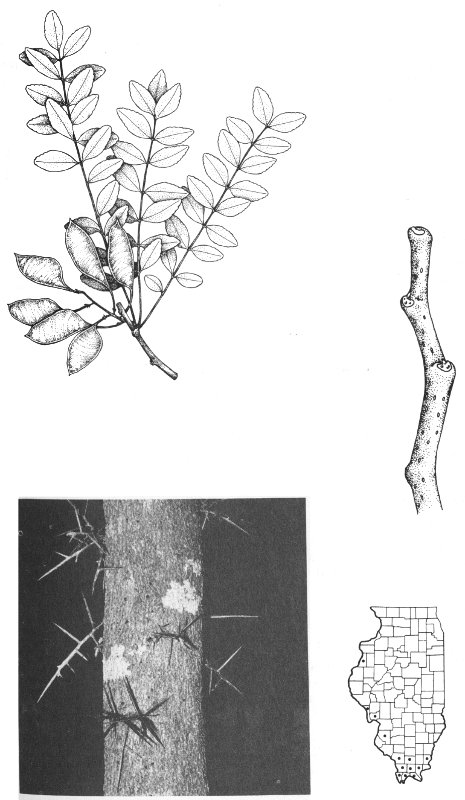
Growth Form: Medium tree to 70 feet tall; trunk diameter up to 3 feet; crown broadly rounded, often with dropping outer branches; trunk straight, rather stout, usually with large, purple-brown, 3-parted thorns.
Bark: Dark brown, deeply furrowed and scaly at maturity.
Twigs: Slender, angular, reddish-brown, smooth, zigzag, with 3-parted or unbranched thorns; leaf scars alternate, more or less 3-lobed, with 3 bundle traces.
Buds: Rounded, nearly hidden beneath the leaf scars, dark brown, smooth, up to ⅛ inch long.
Leaves: Alternate, often doubly pinnately compound, with many leaflets; leaflets oblong to oblong-lanceolate, rounded or slightly pointed at the tip, rounded at the slightly asymmetrical base, minutely toothed along the edges, smooth except for some hairs along the veins, up to 1½ inches long, less than half as wide.
Flowers: Some flowers with both stamens and pistils, others with only one or the other, in elongated clusters up to 3 inches long, yellowish, small, appearing in May and June.
Fruit: Elongated legumes up to 1½ feet long and up to 2 inches wide, flat, often twisted or curved, purple-brown, containing several seeds embedded in a thick pulp.
Wood: Hard, strong, coarse-grained, reddish-brown.
Uses: Fence posts, coarse construction; a spineless form sometimes cultivated.
Habitat: Moist, wooded ravines, thickets, along roads.
Range: New York across to South Dakota, south to Texas, east to Florida.
Distinguishing Features: Honey Locust has more leaflets than any other kind of tree in Illinois. The large 3-parted spines and the long fruits are also distinctive.
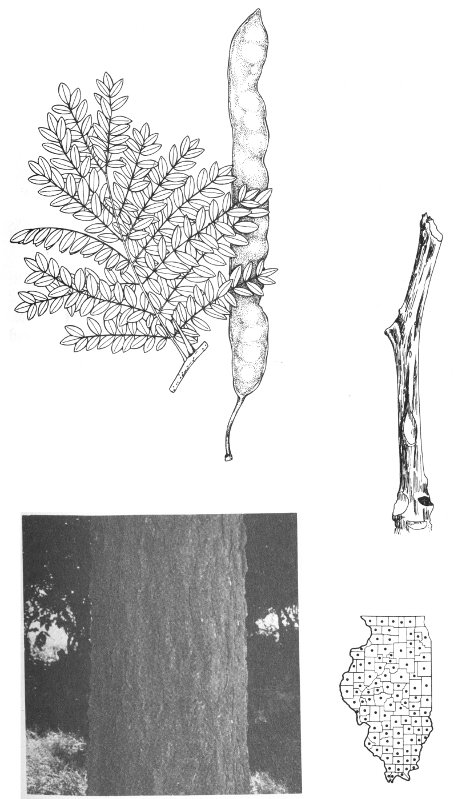
Growth Form: Medium to large tree to 85 feet tall; trunk diameter up to 2½ feet; crown with a narrow, rounded top; trunk stout, usually branching a few feet above the ground.
Bark: Dark gray, deeply furrowed and scaly at maturity.
Twigs: Stout, dark brown with orange lenticels, slightly hairy; leaf scars alternate, heart-shaped, with 3 or 5 bundle traces; pith chocolate-colored.
Buds: Tiny, sunken in hairy cavities immediately above each leaf scar.
Leaves: Alternate, doubly pinnately compound, with many leaflets; leaflets ovate, pointed at the tip, rounded at the base, up to 2 inches long and about half as broad, without teeth along the edge, dark green and smooth on the upper surface, yellow-green and smooth or hairy on the veins on the lower surface.
Flowers: Staminate and pistillate borne separately on separate trees, in more or less elongated, greenish clusters, appearing after the leaves have unfolded, each flower with 5 oblong, hairy petals.
Fruit: Short, thick legumes up to 10 inches long and up to 2 inches wide, dark brown, leathery, smooth, containing several large seeds embedded in a thick, sweet pulp.
Wood: Heavy, strong, durable, coarse-grained, reddish-brown.
Uses: Fence posts, fuel, rough construction. The seeds can be used as a substitute for coffee.
Habitat: Rich, often bottomland, woods.
Range: New York across to South Dakota, south to Oklahoma, east to Tennessee.
Distinguishing Features: The doubly compound leaves with large leaflets, the short, thick legumes, and the thick twigs with sunken buds readily distinguish this tree. It is one of the last trees to put forth its leaves in the spring.
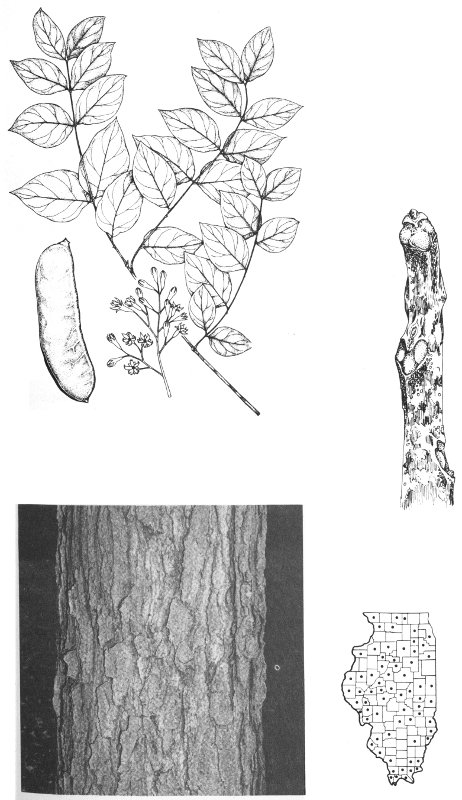
Growth Form: Small tree to 30 feet tall; trunk diameter up to 8 inches; crown widely spreading.
Bark: Reddish-brown, with whitish stripes, somewhat scaly.
Twigs: Slender, reddish-brown, usually smooth; leaf scars alternate, half-round, with a cluster of bundle scars.
Buds: Ovoid, pointed, reddish-brown, somewhat hairy, up to ⅛ inch long.
Leaves: Alternate, simple; blades oval to elliptic, pointed at the tip, tapering to rounded at the base, up to 6 inches long, about half as broad, finely toothed along the edges, dark green and usually smooth on the upper surface, paler and smooth or slightly hairy on the lower surface; leafstalks slender, smooth or finely hairy, up to ½ inch long.
Flowers: Few in hanging clusters, showy, white, each bell-shaped and up to one inch long, appearing in April.
Fruit: 4-winged, dry, brown, up to 2 inches long, containing 1 seed.
Wood: Light in weight, soft, close-grained, brown.
Use: Occasionally grown as an ornamental.
Habitat: Rich woods.
Range: Virginia across southern Illinois to Oklahoma, south to Texas, east to Florida.
Distinguishing Features: The bell-shaped white flowers and the 4-winged fruits readily distinguish this handsome tree.
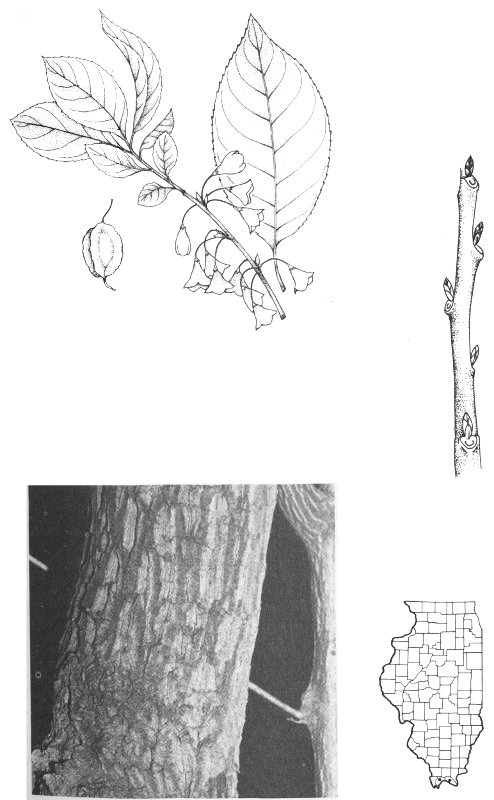
Growth Form: Small tree to 25 feet tall; trunk diameter up to 10 inches; crown broadly rounded.
Bark: Light brown, eventually broken into small scales.
Twigs: Slender, flexible, brown, hairy at first but becoming smooth; leaf scars alternate, half-round, with 3 bundle traces.
Buds: Narrow, pointed, finely hairy, orange-brown, up to ½ inch long.
Leaves: Alternate, simple; blades obovate, rounded or short-pointed at the tip, rounded or sometimes tapering to the base, up to 6 inches long, sometimes nearly half as broad, usually with several low, rounded teeth, dark green and usually somewhat hairy on the upper surface, paler and hairy on the lower surface; leafstalks up to ¾ inch long, slightly hairy.
Flowers: Blooming from September to November, several in a cluster, each with 4 bright yellow, strap-shaped petals up to ⅔ inch long.
Fruit: Capsules up to ½ long, brown, hairy, splitting open during the following autumn to liberate several small, shiny seeds.
Wood: Hard, heavy, close-grained, light brown.
Uses: Planted as an ornamental. The astringent witch hazel is derived from this plant.
Habitat: Woodlands.
Range: Southern Quebec across to Minnesota, south to Missouri, Tennessee, and Georgia.
Distinguishing Features: The late-flowering period and the obovate leaves with shallow, rounded teeth characterize the Witch Hazel.
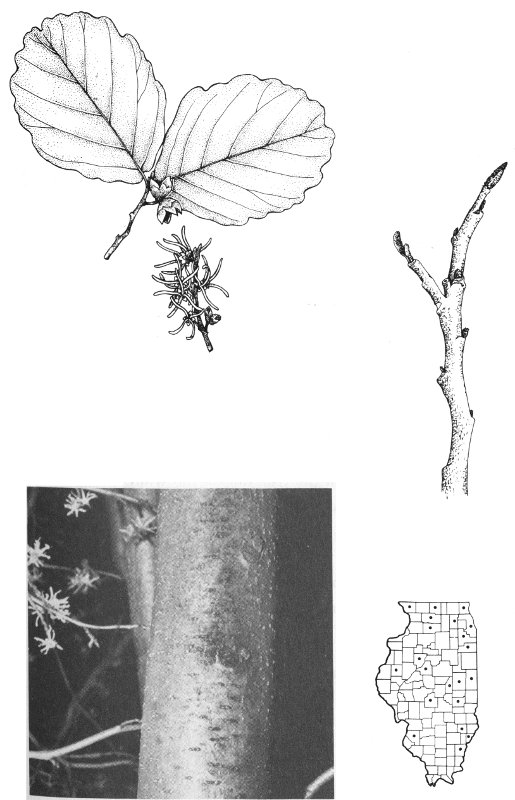
Other Name: Possum Haw; Deciduous Holly.
Growth Form: Small tree up to 20 feet tall; trunk diameter up to 3 inches; crown spreading.
Bark: Light brown, more or less warty.
Twigs: Slender, gray, smooth or slightly hairy, often with short spurs; leaf scars alternate, crescent-shaped, slightly elevated, with 1 bundle trace.
Buds: Rounded, gray, up to ⅛ inch in diameter.
Leaves: Alternate, simple, sometimes clustered at the tips of the short spur-like twigs; blades narrowly oblong to elliptic, short-pointed or rounded at the tip, tapering to the base, up to 3 inches long, less than ½ as broad, sparsely and finely toothed along the edges, green and smooth on the upper surface, paler and slightly hairy on the lower surface; leafstalks slender, hairy, up to ¼ inch long.
Flowers: Staminate and pistillate borne separately on different trees, appearing in April and May; both types of flowers in few-flowered clusters, greenish or whitish, with usually 4 small petals.
Fruit: Red or rarely orange berries, spherical, up to ¼ inch in diameter, remaining on the tree during the winter.
Wood: Hard, heavy, close-grained, whitish.
Use: The handsome berries make this species an attractive ornamental.
Habitat: Bottomland woods.
Range: Maryland across to eastern Kansas, south to Texas, east to Florida.
Distinguishing Features: Swamp Holly is distinguished by its alternate, remotely toothed leaves clustered at the ends of spur-like shoots, and by its red berries.
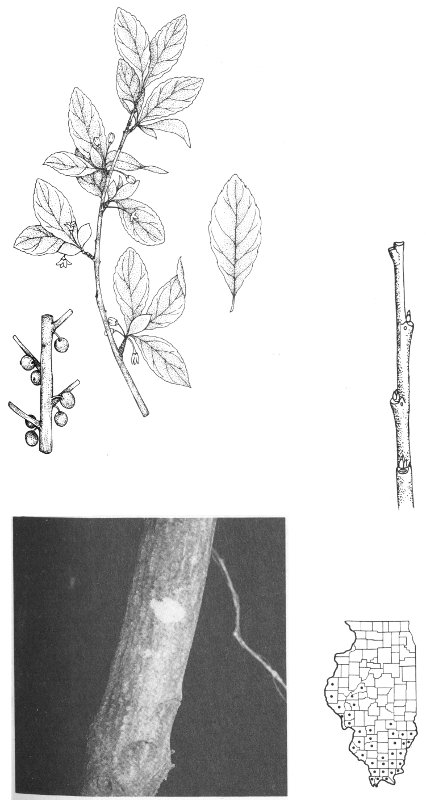
Other Name: White Walnut.
Growth Form: Medium tree up to 90 feet tall; trunk diameter up to 3 feet; crown flat to broadly rounded; trunk straight, columnar, not buttressed.
Bark: Light gray, divided by deep furrows into broad scaly ridges.
Twigs: Stout, greenish or orange-brown to gray, smooth or hairy, usually shiny, with white lenticels; pith chocolate-colored, divided by partitions; leaf scars alternate, shield-shaped, elevated, with 3 bundle traces.
Buds: Blunt at the tip, whitish, hairy, soft, up to ½ inch long.
Leaves: Alternate, pinnately compound, with up to 17 leaflets; leaflets up to 3 inches long and 2 inches wide, broadly lance-shaped, pointed at the tip, rounded at the asymmetrical base, finely toothed along the edges, yellow-green on the upper surface, paler on the lower surface, softly hairy and sometimes sticky.
Flowers: Borne separately but on the same tree, appearing when the leaves are partly grown, the staminate several in thick, yellow-green catkins, the pistillate much fewer in spikes, neither of them with petals.
Fruit: In groups of 2-5, ovoid-oblong, up to 2½ inches long, sticky-hairy, the husk thick, the nut pointed at one end and with well-developed wings, pale brown, the seed sweet.
Wood: Soft, light in weight, coarse-grained, pale brown.
Uses: Furniture, interior finishing; the nut is sought after as a delicacy.
Habitat: Bottomland woods.
Range: New Brunswick across to Minnesota, south to Arkansas, east to Georgia.
Distinguishing Features: The Butternut is distinguished by its bark pattern, its chocolate-colored, partitioned pith, and its distinctive fruits.
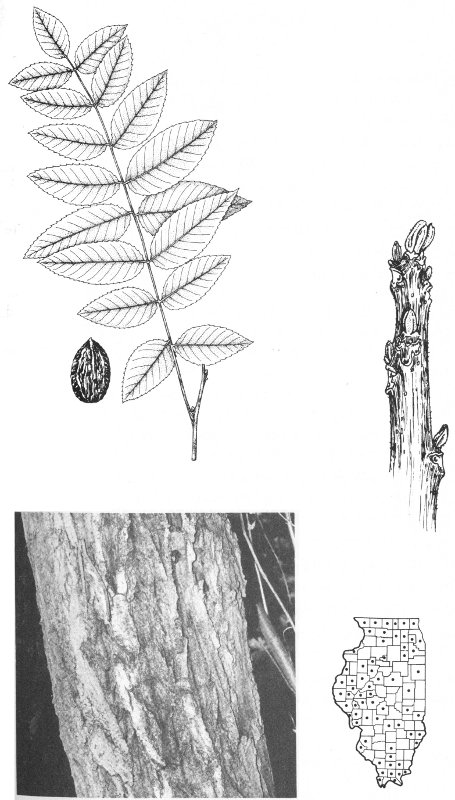
Growth Form: Large tree up to 150 feet tall; trunk diameter up to 5 feet; crown broadly rounded; trunk straight, columnar, not buttressed at the base.
Bark: Black, thick, deeply furrowed.
Twigs: Stout, greenish or orange-brown, hairy, smooth and gray; pith brown, divided by partitions; leaf scars alternate, shield-shaped, elevated, with 3 bundle traces.
Buds: More or less rounded at the tip, pale brown, soft, hairy, up to ½ inch long.
Leaves: Alternate, pinnately compound, with 15-23 leaflets; leaflets up to 3½ inches long and 1½ inches wide, broadly lance-shaped, pointed at the tip, rounded at the asymmetrical base, toothed along the edges, yellow-green and smooth on the upper surface, paler and hairy on the lower surface, turning yellow in the autumn.
Flowers: Borne separately but on the same tree, appearing when the leaves are partly grown, the staminate several in thick, yellow-green, hairy catkins, the pistillate much fewer in small spikes, neither of them with petals.
Fruit: In groups of 1 or 2, spherical, up to 2 inches in diameter, green or yellow-green, slightly roughened, the husk thick, the nut very hard, oval, dark brown, deeply ridged, the seed sweet.
Wood: Hard, heavy, coarse-grained, dark brown.
Uses: The wood is used for furniture, interior finishing, cabinets; the nuts are edible.
Habitat: Rich woodlands.
Range: Massachusetts across to Minnesota, south to Texas, east to Florida.
Distinguishing Features: The Black Walnut is recognized by its characteristic buds, its chambered pith, and its fruits.
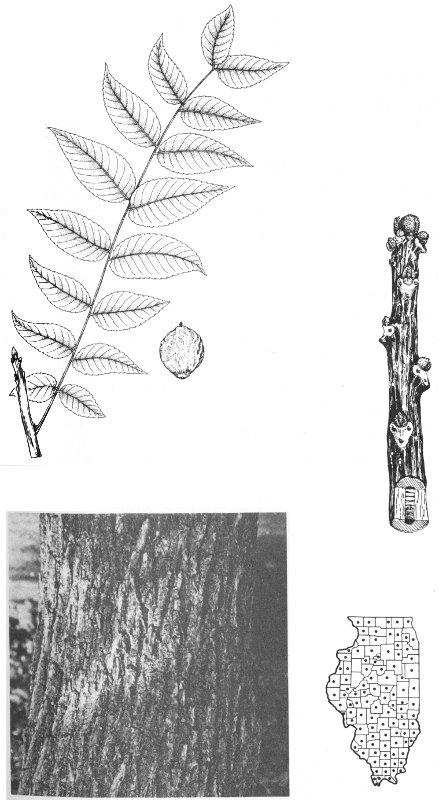
Other Names: Juniper; Eastern Red Cedar.
Growth Form: Medium tree to 90 feet tall, usually much smaller; trunk diameter up to 3 feet; crown narrowly pyramidal or broad and rounded.
Bark: Reddish-brown, splitting into long shreds.
Twigs: Slender, brown.
Leaves: Of 2 types, either flat, triangular, opposite, and up to ¹/₁₆ inch long, or short and needle-like, up to ¾ inch long, blue-green to green to yellow-green.
Flowers: Staminate and pistillate on different trees, the staminate in small, narrow yellowish spikes, the pistillate in small, ovoid, purplish clusters.
Fruit: Berry-like, spherical, up to ¼ inch in diameter, dark blue with a whitish covering, with sweet flesh and 1-2 seeds.
Wood: Durable, light in weight, close-grained, red, fragrant.
Uses: Clothing chests, pencils, fence posts.
Habitat: Fields, dry woods, cliffs.
Range: New Brunswick across to North Dakota, south to Texas, east to Florida.
Distinguishing Features: The 2 kinds of leaves readily distinguish this species.
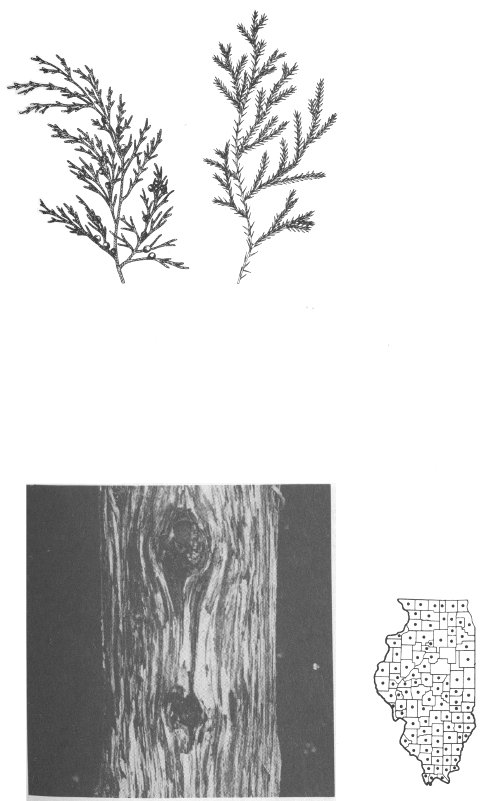
Growth Form: Medium tree to 50 feet tall; trunk diameter up to 15 inches; crown straight and more or less columnar.
Bark: Light brown, scaly.
Twigs: Moderately stout, yellowish, with numerous conspicuous leaf scars or, when older, with short lateral spurs.
Leaves: Needles borne many in clusters from short spurs, or borne singly on new branchlets, soft, yellow-green, up to about one inch long, somewhat triangular, falling from the tree in the autumn.
Flowers: Staminate and pistillate borne separately, but on the same tree, appearing as the new leaves begin to appear, the staminate in nearly round, yellow heads, the pistillate in oblong, bright red “cones.”
Fruit: Cones oblong, upright, up to 1¼ inches long, containing numerous small, winged seeds.
Wood: Hard, heavy, strong, orange-brown.
Use: This tree is sometimes planted as an ornamental.
Habitat: Around homes where it has persisted from cultivation.
Range: Native of Europe; infrequently escaped from cultivation in northeastern North America.
Distinguishing Features: The European Larch differs from the American Larch by its slightly longer cones, its yellow-green needles, and its yellower twigs.
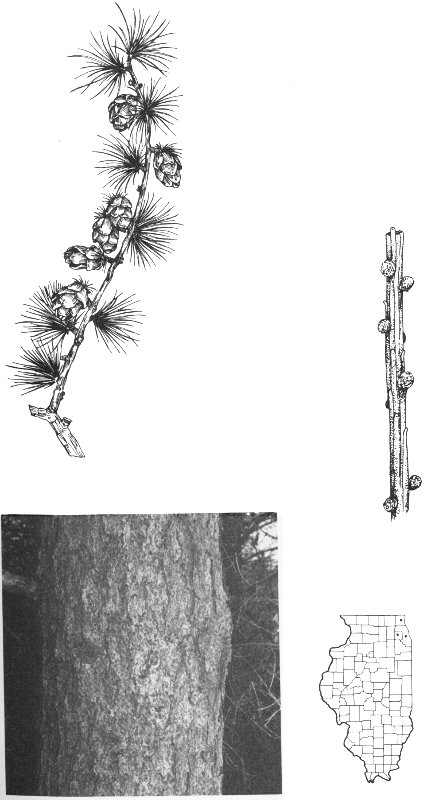
Other Name: Tamarack.
Growth Form: Medium to large tree to 100 feet tall; trunk diameter up to 1½ feet; crown narrowly pyramidal.
Bark: Reddish-brown, broken into scales.
Twigs: Slender, light brown or orange, smooth; leaf scars alternate, elevated, borne on spurs, with 1 bundle trace.
Buds: Spherical, reddish-brown, up to ⅛ inch in diameter.
Leaves: Needles numerous in clusters, soft, up to about 1 inch long, light green, falling away during the autumn.
Flowers: Staminate spherical, yellow, usually not subtended by leaves; pistillate oblong, rose-colored, usually subtended by leaves.
Fruit: Cones oblong, up to ½ inch long, chestnut-brown.
Wood: Heavy, hard, durable, close-grained, orange-brown.
Uses: Fence posts, railroad ties, interior finishing; sometimes grown as an ornamental.
Habitat: Bogs and swamps.
Range: Labrador to Alaska, south to Minnesota, northern Illinois, and West Virginia.
Distinguishing Features: American Larch is distinguished by its short, pale green needles borne many in a cluster or singly on long shoots.
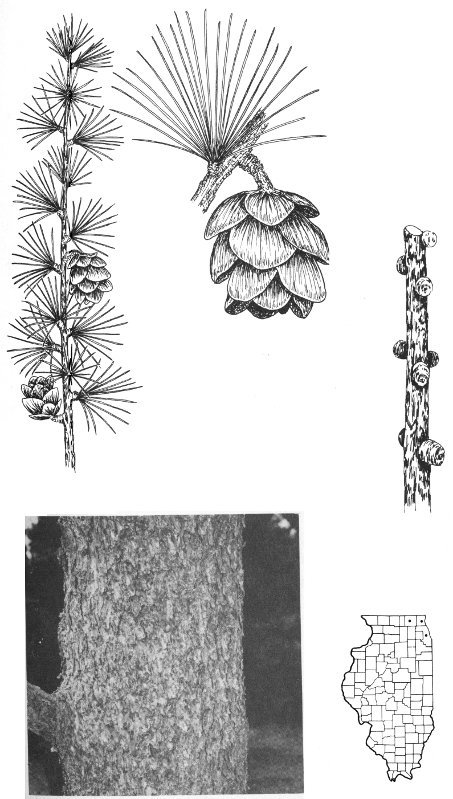
Other Name: Red Gum.
Growth Form: Up to 100 feet tall; trunk diameter sometimes more than 3 feet; crown usually pyramidal.
Bark: Usually dark gray and broken into scaly ridges.
Twigs: Stout, often bordered by corky wings; leaf scars alternate, half-elliptical, slightly elevated, with 3 bundle traces.
Buds: Large, shiny, pointed, sometimes sticky to the touch.
Leaves: Alternate, simple; blades shaped like 5- to 7-pointed stars, each point toothed along the edge, as much as six inches long and nearly as broad. In the autumn, the leaves turn a variety of colors, from red to yellow to purple.
Flowers: Staminate and pistillate on same tree crowded together in rounded clusters, opening at about the same time as the leaves unfold.
Fruit: Dry “ball” about one inch in diameter, covered by numerous short, often sharp projections, with many seeds, most of which are incapable of germinating.
Wood: Hard, strong, durable.
Uses: Lumber, furniture, flooring. The attractive leaves make this tree a handsome ornamental.
Habitat: Bottomland woods.
Range: Southwestern Connecticut across southern Illinois to eastern Oklahoma and eastern Texas, east to central Florida.
Distinguishing Features: The star-shaped leaves readily distinguish this tree.
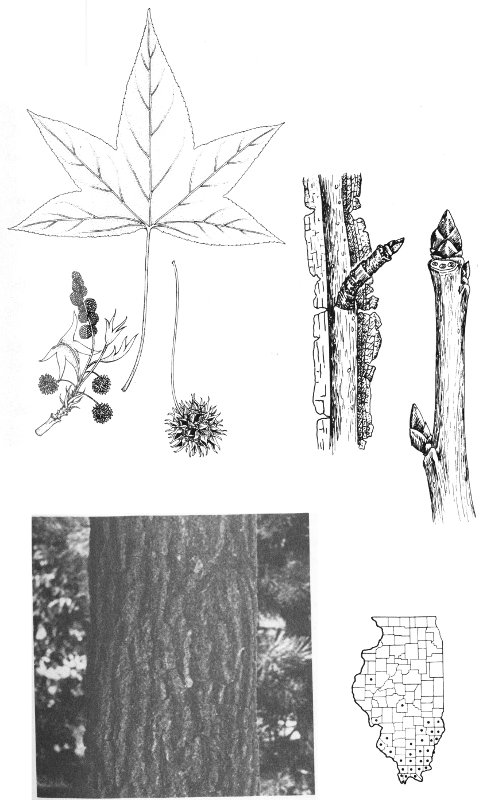
Other Names: Yellow Poplar; Tulip Poplar.
Growth Form: Stately tree up to 100 feet tall; trunk diameter up to 4 feet; crown oblong or pyramidal from a long, columnar trunk.
Bark: Grayish, becoming deeply furrowed at maturity; furrows often whitish within.
Twigs: Smooth, reddish-brown; leaf scars alternate, nearly spherical, with several bundle traces, with stipule scars encircling the twig.
Buds: Flattened, up to 1 inch long, resembling duckbills.
Leaves: Alternate, simple; blades divided into four broad lobes, the upper two lobes usually with a conspicuous notch between them, bright green, averaging 4 to 6 inches long and broad.
Flowers: About two inches long, cup-shaped, with six yellow-green petals with an orange base surrounding a cone-shaped cluster of pistils; opening in May.
Fruit: Dry “cones” about 2½ inches long, composed of several winged seeds.
Wood: Soft, durable.
Uses: Lumber, veneer cores to which other wood can be glued, canoes, frames.
Habitat: Rich soil.
Range: Connecticut and Vermont across to southern Michigan, southwestward across Illinois to Louisiana, east to Central Florida.
Distinguishing Features: The shape of the leaf is unlike that of any other tree in Illinois.
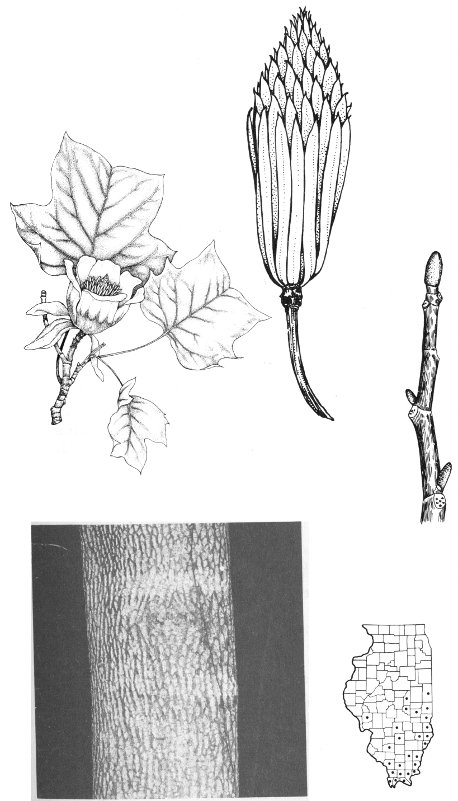
Other Names: Hedge Apple; Bow Wood.
Growth Form: Medium tree to 40 feet tall; trunk diameter up to 1 foot; crown rounded or dome-shaped, with several rather stout, spreading branches.
Bark: Light gray-brown tinged with orange, separating into shaggy strips.
Twigs: Dull orange-brown, smooth, zigzag, with short, sharp, axillary spines; leaf scars alternate, half-round, elevated, with usually 3 groups of bundle traces.
Buds: Round, reddish-brown, smooth, very tiny.
Leaves: Alternate, simple; blades ovate or ovate-lanceolate, long-pointed at the tip, narrowed or a little bit heart-shaped at the base, up to 5 inches long and 3½ inches broad, smooth along the edges, green and smooth on both surfaces; leafstalks smooth, up to 2 inches long.
Flowers: Staminate and pistillate borne on separate trees, yellow-green, very tiny, the staminate crowded in short clusters on stalks up to 4 inches long, the pistillate crowded into spherical heads on short, stout stalks.
Fruit: Large, spherical, greenish-yellow compound fruit up to 6 inches in diameter, containing many seeds, succulent flesh, and milky sap.
Wood: Heavy, hard, flexible, durable, coarse-grained, orange when first cut, becoming brown.
Uses: Bows, fence posts, railroad ties, tool handles; often planted as a windbreak.
Habitat: Hedge-rows, woods.
Range: Native only in Arkansas, Oklahoma, and Texas; commonly planted elsewhere and often escaped from cultivation.
Distinguishing Features: The Osage Orange is distinguished by its spiny branches, its long-pointed, toothless leaves, its milky sap, and its large, spherical, yellow-green fruits.
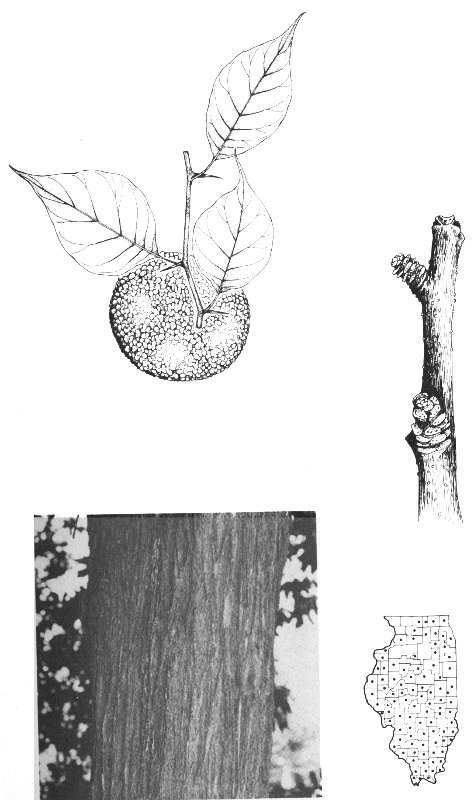
Other Name: Cucumber Tree.
Growth Form: Medium tree up to 75 feet tall; trunk diameter up to 3 feet; crown broadly rounded or pyramidal.
Bark: Gray or brown, with shallow furrows when older.
Twigs: Rather stout, reddish-brown, smooth; leaf scars alternate, U-shaped, with several scattered bundle traces.
Buds: Silvery-white, hairy, up to nearly 1 inch long, with a single bud scale.
Leaves: Alternate, simple; blades usually elliptic, short-pointed at the apex, rounded or tapering to the base, up to 10 inches long and more than half as broad, entire along the edges, yellow-green and smooth on the upper surface, paler and sometimes hairy on the lower surface.
Flowers: Greenish-yellow, up to 3 inches long, with usually 6 elongated, pointed petals, appearing in April.
Fruit: Oblong fruits up to 3 inches long, deep red, with several seeds. Young fruits look like small cucumbers, thus accounting for the common name. The fruits ripen from late August to October.
Wood: Light weight, soft, pale brown.
Uses: Cabinets, flooring.
Habitat: Rich woodlands.
Range: New York to southern Illinois and Oklahoma, south to Louisiana and Georgia, also southern Ontario.
Distinguishing Features: The large toothless leaves are distinctive from leaves of all other Illinois trees except the Tupelo Gum, a tree of swamps which usually had 1-3 coarse teeth along the edges of each leaf. The silvery buds are also distinctive, as are the flowers and fruits.
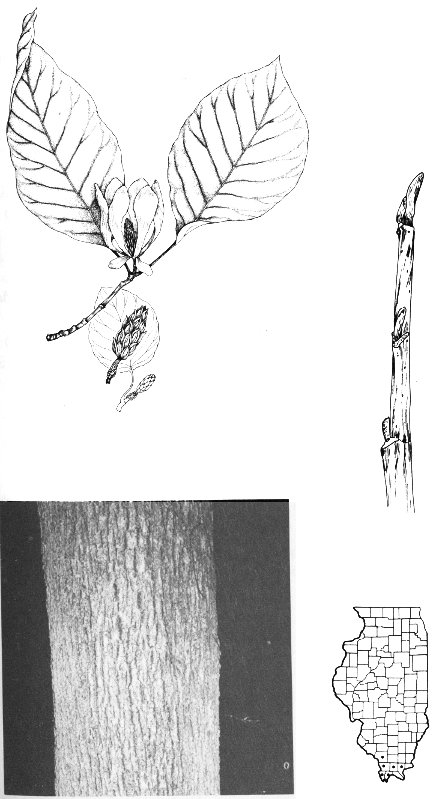
Growth Form: Small tree to 20 feet tall; trunk diameter up to 9 inches; crown spreading.
Bark: Reddish-brown, deeply furrowed, scaly.
Twigs: Slender, reddish-brown or pale brown, smooth, sometimes spur-like; leaf scars alternate, narrow, curved, with 3 bundle traces.
Buds: Rounded, brown, up to ¹/₁₆ inch in diameter, finely hairy.
Leaves: Alternate, simple; blades elliptic to oblong, rounded or pointed at the tip, narrowed to the base, to 2 inches long, less than half as broad, toothed along the edges, seldom shallowly lobed, green and smooth on the upper surface, a little paler and smooth or sparsely hairy on the lower surface; leafstalks slender, up to 1 inch long, smooth or hairy.
Flowers: Showy, up to 1 inch across, on long stalks, usually 3 or more in a cluster, with 5 narrow, rose petals, appearing during May and June.
Fruit: Apples up to 1 inch across, yellow-green, edible.
Wood: Heavy, close-grained, brown.
Use: The fruit is used in making jelly.
Habitat: Rather moist woods.
Range: Maryland across to southern Missouri, south to Louisiana, east to Florida.
Distinguishing Features: This crab apple is distinguished by its narrow leaves which are usually unlobed.
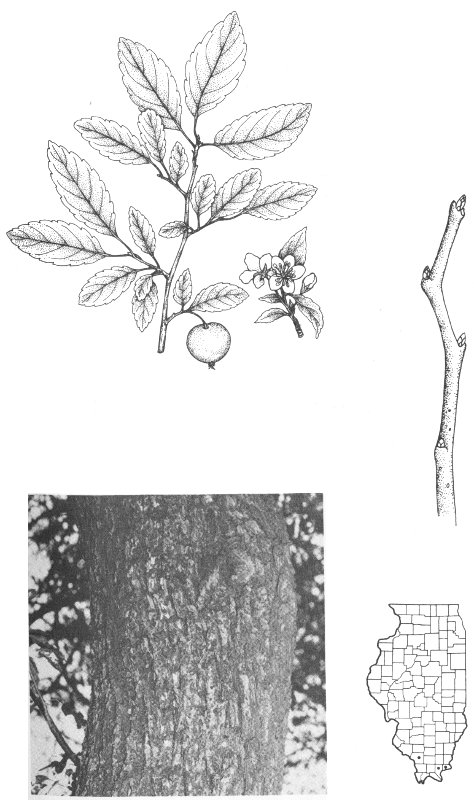
Growth Form: Small tree to 25 feet tall; trunk diameter up to 1 foot; crown widely spreading.
Bark: Gray-brown to red-brown, with rather deep furrows between the scales.
Twigs: Moderately stout, reddish-brown, often spurlike, sometimes spiny, usually smooth at maturity; leaf scars alternate, narrow, curved, with 3 bundle traces.
Buds: Rounded, reddish, about ¼ inch in diameter, smooth or nearly so.
Leaves: Alternate, simple; blades oval, rounded to short-pointed at the tip, rounded or tapering to the base, up to 3 inches long, about half as broad, toothed along the edges and sometimes slightly lobed, yellow-green and smooth on the upper surface, paler on the lower surface; leafstalks stout, up to 2 inches long, smooth or hairy.
Flowers: Showy, up to 1½ inches across, on long stalks, usually 3 or more in a cluster, with 5 rounded, white or pinkish petals, appearing during May and June.
Fruit: Apples up to 1 inch across, yellow-green, edible.
Wood: Heavy, close-grained, reddish-brown.
Uses: Wood is used for tool handles; crab apples used in making jelly.
Habitat: Woods; edge of fields; edge of prairies.
Range: New York and southern Ontario across to Wisconsin, south to Kansas, Tennessee, and North Carolina.
Distinguishing Features: The Prairie Crab Apple differs from the Narrow-leaved Crab Apple by its broader leaves and from the Iowa Crab Apple by its usually less-lobed leaves and smooth flowers.
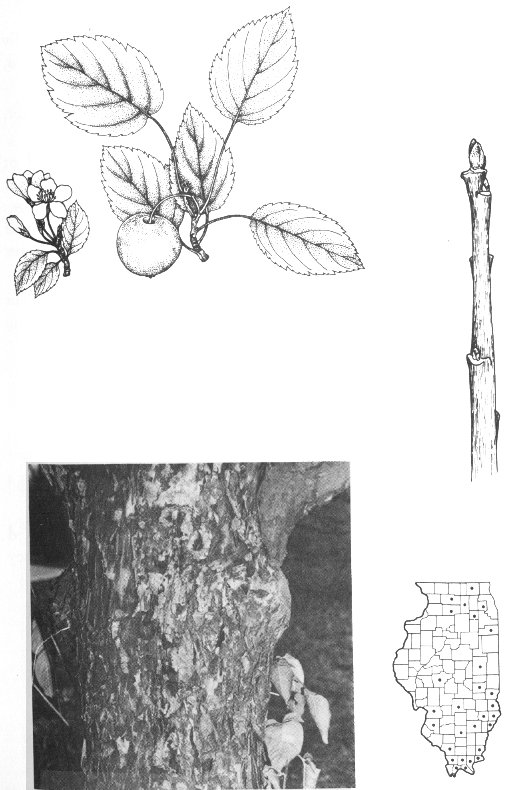
Growth Form: Small tree to 25 feet tall; trunk diameter up to 1 foot; crown spreading.
Bark: Reddish-brown, scaly.
Twigs: Moderately stout, reddish-brown, sometimes spiny, usually somewhat hairy at maturity; leaf scars alternate, narrow, curved, with 3 bundle traces.
Buds: Rounded, reddish-brown, less than ⅛ inch in diameter, finely hairy.
Leaves: Alternate, simple; blades elliptic to oval, rounded or pointed at the tip, rounded or tapering to the base, up to 4½ inches long and less than half as broad, toothed along the edges and often shallowly lobed, dark green and smooth on the upper surface, yellow-green and usually somewhat hairy on the lower surface; leafstalks stout, up to 1 inch long, hairy.
Flowers: Showy, up to 2 inches across, on long stalks, usually 3 or more in a cluster, with 5 rounded, white or rose petals, appearing during May and June.
Fruit: Apples up to 1¾ inches across, yellow-green, edible.
Wood: Heavy, close-grained, brown.
Use: The fruit is used in making jelly.
Habitat: Edges of prairies and fields.
Range: Wisconsin and Minnesota, south to Nebraska, Texas, and Louisiana.
Distinguishing Features: The Iowa Crab Apple is distinguished from the other crab apples in the state by the greater frequency of lobed leaves and by its hairy flowers.
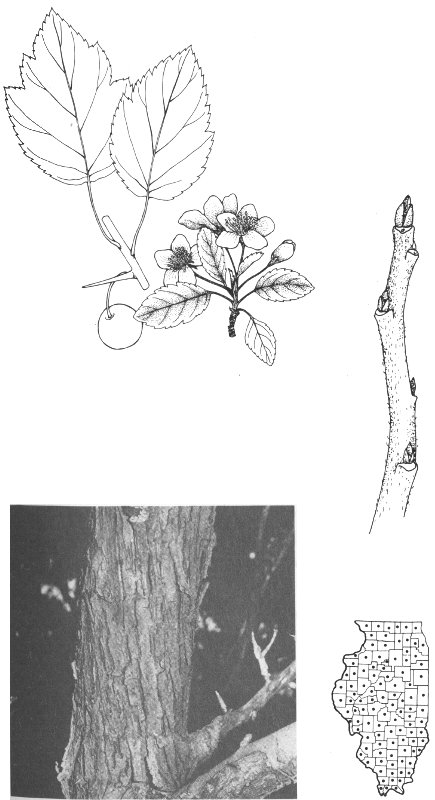
Growth Form: Medium tree up to 50 feet tall; trunk diameter up to 2 feet; crown broadly rounded, with many short branchlets.
Bark: Light brown, sometimes tinted with orange, divided into long, scaly plates.
Twigs: Slender, yellowish, smooth or sometimes hairy, more or less zigzag; leaf scars alternate, half-round, elevated, with numerous bundle traces.
Buds: Pointed, reddish-brown, smooth, about ⅙ inch long.
Leaves: Alternate, simple; blades ovate, short-pointed at the tip, rounded or cut straight across at the base, up to 5 inches long and nearly as broad, coarsely round-toothed, sometimes 2-lobed, sometimes 3-lobed, sometimes deeply several-lobed, sometimes unlobed, green and smooth to the touch on the upper surface, paler and smooth on the lower surface, except for a few hairs sometimes on the veins; leafstalks up to 2 inches long, smooth.
Flowers: Staminate and pistillate flowers borne separately, either on the same tree or on different trees, appearing as the leaves unfold, the staminate crowded into narrow green clusters up to 2 inches long, the pistillate crowded into short, thick spikes up to 1 inch long.
Fruit: A cluster of tiny drupes up to 1¼ inches long, white or pinkish, more rarely red or purple, sweet, juicy.
Wood: Light in weight, soft, coarse-grained, orange-brown.
Uses: Fence posts; the fruit is edible.
Habitat: Woods, along roads, in disturbed areas.
Range: Native of Asia; naturalized from Maine to Minnesota, south to Texas, east to Georgia.
Distinguishing Features: The White Mulberry lacks hairs on the lower surface of the leaves (except sometimes along the veins), thus differing from the Red Mulberry.

Growth Form: Medium tree up to 50 feet tall; trunk diameter up to 2 feet; crown broadly rounded, with many short branchlets.
Bark: Dark brown, divided into long, scaly plates.
Twigs: Slender, smooth or sometimes hairy, reddish-brown to dark brown, more or less zigzag; leaf scars alternate, half-round, elevated, with numerous bundle traces.
Buds: Pointed, brown, smooth, up to ¼ inch long.
Leaves: Alternate, simple; blades mostly ovate, abruptly pointed at the apex, more or less heart-shaped at the base, up to 6 inches long and sometimes nearly as broad, coarsely toothed, sometimes 2-lobed, sometimes 3-lobed, often unlobed, green and usually rough to the touch on the upper surface, paler and with short white hairs on the lower surface; leafstalks up to 1½ inches long, smooth at maturity. The leaves turn yellow in the autumn.
Flowers: Staminate and pistillate flowers borne separately, either on the same tree or on different trees, appearing as the leaves unfold, the staminate crowded into narrow, green clusters up to 2 inches long, the pistillate crowded into short, thick spikes up to 1 inch long.
Fruit: A cluster of tiny drupes up to 1½ inches long, at first red, becoming purple or nearly black, rarely remaining pale, sweet, juicy.
Wood: Light in weight, soft, durable, coarse-grained, orange-brown.
Uses: Fence posts and barrels; the fruit is edible.
Habitat: Woods, particularly along streams.
Range: Vermont across to Minnesota and South Dakota, south to Texas, east to Florida.
Distinguishing Features: Red Mulberry differs from White Mulberry in the presence of some hairs on the lower surface of the leaves.

Other Names: Swamp Tupelo; Water Tupelo; Cotton Gum.
Growth Form: Large tree up to 85 feet tall; trunk diameter up to 4 feet, often swollen at the base; crown spreading, with numerous branchlets.
Bark: Light gray to dark gray to brown, broken into thin scales.
Twigs: Stout, more or less angular, gray or brown, smooth; leaf scars alternate, broadly U-shaped, with 3 bundle traces.
Buds: Rounded, smooth, about ⅛ inch long.
Leaves: Alternate, simple; blades oblong to somewhat ovate, pointed at the tip, tapering to rounded to even heart-shaped at the base, up to 8 inches long and about half as broad, the edges smooth or with a few coarse teeth, dark green, shiny, smooth or somewhat hairy on the upper surface, paler and soft-hairy on the lower surface; leafstalks stout, up to 3 inches long, hairy.
Flowers: Staminate and pistillate borne on separate trees, appearing as the leaves begin to unfold, greenish, small, the staminate several in spherical clusters, the pistillate solitary on long stalks arising from the leaf axils.
Fruit: Fleshy, oblong, dark purple with pale speckles, up to 1 inch long, bitter, 1-seeded, ripening in September.
Wood: Light in weight, soft, close-grained, pale brown.
Uses: Paper pulp, broom handles, floors.
Habitat: Swamps and low woods.
Range: Virginia to southern Missouri, south to Texas, east to Florida.
Distinguishing Features: The Tupelo Gum is characterized by its large, irregularly toothed leaves and its oblong, purple fruits.
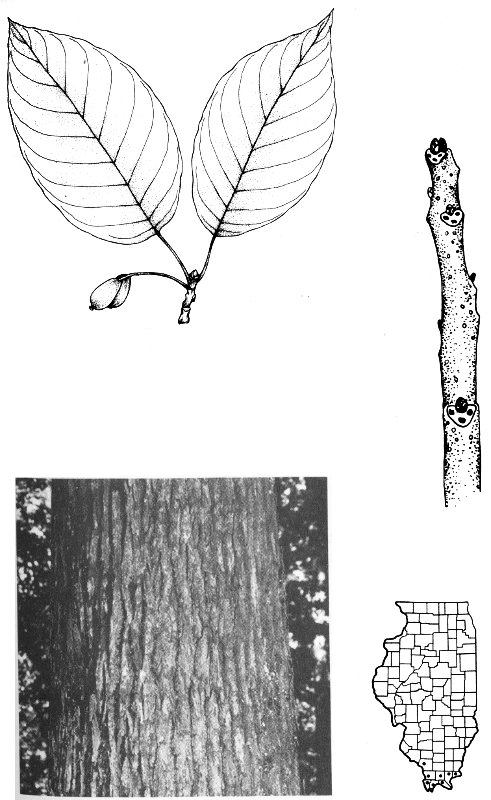
Other Name: Black Gum.
Growth Form: Medium to large tree to 75 feet tall; trunk diameter up to 3 feet; crown rounded, often with many small, drooping branchlets.
Bark: Brown to black, often broken up into squarish blocks.
Twigs: Rather stout, reddish-brown, smooth, sometimes zigzag; leaf scars alternate, crescent-shaped, with 3 bundle traces. The pith is continuous but marked with distinct partitions.
Buds: Short-pointed, yellowish or reddish, smooth, about ⅛ inch long.
Leaves: Alternate, simple; blades abruptly pointed at the tip, tapering or rounded at the base, up to 6 inches long and usually about half as wide, smooth or with a few coarse teeth along the edges, dark green, shiny, and usually smooth on the upper surface, paler and usually somewhat hairy on the lower surface; leafstalks up to 1½ inches long, smooth or sparsely hairy. The leaves turn scarlet in the autumn.
Flowers: Staminate and pistillate borne on separate trees, appearing after the leaves begin to unfold, greenish, very small, the staminate several in spherical clusters, the pistillate 2-several on long stalks arising from the leaf axils.
Fruit: Fleshy, oval, dark blue, up to ⅔ inch long, bitter, 1-seeded, ripening in October.
Wood: Heavy, strong, soft, not durable, pale yellow.
Uses: Pulpwood, gun-stocks, flooring; sometimes used as an ornamental.
Habitat: Dry wooded slopes, low woods.
Range: Maine across to Michigan and Wisconsin, south to Missouri and Texas, east to Florida.
Distinguishing Features: Sour Gum is easily confused with Persimmon, but differs by its leaves which are abruptly short-pointed at the tip, and by its twigs which have continuous pith marked by distinct partitions.
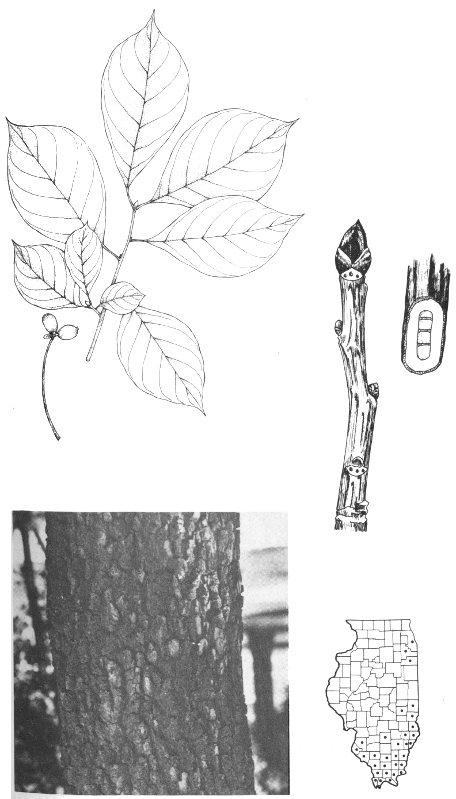
Other Name: Ironwood.
Growth Form: Small tree up to 35 feet tall; trunk diameter up to 1 foot; crown usually rounded.
Bark: Brown and scaly at maturity.
Twigs: Slender, reddish-brown, sometimes hairy, tough to break; leaf scars alternate, crescent-shaped, slightly elevated, with 3 bundle traces.
Buds: Small, pointed at the tip.
Leaves: Alternate, simple; blades elliptic to ovate, pointed at the tip, rounded or tapering to the base, up to 5 inches long, finely doubly toothed, green and usually smooth on the upper surface, paler and usually slightly hairy on the lower surface; leafstalks up to ¼ inch long, hairy.
Flowers: Staminate and pistillate borne separately but on the same tree. The staminate catkins are on the tree through the winter before opening in late April or May.
Fruit: Nutlets enclosed by an inflated bladder, crowded together in a cluster resembling hops.
Wood: Hard, strong, durable.
Use: Tool handles.
Habitat: Upland woods; rocky slopes; along streams.
Range: Nova Scotia across to Manitoba and northeastern Wyoming, south to eastern Texas and northern Florida.
Distinguishing Features: The Blue Beech, with similar leaves, differs by its scaly bark. Elms, which also have somewhat similar leaves, usually have their leaves asymmetrical at the base.
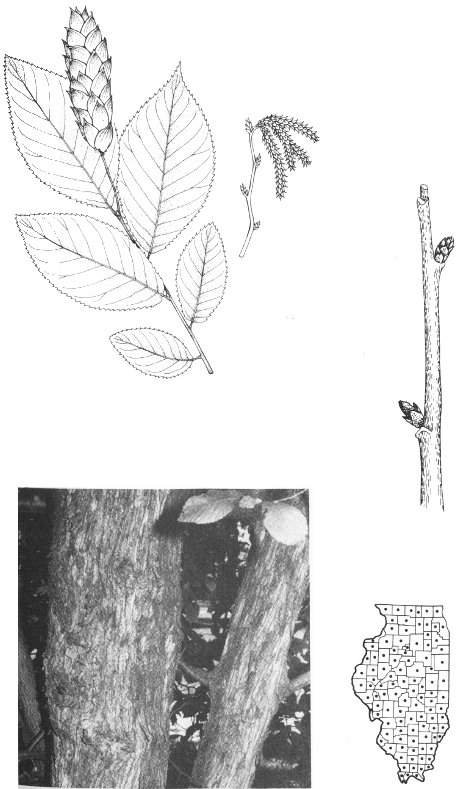
Other Name: Paulownia.
Growth Form: Small to medium tree to 45 feet tall; trunk diameter up to 1½ feet; crown rounded.
Bark: Gray, more or less smooth.
Twigs: Stout, grayish, finely hairy; leaf scars opposite, nearly spherical but with a notch at the top, with many bundle traces in a ring.
Buds: Half-round, minutely hairy.
Leaves: Opposite, simple; blades mostly heart-shaped, tapering to a short point at the tip, up to about 10 inches long and nearly as broad, smooth along the edges, minutely hairy on both surfaces.
Flowers: Large, showy, fragrant, several in a large cluster, appearing in late April or early May, the clusters sometimes a foot long, each flower up to 2 inches long, the petals violet with yellow stripes.
Fruit: Ovoid capsules up to 1½ inches long, pointed at the tip, brown, containing numerous winged seeds.
Use: Popular as an ornamental because of its handsome flowers.
Habitat: Along roads, around home sites.
Range: Native of Asia; occasionally escaped in the eastern United States.
Distinguishing Features: The leaves of the Princess Tree resemble those of the Catalpa, but they are always opposite and never in whorls. The violet flowers and the short, ovid capsules further distinguish the Princess Tree.

Other Names: Gray Pine; Scrub Pine.
Growth Form: Medium tree to 75 feet tall in some parts of the United States; trunk diameter up to 2½ feet; crown open but often irregular.
Bark: Reddish-brown, rough and scaly.
Twigs: Slender, dark brown, becoming roughened.
Leaves: Needles in clusters of 2, stiff, curved, up to 1½ inches long, dark green.
Flowers: Staminate crowded into several yellow spikes up to ½ inch long; pistillate crowded into few to several purple clusters.
Fruit: Cones oblong, curved, upright, up to 2 inches long, each scale comprising the cone bearing a small curved prickle; seeds triangular, up to ¹/₁₂ inch long, with a wing up to ⅓ inch long.
Wood: Light in weight, soft, reddish-brown.
Uses: Railroad ties, fence posts, fuel, pulpwood.
Habitat: Rocky woods.
Range: Quebec across to Yukon, south to Minnesota, northern Illinois, and New York, Nova Scotia.
Distinguishing Features: The Jack Pine is distinguished by its short, stiff, curved needles in clusters of 2 and by its short, curved cones.
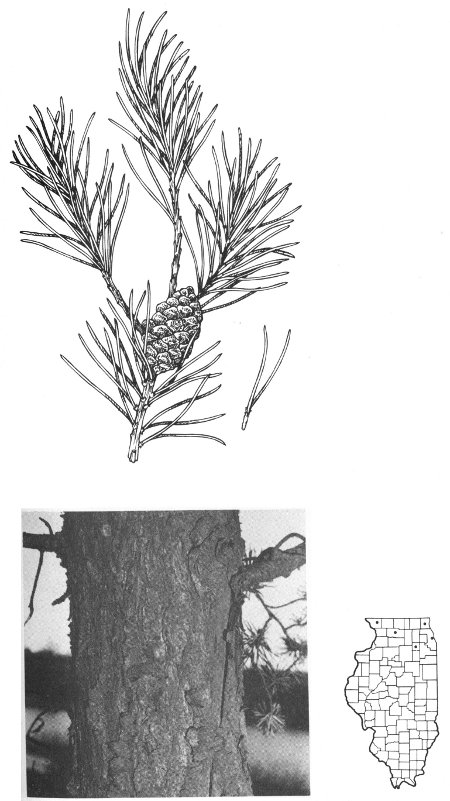
Other Name: Yellow Pine.
Growth Form: Large tree to 80 feet tall; trunk diameter up to 2 feet; crown pyramidal or rounded.
Bark: Reddish-brown, broken into large plates.
Twigs: Slender, reddish-brown, becoming shreddy.
Leaves: Needles in clusters of both 2 and 3 on the same tree, flexible, up to 5 inches long, dark green.
Flowers: Staminate crowded into several pale purple spikes up to ¾ inch long; pistillate in groups of 1-3, rose-colored.
Fruit: Cones 1-3 in a group, ovoid, up to 2½ inches long, each scale comprising the cone often bearing a small sharp prickle on the back; seeds triangular; less than ¼ inch long, with an asymmetrical curved wing up to ½ inch long.
Wood: Hard, heavy, coarse-grained, reddish-brown.
Uses: Interior finishing, paper pulp, construction.
Habitat: Dry, rocky slopes; widely planted in a variety of sites.
Range: Southern New York across Pennsylvania and southern Illinois to Oklahoma, south to Texas, east to northern Florida.
Distinguishing Features: Shortleaf Pine is distinguished by its needles which may be in clusters of 2 and 3 on the same tree.
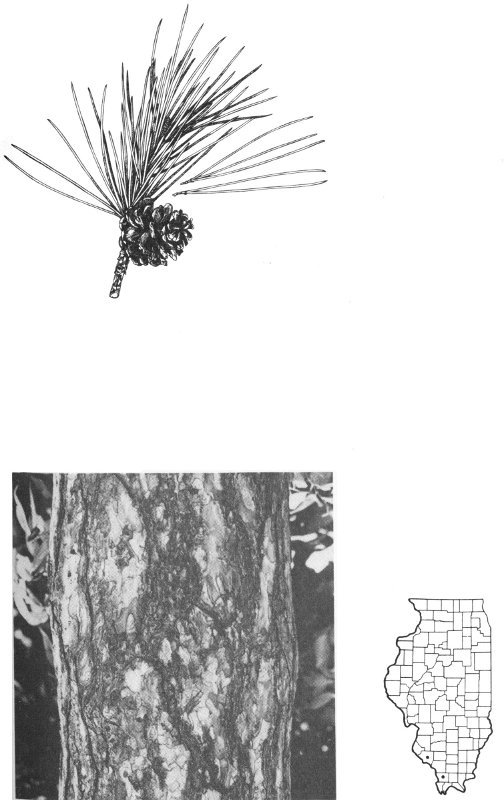
Growth Form: Medium to large tree to 150 feet tall; trunk diameter up to 3 feet; crown pyramidal.
Bark: Reddish-brown, divided irregularly into plates.
Twigs: Stout, reddish-brown, becoming roughened.
Leaves: Needles in clusters of 2, flexible, up to 6 inches long, dark green.
Flowers: Staminate crowded into several purple spikes up to ½ inch long; pistillate crowded into fewer scarlet clusters.
Fruit: Cones ovoid, mostly straight, up to 2 inches long, each scale comprising the cone without any prickles; seeds triangular, up to ⅛ inch long, with a wing up to ¾ inch long.
Wood: Rather hard, heavy, close-grained, reddish-brown.
Uses: Ships, bridges, general construction.
Habitat: Dry, rocky woods.
Range: Newfoundland across to Manitoba, south to Minnesota, Michigan, Pennsylvania, and New Jersey; also north-central Illinois and West Virginia.
Distinguishing Features: The Red Pine is distinguished by its dark green needles usually clustered near the tips of the twigs.
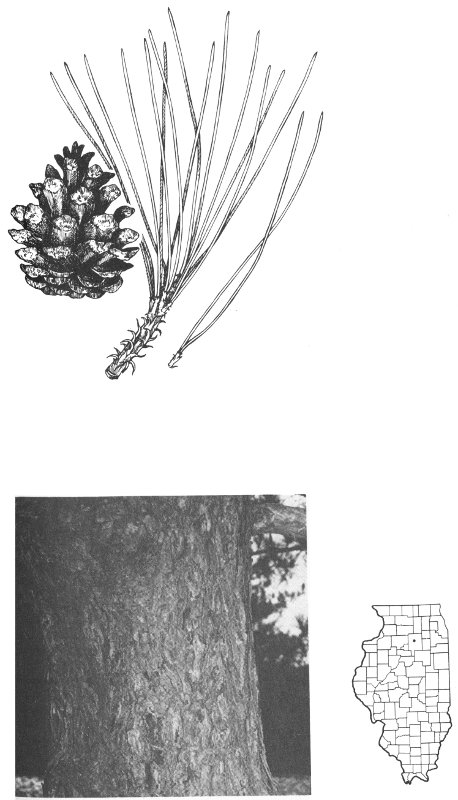
Growth Form: Tall tree well over 100 feet tall in some regions of the United States; trunk diameter sometimes in excess of 3 feet; crown pyramidal.
Bark: Brown, divided into broad ridges by shallow fissures.
Twigs: Slender, orange-brown, smooth or slightly hairy.
Leaves: Needles in clusters of 5, very flexible, up to 5 inches long, blue-green.
Flowers: Staminate crowded into several yellow spikes up to ⅓ inch long; pistillate crowded into fewer groups, pink to purple.
Fruit: Cones oblong, curved, drooping, up to 8 inches long, each scale comprising the cone lacking any prickles; seeds narrowly oblong, up to ¼ inch long, with a wing up to ¾ inch long.
Wood: Light in weight, soft, light brown.
Uses: Interior finishing, construction.
Habitat: Moist woods, wooded slopes.
Range: Newfoundland across to Manitoba, south to Iowa, northern Illinois, and in the Appalachian Mountains to northern Georgia.
Distinguishing Features: The soft, blue-green needles in clusters of 5 readily distinguish the White Pine.
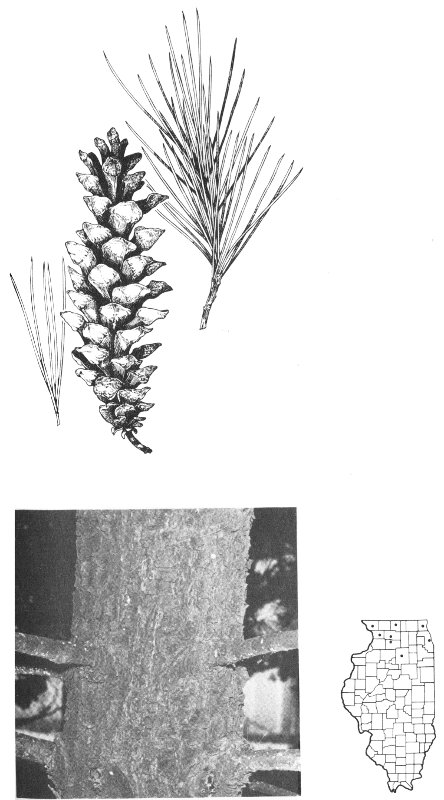
Growth Form: Medium tree to 65 feet tall; trunk diameter up to 2 feet; crown irregular.
Bark: Large branches reddish-brown, broken into plates.
Twigs: Slender, brown, roughened.
Leaves: Needles in clusters of 2, stiff, to 3 inches long, gray-green.
Flowers: Staminate crowded into several yellow spikes up to ½ inch long; pistillate crowded into 1 to several clusters.
Fruit: Cones narrowly ovoid, to 2½ inches long, each scale comprising the cone without any prickles.
Uses: Often planted as an ornamental, Christmas trees.
Habitat: Planted in plantations in Illinois, rarely escaped.
Range: Native of Europe; widely planted in the eastern United States.
Distinguishing Features: The rather short, stiff, gray-green needles in clusters of 2 distinguish this pine.
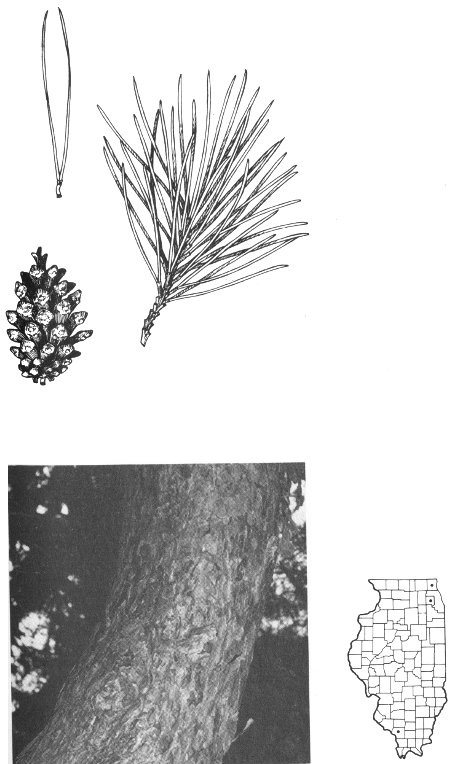
Other Name: Old-field Pine.
Growth Form: Large tree sometimes over 125 feet tall; trunk diameter up to 2 feet; crown rounded.
Bark: Reddish-brown, divided into irregular plates.
Twigs: Slender, brown, becoming roughened.
Leaves: Needles in clusters of 3 or occasionally 2, stiff, up to 9 inches long, light green.
Flowers: Staminate crowded into several yellow spikes up to ½ inch long; pistillate crowded into 1 to several yellow clusters.
Fruit: Cones ovoid to oblong, mostly straight, up to 6 inches long, each scale comprising the cone with a short, sharp prickle; seeds rounded, up to ¼ inch long, with a wing up to 1 inch long.
Wood: Weak, brittle, coarse-grained, yellow-brown.
Uses: Pulpwood, construction.
Habitat: Planted in plantations in Illinois, rarely escaped.
Range: New Jersey to Tennessee, south across Arkansas to eastern Texas, east to central Florida; not native in Illinois.
Distinguishing Features: The Loblolly Pine is distinguished by its stiff, long needles usually in clusters of 3 and by its long cones. It is similar to Shortleaf Pine but has longer needles and cones.
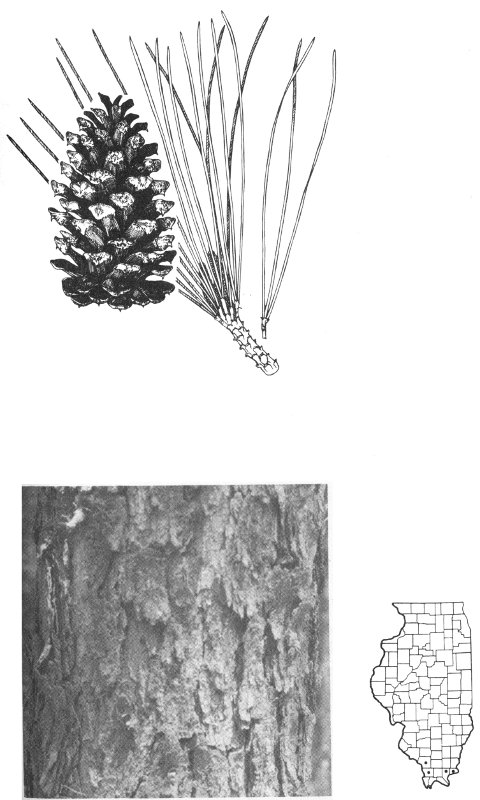
Other Name: Planer-tree.
Growth Form: Small tree to 30 feet tall; trunk diameter up to 10 inches; crown broadly rounded, with slender branchlets.
Bark: Gray or pale brown, smooth at first but later splitting into large scales.
Twigs: Slender, reddish-brown to gray, usually smooth; leaf scars alternate, nearly circular, each with 3 bundle traces.
Buds: Slender, pointed, brownish, smooth or somewhat hairy, up to ¼ inch long.
Leaves: Alternate, simple; blades lance-ovate, rounded or somewhat pointed at the tip, tapering to the usually asymmetrical base, up to 3 inches long, less than half as broad, regularly coarsely toothed, smooth or a little roughened on the upper surface at maturity, smooth or hairy on the lower surface; leafstalks up to ½ inch long, finely hairy.
Flowers: Of three kinds, all on the same tree, appearing after the leaves have begun to expand, greenish-yellow, without petals, the staminate in several small clusters, the pistillate and perfect in drooping clusters of 1-3 flowers.
Fruit: Oblong, fleshy, up to ½ inch long, with warts irregularly scattered over the surface, pale brown.
Wood: Soft, light in weight, close-grained, pale brown.
Uses: Fence posts, fuel.
Habitat: Swampy areas.
Range: North Carolina across southern Illinois to southeastern Missouri, south to Texas, east to Florida.
Distinguishing Features: The Water Elm resembles other native elms in Illinois, but has only single-toothed leaves. The warty fruits are also distinctive.
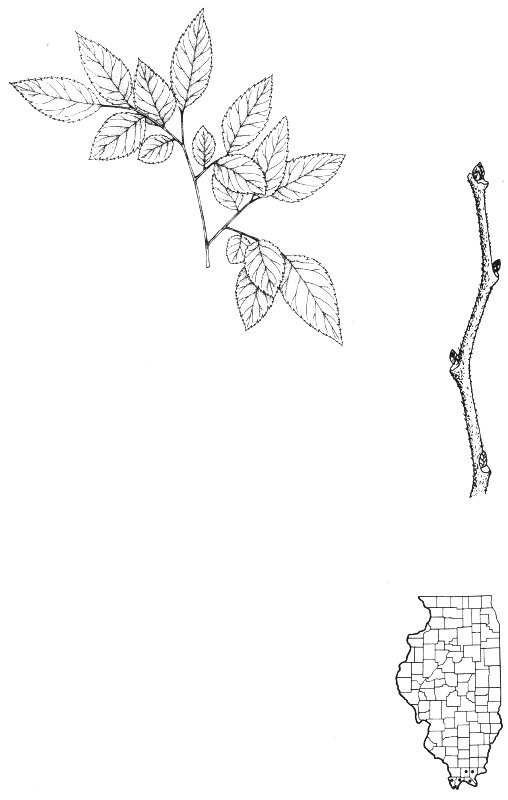
Other Names: Buttonwood; Plane-tree.
Growth Form: Large tree sometimes more than 100 feet tall; trunk diameter up to 8 feet; crown broad, often irregular.
Bark: Reddish-brown when young, quickly breaking into thin, flat scales, falling away in sections to expose large patches of whitish or greenish inner bark.
Twigs: Smooth, light brown, somewhat zigzag; leaf scars alternate, encircling the buds, somewhat elevated, with 5-7 bundle traces.
Buds: Light brown, pointed, about one-fourth inch long, entirely covered by the base of the leafstalk. When the leaves fall off, exposing the buds, they leave a scar which surrounds the base of each bud.
Leaves: Alternate, simple; blades circular in outline but divided into 3 or 5 shallow, sharp-pointed lobes, heart-shaped or cut straight across at the base, up to 7 inches long (longer on vigorous shoots) and often as broad, bright green and smooth on the upper surface, paler and smooth on the lower surface except for the sparsely hairy veins; leafstalks to 5 inches long, slightly hairy; stipules, resembling the leaves but only about an inch long, often persist near the base of the leafstalks.
Flowers: Staminate and pistillate flowers borne separately but on the same tree, minute, crowded together in dense, round heads.
Fruit: Round light brown heads, about one inch in diameter, on long drooping stalks, containing many small seeds surrounded by hairs.
Wood: Hard and strong.
Uses: Furniture, interior finishing. Sometimes planted as an ornamental because of its rapid growth and unusual bark.
Habitat: Bottomlands, along streams, around lakes and ponds.
Range: Maine across southern Wisconsin to eastern Nebraska, south to eastern Texas, east to northern Florida.
Distinguishing Features: The large palmately lobed leaves and the brown and gray mottled bark readily distinguish this tree.
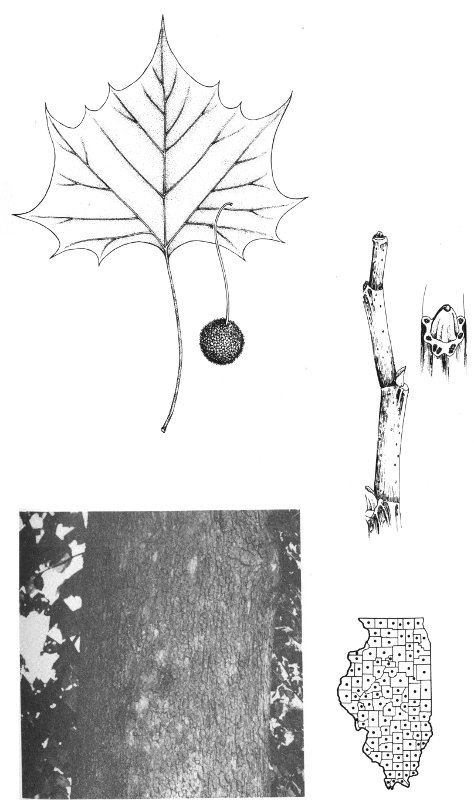
Other Names: Silver-leaved Poplar; Abele.
Growth Form: Moderate tree to 50 feet tall; trunk diameter up to 2 feet; crown broadly rounded but often irregular.
Bark: Grayish to whitish, at first smooth, later becoming deeply fissured and very dark gray to nearly black.
Twigs: Greenish-gray, white-hairy at least when young; leaf scars alternate, crescent-shaped, each with 3 bundle traces.
Buds: Ovoid, pointed, hairy, up to ⅛ inch long.
Leaves: Alternate, simple; blades usually ovate, with a few broad teeth along the edges, bluntly pointed at the tip, cut straight across or a little heart-shaped at the base, up to 4 inches long, dark green on the upper surface, silvery-hairy or white-wooly on the lower surface; leafstalks up to 3 inches long, densely hairy, not flat.
Flowers: Staminate and pistillate borne on separate trees, crowded together in catkins, appearing when the leaves unfold.
Fruit: Often curved, flask-shaped capsules, greenish, hairy, up to ¼ inch long, containing many seeds with cottony hairs attached.
Wood: Light weight, soft.
Use: Grown as an ornamental because of its silvery leaves.
Habitat: Along roads, around old homesteads.
Range: Native of Europe and Asia; frequently planted and escaped from cultivation in the United States.
Distinguishing Features: The leaves, with their silvery or white-wooly under-surface and their few broad teeth, provided the best means of identifying this tree.
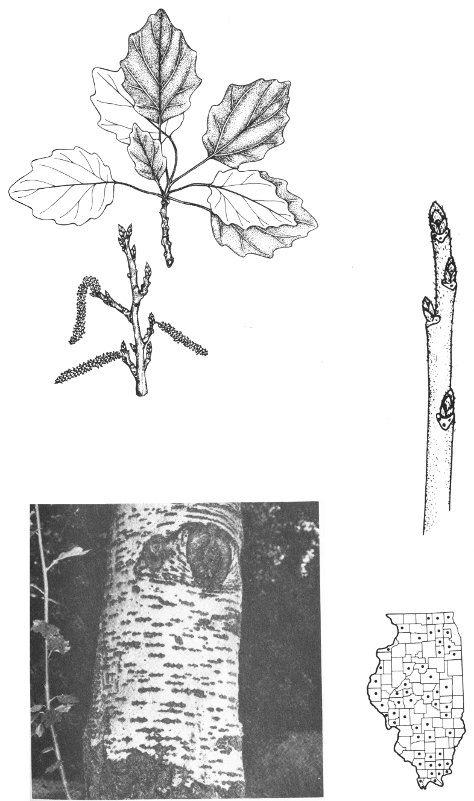
Growth Form: Large rapidly growing tree up to 100 feet tall; trunk diameter up to eight feet; crown spreading or broadly rounded, with some drooping branches. The largest tree in Illinois, in Grundy County, is a Cottonwood measuring twenty-eight feet six inches in circumference.
Bark: Smooth and gray when young, becoming furrowed at maturity.
Twigs: Yellow-green, gray, or tan, smooth, moderately stout, with numerous pale “dots”; leaf scars alternate, triangular, with 3 large bundle traces.
Buds: Lance-shaped, long-pointed, up to ½ inch long, sticky, chestnut-colored.
Leaves: Alternate, simple; blades to 5 inches long and often nearly as broad, triangular, abruptly pointed at the tip, cut straight across or even slightly heart-shaped at the base, with coarse rounded teeth along the edges, green, smooth, and shiny on the upper surface, paler on the lower surface; leafstalks to 4 inches long, smooth, often yellow, flat.
Flowers: Staminate and pistillate borne on separate trees, the staminate crowded in rather thick, reddish catkins, the pistillate crowded in narrower, greenish-yellow catkins, both sexes appearing before the leaves begin to unfold.
Fruit: Elliptic, greenish-brown capsules up to ¼ inch long, grouped in elongated clusters, containing numerous seeds with cottony hairs attached.
Wood: Light weight, soft, readily warping.
Uses: Pulpwood, fuel.
Habitat: Bottomland woods, along streams.
Range: New Hampshire across to southeastern North Dakota, south central Texas, east to northern Florida.
Distinguishing Features: The Cottonwood is easily recognized by its triangular leaves with flattened leafstalks. The cottony seeds, when the fruits are mature, are also distinctive.
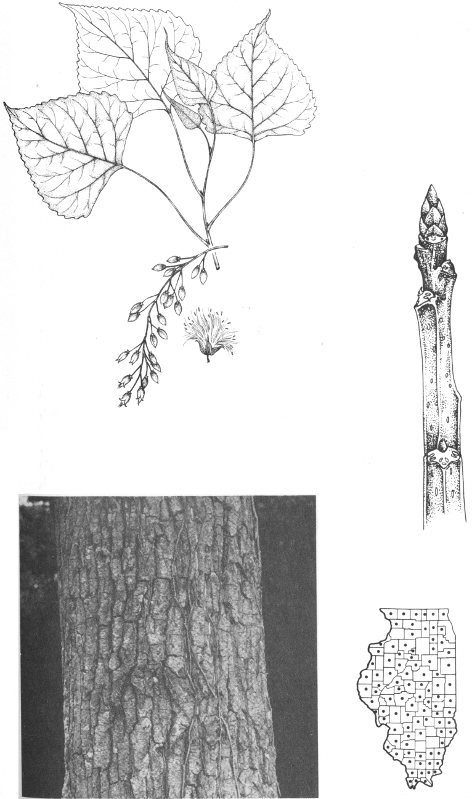
Other Name: Large-tooth Aspen.
Growth Form: Medium tree to 60 feet tall; trunk diameter up to 1½ feet; crown rounded.
Bark: Grayish-green, smooth at first, becoming shallowly fissured and broken up into thin scales.
Twigs: Grayish-green, with numerous orange “dots,” hairy when young but becoming smooth; leaf scars alternate, raised, 3-lobed, each with 3 bundle traces.
Buds: Ovoid, pointed, chestnut-brown, somewhat hairy, up to one-eighth inch long.
Leaves: Alternate, simple; blades nearly circular in outline, short-pointed at the tip, rounded at the base, up to 5 inches long, nearly as broad, with several rather coarse teeth along the edges, green on the upper surface, paler on the lower surface, smooth when mature; leafstalks up to 3 inches long, flat, enabling the leaf to rustle even in gentle breezes.
Flowers: Staminate and pistillate borne on separate trees, crowded together in catkins up to 5 inches long, appearing as the leaves unfold.
Fruit: Long, narrow, flask-shaped, green, slightly hairy capsules, grouped in elongated clusters, containing many seeds with cottony hairs attached.
Wood: Light weight, soft, pale brown.
Use: Pulpwood.
Habitat: Wooded slopes, edges of woods.
Range: Quebec across to Manitoba, south to central Illinois, east to Maryland; Kentucky and north-central Tennessee east to western North Carolina.
Distinguishing Features: The coarsely toothed, tremoring leaves and the grayish-green trunks combine to make this a tree easy to recognize.
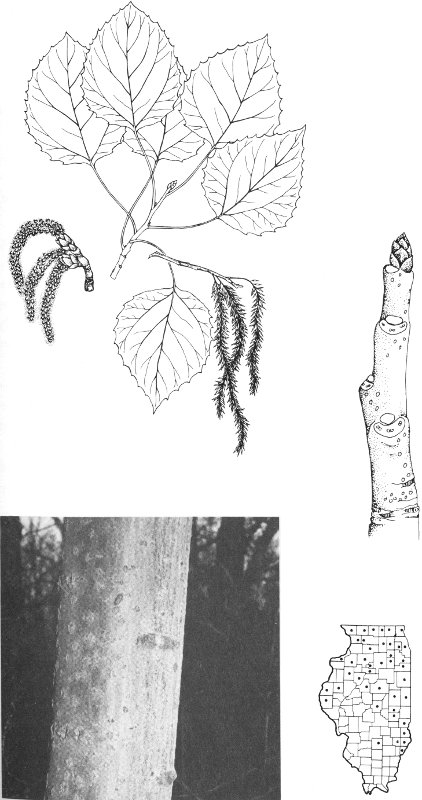
Other Name: Swamp Poplar.
Growth Form: Up to 90 feet tall; trunk diameter up to 2 feet; crown very irregular, with a few, large, upright branches.
Bark: Gray or brown, smooth when young, becoming scaly ridged at maturity.
Twigs: Rather stout, smooth or hairy, reddish; leaf scars alternate, 3-lobed, each with 3 bundle traces; pith 5-angled.
Buds: Ovoid, pointed, dark brown, sticky, up to one-half inch long.
Leaves: Alternate, simple; blades ovate, rounded or bluntly pointed at the tip, heart-shaped at the base, up to 8 inches long, up to 6 inches broad, with rounded teeth along the edges, green on the upper surface, paler on the lower surface, densely white-woolly when young, becoming essentially smooth at maturity; leafstalks to 4 inches long, smooth or sparsely hairy, not flattened.
Flowers: Staminate and pistillate borne on separate trees, the staminate crowded in thick catkins up to 4 inches long, the pistillate in slender catkins up to 6 inches long, both appearing before the leaves begin to unfold.
Fruit: Ovoid, reddish-brown capsules up to ½ inch long, grouped in elongated clusters, containing numerous seeds with cottony hairs attached.
Wood: Light weight, soft, pale brown.
Uses: Pulpwood, fuel, interior finishing.
Habitat: Swamps, low woods.
Range: Connecticut to southern Michigan, southwestward across southern Illinois to central Louisiana, east to northern Florida.
Distinguishing Features: The broad, heart-shaped, toothed leaves readily distinguish the Swamp Cottonwood from other trees in Illinois.

Growth Form: Medium tree up to 50 feet tall; trunk diameter up to 2 feet; crown rounded or occasionally spreading.
Bark: Pale yellow-green or white, becoming grayish and divided into dark scaly ridges at maturity.
Twigs: Pale yellow-green or white, slender, smooth; leaf scars alternate, crescent-shaped, each with 3 bundle traces.
Buds: Lance-shaped, short-pointed, smooth, sticky, up to ⅓ inch long.
Leaves: Alternate, simple; blades ovate to nearly round, short-pointed at the apex, rounded at the base, up to 4 inches long, nearly as broad, with many small round teeth along the edges, green, smooth, and shiny on the upper surface, not shiny on the lower surface; leafstalks to 3 inches long, smooth, flat. The flat leafstalks allow for the leaves to tremor at the slightest wind.
Flowers: Staminate and pistillate borne on separate trees, the staminate crowded in catkins up to 4 inches long, the pistillate crowded in catkins up to 6 inches long.
Fruit: Narrow, flask-shaped, green capsules up to ¼ inch long, grouped in elongated clusters, containing numerous seeds with cottony hairs attached.
Wood: Light weight, soft, pale brown.
Use: Pulpwood.
Habitat: Edge of woods, thickets.
Range: Newfoundland to Alaska, south to California and New Mexico and Texas, east across Missouri and Tennessee to New Jersey.
Distinguishing Features: The whitish trunk and the ovate, trembling leaves serve to distinguish this species.
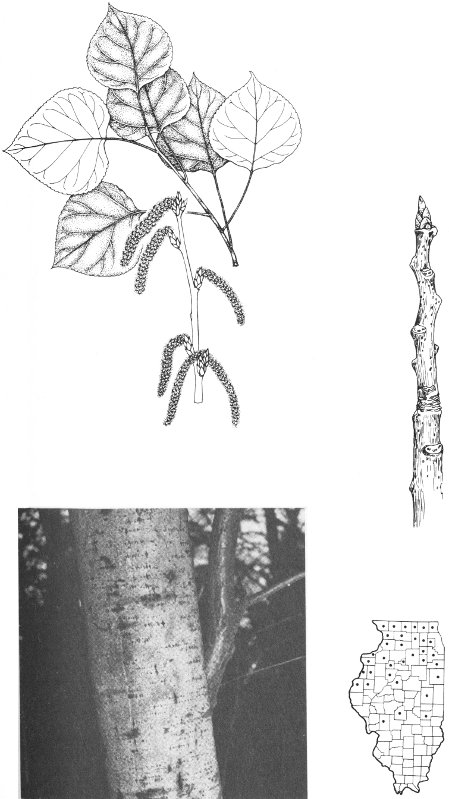
Other Name: American Plum.
Growth Form: Small tree to 20 feet tall; trunk diameter up to 8 inches; crown broad, often irregular.
Bark: Dark gray to brown, rough and scaly.
Twigs: Slender, brown, speckled with many dots, smooth or hairy; leaf scars alternate, half-round, elevated, with 3 bundle traces.
Buds: Ovoid, pointed, reddish-brown, smooth or hairy, up to ¼ inch long.
Leaves: Alternate, simple; blades oval to ovate, pointed at the tip, rounded or tapering to the base, up to 4 inches long and less than half as broad, finely toothed along the edges, the teeth not glandular, green and smooth or hairy on the upper surface, paler and smooth or hairy on the lower surface; leafstalks slender, up to 1 inch long, sometimes with 1 or 2 glands near the upper end, smooth or hairy.
Flowers: Showy, several in a cluster, up to 1 inch across, with 5 white or pinkish petals, appearing before or as the leaves begin to unfold.
Fruit: Spherical or nearly so, up to 1 inch in diameter, red or covered with a whitish wax, juicy, sweet, 1-seeded.
Wood: Hard, close-grained, brown.
Uses: The fruits are used in making jelly and preserves.
Habitat: Woods, thickets.
Range: Southern Ontario to Manitoba, south to New Mexico, east to Florida.
Distinguishing Features: The Wild Plum differs from other plums in Illinois by the absence of glands on the teeth of the leaves. The Wild Plum may have either smooth or hairy leaves and twigs.
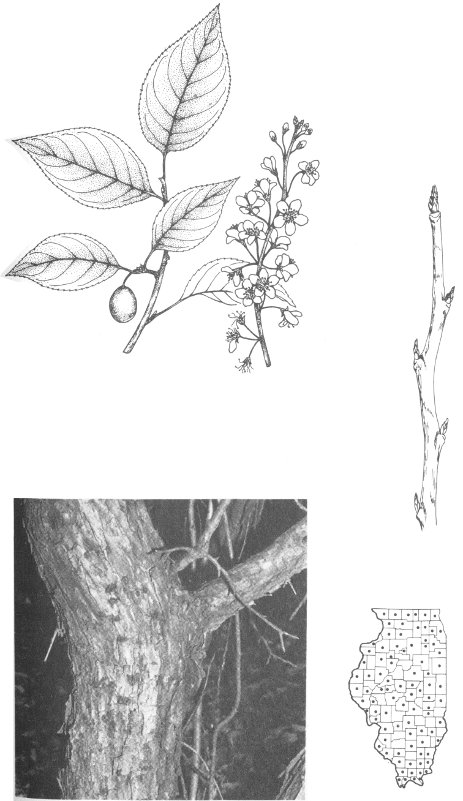
Growth Form: Small tree to 20 feet tall; trunk diameter up to 8 inches; crown broad and rounded.
Bark: Gray or brown, becoming scaly at maturity.
Twigs: Slender, reddish-brown, smooth; leaf scars alternate, half-round, elevated, with 3 bundle traces.
Buds: Ovoid, rounded at the tip, reddish-brown, smooth, up to ¼ inch long.
Leaves: Alternate, simple; blades oblong to oval, pointed at the tip, rounded or tapering to the base, up to 6 inches long and about ⅓ as broad, finely toothed along the edge, the teeth gland-tipped, green and usually smooth on the upper surface, paler and sometimes hairy on the lower surface; leafstalks slender, up to 1 inch long, with 1-several glands, smooth or sparsely hairy.
Flowers: Showy, several in a cluster, up to 1 inch across, with 5 white petals, appearing after the leaves are partly grown.
Fruit: Spherical or nearly so, up to 1 inch in diameter, red or rarely yellowish, fleshy but hard, bitter, 1-seeded.
Wood: Hard, close-grained, brown.
Habitat: Edges of woods, thickets.
Range: Indiana to Iowa, south to Oklahoma, east to Alabama.
Distinguishing Features: Wild Goose Plum flowers when its leaves are partly grown, thereby distinguishing it from the Wild Plum which blooms before or as the leaves begin to unfold.
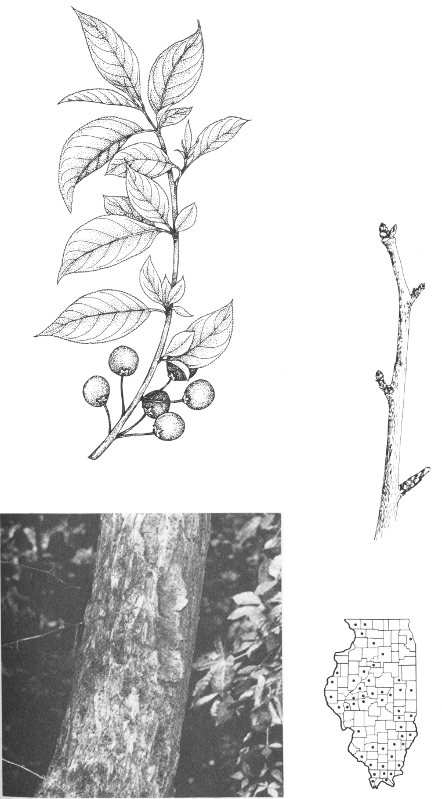
Two other wild plums are occasionally encountered in Illinois.
Munson’s Wild Plum (Prunus munsoniana Wight & Hedrick). Munson’s Wild Plum is a small tree rarely more than 15 feet tall and often forming thickets. It has gray or brown scaly bark, smooth brownish twigs, and small, ovoid buds. The leaves are oval and up to 6 inches long and up to 2 inches wide. The edges of the leaves are finely toothed, with each tooth gland-tipped. The upper surface of the leaf is smooth, while the lower surface usually has some hairs. The showy white flowers appear while the leaves are developing. The fruits are spherical or slightly oblong red plums with sweet, juicy flesh. Munson’s Wild Plum is found only in the midwestern states.
Narrow-leaved Plum (Prunus angustifolia Marsh.). Also known as Chickasaw Plum, this is a small tree up to about 15 feet tall, usually forming thickets. The smooth, brownish twigs usually have several sharp spines. Most of the leaves are lance-shaped and up to 2 inches long, and conspicuously folded lengthwise. The flowers begin to bloom just as the leaves start to unfold. The red, nearly spherical plum has tart, juicy flesh. The Narrow-leaved Plum is found mostly in the southeastern United States.
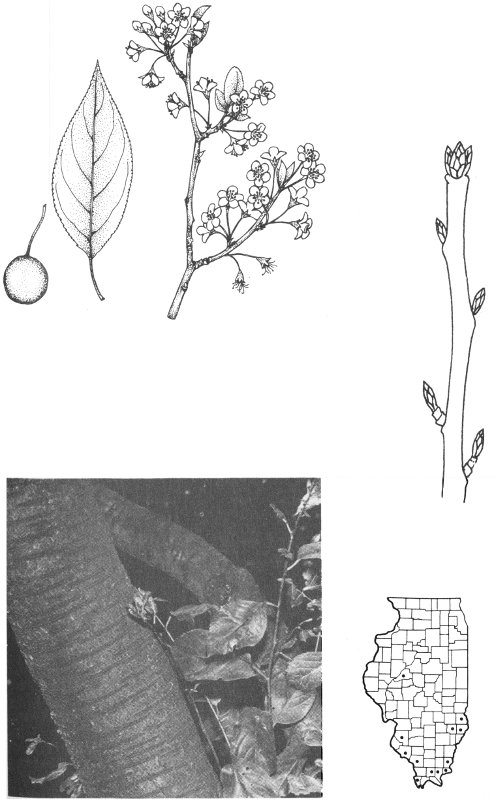
Growth Form: Medium tree up to 75 feet tall; trunk diameter up to 3 feet; crown rounded, with rigid branches.
Bark: Thin, smooth, reddish-brown at first, becoming deeply furrowed and black.
Twigs: Slender, smooth, dark brown; leaf scars half-round, each with 3 bundle traces.
Buds: Ovoid, sharp-pointed, dark brown, smooth, up to one-fourth inch long.
Leaves: Alternate, simple; blades oblong or oval, short-pointed at the tip, tapering to the base, up to 6 inches long and about ⅓ as broad, finely toothed along the edges, green, smooth, and shiny on the upper surface, paler and smooth on the lower surface except for rusty hairs along the veins; leafstalks slender, slightly less than 1 inch long, smooth, with 1 or more reddish glands near the tip.
Flowers: Crowded in showy, drooping, elongated clusters up to 6 inches long, appearing when the leaves are partly grown, each flower about ¼ inch across, with 5 white petals.
Fruit: Fleshy, juicy, spherical, dark purple, up to ½ inch in diameter.
Wood: Light weight, hard, strong, close-grained, light reddish-brown.
Uses: Cabinets, interior finishing.
Habitat: Roadsides, fencerows, edge of woods.
Range: Nova Scotia across to Ontario, south to Texas, east to Florida.
Distinguishing Features: The Wild Black Cherry is similar to the Choke Cherry but usually is a larger tree with thicker leaves and with the teeth tending to curve inward.
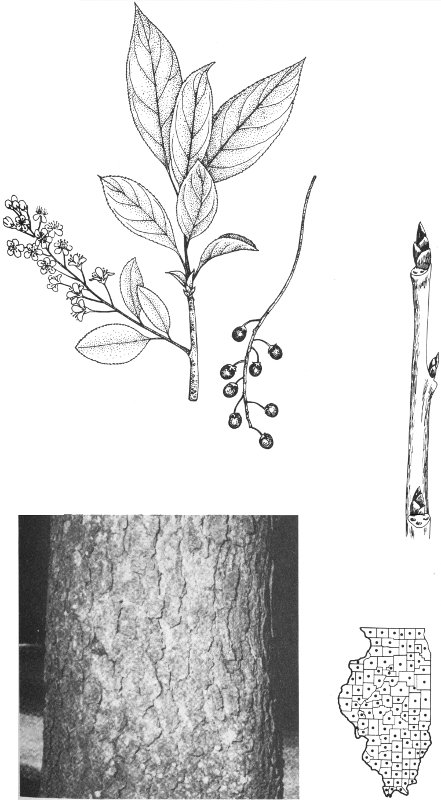
Growth Form: Small tree to 20 feet tall, often only a shrub; trunk diameter up to 5 inches; crown irregular.
Bark: Thin, smooth and reddish-brown at first, becoming furrowed and darkened.
Twigs: Slender, smooth, reddish-brown with pale lenticels; leaf scars alternate, half-round, each with 3 bundle traces.
Buds: Ovoid, pointed, brown, more or less smooth, up to ¼ inch long.
Leaves: Alternate, simple; blades oblong or oval, short-pointed at the tip, tapering to the base, up to 4 inches long and about half as broad, finely and sharply toothed along the edges, green, smooth and shiny on the upper surface, paler and smooth or with a few hairs on the lower surface; leafstalks slender, up to 1 inch long, smooth, with 2 glands near the tip.
Flowers: Crowded in showy, drooping, elongated clusters up to 6 inches long, appearing when the leaves are partly grown, each flower up to ½ inch across, with 5 white petals.
Fruit: Fleshy, juicy, spherical, up to ⅓ inch in diameter, red at first, becoming deep purple at maturity.
Wood: Heavy, hard, not strong, close-grained, pale-brown.
Uses: Fuel, some interior finishing.
Habitat: Woods, along streams.
Range: Newfoundland across to Saskatchewan, south to Kansas, east to North Carolina.
Distinguishing Features: Choke Cherry resembles Wild Black Cherry, differing by its more pointed teeth along the edges of the leaves.
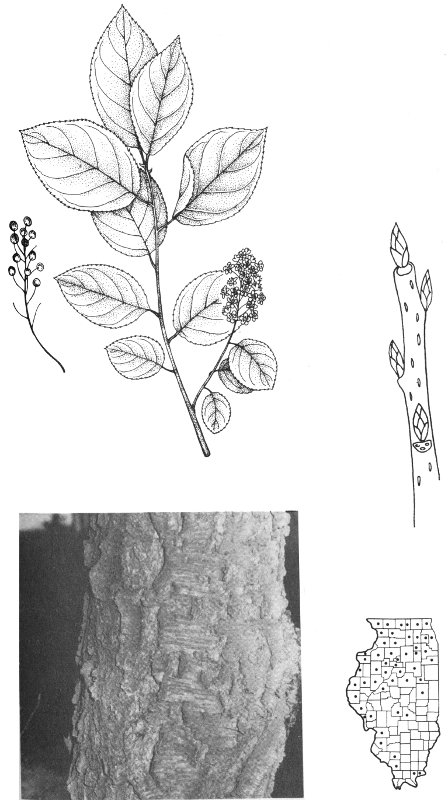
Other Name: Hop-tree.
Growth Form: Small tree or shrub up to 20 feet tall; trunk diameter up to 5 inches; crown rounded.
Bark: Brown, somewhat roughened.
Twigs: Slender, dark brown, often with small “warts”; leaf scars alternate, large, horseshoe-shaped, slightly elevated, with 3 bundle traces.
Buds: Spherical, pale brown, hairy.
Leaves: Alternate, divided into 3 leaflets; leaflets mostly ovate, long-pointed at the tip, rounded or tapering to the base, up to 5 inches long, up to half as wide, smooth or with fine teeth along the edges, dark green and smooth on the upper surface, paler and smooth on the lower surface; leaflets without individual stalks.
Flowers: Staminate and pistillate flowers borne separately but usually in the same cluster, appearing in late May and June, with 3-5 obscure, greenish-white petals.
Fruit: Thin, flat, nearly spherical winged seed up to 1 inch across.
Wood: Hard, heavy, close-grained, yellow-brown.
Use: The fruit at one time was used as a substitute for hops in brewing.
Habitat: Rocky, wooded slopes.
Range: Quebec across Michigan to Iowa, south to eastern Texas, east to Florida.
Distinguishing Features: The Wafer Ash is distinguished by its 3-parted alternate leaves and its flat, spherical, winged seeds.
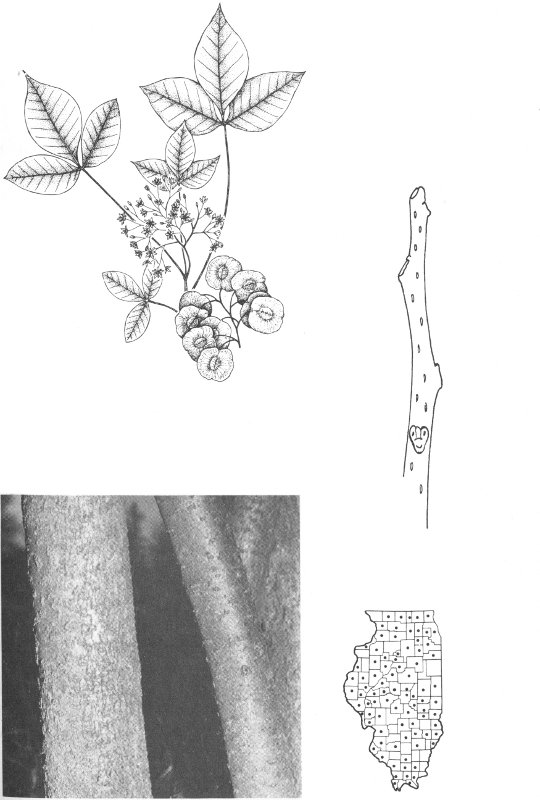
Growth Form: Large tree up to 100 feet tall; trunk diameter up to 3 feet; crown very broad, with stiff, horizontal branches; trunk relatively short and rather thick.
Bark: Gray or whitish with gray patches, shallowly furrowed.
Twigs: Slender, smooth, somewhat shiny, gray, whitish, or even purplish; pith star-shaped in cross-section; leaf scars alternate but crowded near the tip of the twig, half-round, slightly elevated, with several bundle traces.
Buds: Nearly round, reddish-brown or gray, up to ⅛ inch long.
Leaves: Alternate, simple; blades usually with 7 or 9 lobes, the lobes rounded and not bristle-tipped, the sinuses varying from shallow to deep, the upper surface green and smooth, the lower surface paler and smooth, up to 10 inches long, up to half as wide, turning red in the autumn; leafstalks up to 1 inch long, rather stout, smooth. Leaves on the same tree may vary considerably.
Flowers: Staminate and pistillate borne separately, but on the same tree, appearing when the leaves begin to unfold, minute, without petals, the staminate many in drooping, yellow catkins, the pistillate few in a group, red.
Fruit: Acorns borne 1 or 2 together, with or without a stalk, the nut oblong, up to ¾ inch long, green to greenish-brown, shiny, the cup covering up to ¼ of the nut, yellow-brown, often minutely hairy.
Wood: Heavy, hard, strong, durable, coarse-grained, pale brown.
Uses: Interior finishing, cabinets, general construction, fence posts, fuel, tight cooperage.
Habitat: Moist woods; wooded slopes; dry woods.
Range: Maine across to Minnesota, south to eastern Texas, east to northern Florida.
Distinguishing Features: White Oak is recognized by its grayish bark and its 5-7 round-lobed, smooth leaves which are usually whitish on the lower surface. Its oblong, greenish-brown, shiny acorns are also distinctive.
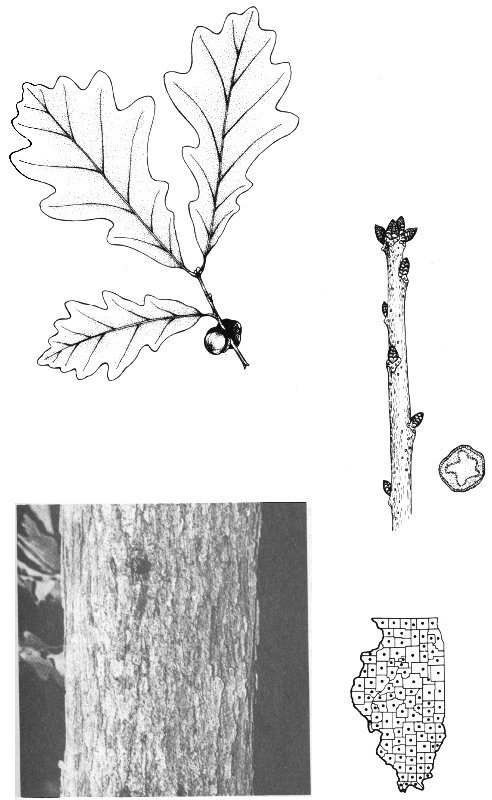
Growth Form: Medium tree to 70 feet tall; trunk diameter up to 3 feet; crown rounded and broad.
Bark: Grayish-brown, deeply furrowed, becoming flaky.
Twigs: Stout, grayish-brown to yellowish-brown; leaf scars alternate, half-round, slightly elevated, with several bundle traces; pith star-shaped in cross-section.
Buds: Clustered at the tips of the twigs, ellipsoid to spherical, up to ⅛ inch long, yellow-brown, smooth or with a few hairs at the tip.
Leaves: Alternate, simple; blades usually broadest above the middle, up to 6 inches long and 4 inches broad, coarsely round-toothed or sometimes with a few shallow lobes, smooth or somewhat hairy on the upper surface, white and softly hairy on the lower surface; leafstalks nearly an inch long, smooth or slightly hairy.
Flowers: Staminate and pistillate borne separately, but on the same tree, appearing when the leaves begin to unfold, minute, without petals, the staminate in slender, drooping catkins, the pistillate in groups of 2-4.
Fruit: Acorns in pairs, on stalks 1 inch long or longer, the nut ovoid, pale brown, 1-1½ inches long, enclosed about ⅓ its length by the cup, the cup thick, light brown, hairy, roughened.
Wood: Hard, heavy, strong, pale brown.
Uses: Interior finishing, cabinets, fuel, fence posts.
Habitat: Bottomland woods.
Range: Maine and southern Quebec across to southern Minnesota, south to Oklahoma, east to Georgia.
Distinguishing Features: The Swamp White Oak is distinguished by its leaves which are coarsely round-toothed and softly white hairy on the lower surface of the leaves.

Growth Form: Medium tree to 70 feet tall; trunk diameter up to 2½ feet; crown narrow but open.
Bark: Reddish-brown, shallowly fissured when mature.
Twigs: Slender, brown, smooth; leaf scars alternate, but crowded near the tip, half-round, slightly elevated, with several bundle traces; pith star-shaped in cross-section.
Buds: Pointed, reddish-brown, hairy at the tip, up to ¼ inch long.
Leaves: Alternate, simple; blades divided more than half-way to the middle into 5-7 bristle-tipped lobes, bright green, shiny and smooth on the upper surface, paler and with tufts of hairs along the veins on the lower surface, up to 6½ inches long and 4 inches broad; leafstalks up to 2½ inches long, slender, usually smooth.
Flowers: Staminate and pistillate borne separately, but on the same tree, appearing when the leaves begin to unfold, minute, without petals, the staminate in slender, drooping catkins, the pistillate in groups of 1 or 2.
Fruit: Acorns solitary or paired, with or without stalks, the nut oval or hemispherical, up to ¾ inch across, reddish-brown with occasional darker rings around it, enclosed up to ½ its length by the cup, the cup thin, top-shaped, reddish-brown, finely hairy.
Wood: Hard, heavy, coarse-grained, pale brown.
Uses: Fuel, fence posts, coarse construction.
Habitat: Dry woods.
Range: Maine to southern Ontario, south to Oklahoma, east to Georgia.
Distinguishing Features: Scarlet Oak looks very much like Pin Oak, but differs in habitat and structure of the acorn cup. It sometimes resembles Black Oak but has shorter, less hairy buds and acorns without loosely arranged scales on the cup.
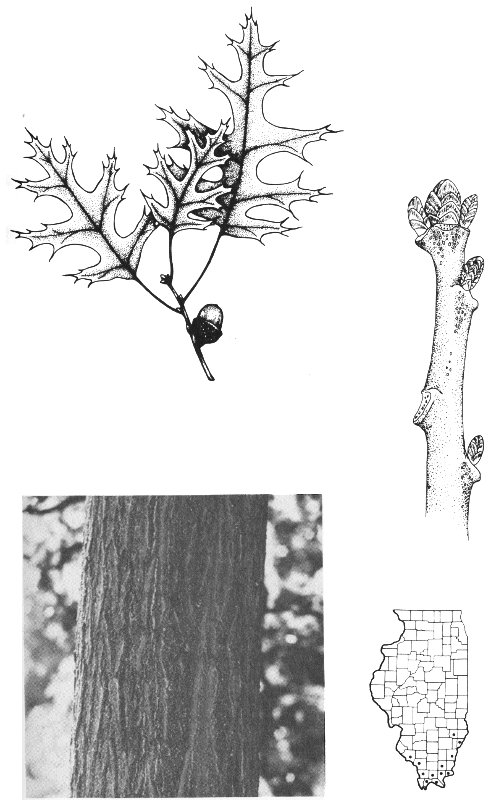
Other Name: Northern Pin Oak.
Growth Form: Moderate tree to about 75 feet tall; trunk diameter up to 2 feet; crown rounded, with the drooping lowermost branches often reaching nearly to the ground.
Bark: Gray-black, rather smooth to shallowly fissured.
Twigs: Rather slender, smooth at maturity, grayish-brown to reddish-brown; pith star-shaped in cross-section; leaf scars alternate, but clustered near the tip of the twig, half-round, slightly elevated, with several bundle traces.
Buds: Nearly smooth, one-fourth inch long, ovoid, reddish-brown.
Leaves: Alternate, simple; blades 3-9 inches long, slightly tapering or usually cut nearly straight across at the base, with 2-4 pairs of bristle-tipped lobes usually cut over half-way to the mid-vein, deep green and shiny on the upper surface at maturity; leafstalks smooth, up to 3 inches long.
Flowers: Staminate and pistillate on same tree, appearing as the leaves unfold, inconspicuous, the staminate crowded in a catkin, the pistillate solitary or 2-3 together.
Fruit: Ripening in October of the second year, on very short stalks; acorns longer than broad, short-pointed at the base, about ½ inch across, the cup bowl-shaped covering ⅓ to ½ of the acorn.
Wood: Heavy, hard, strong, pale brown.
Uses: Shingles and interior finishings.
Habitat: Dry upland woods, often where Black Oak occurs.
Range: Northwestern Ohio and central Michigan to southeastern Minnesota, south to eastern Iowa and north-central Illinois.
Distinguishing Features: The elongated acorn of the Hill’s Oak distinguishes it from pin oak, which it closely resembles.
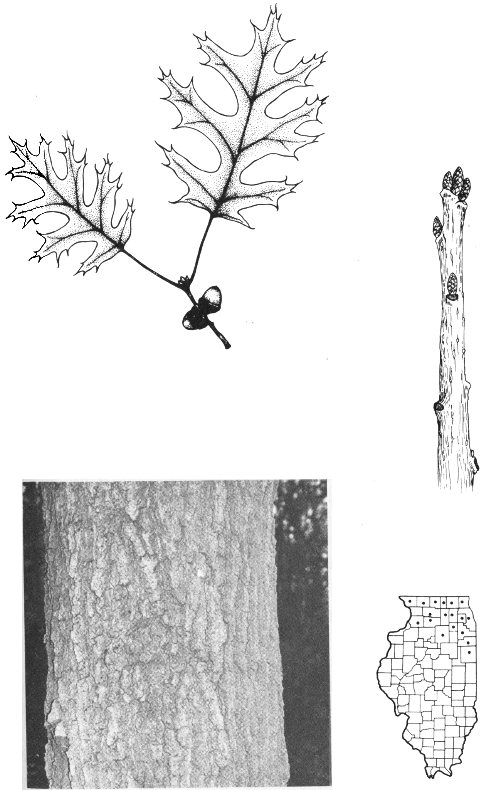
Other Name: Southern Red Oak.
Growth Form: Large tree up to 80 feet tall; trunk diameter up to 4 feet; crown broadly rounded, with stiff, stout, spreading branchlets; trunk straight, rather stout.
Bark: Dark brown to nearly black, shallowly furrowed.
Twigs: Reddish-brown to gray, smooth or nearly so at maturity; pith star-shaped in cross-section; leaf scars alternate but clustered near the tip, half-round, slightly elevated, with several bundle traces.
Buds: Ovoid, pointed, chestnut-brown, hairy, up to ¼ inch long.
Leaves: Alternate, simple; blades broadly rounded at the base, 3- to 5-lobed, the terminal lobe usually long, narrow, and strongly curved, all lobes bristle-tipped, up to 8 inches long, up to 6 inches wide, green on the upper surface, pale and densely soft-hairy on the lower surface; leaf stalk up to 2½ inches long, slender, usually hairy.
Flowers: Staminate and pistillate borne separately, but on the same tree, appearing when the leaves begin to unfold, minute, without petals, the staminate in slender, drooping, densely hairy catkins, the pistillate few in a rusty-hairy cluster, with dark red stigmas.
Fruit: Acorn usually solitary, with or without a short stalk, the nut spherical or ellipsoid, up to ½ inch long, orange-brown, the cup covering only up to ⅓ of the nut, with hairy, reddish-brown scales.
Wood: Heavy, hard, strong, coarse-grained, reddish-brown.
Uses: Fence posts, fuel, general construction.
Habitat: Dry and usually poor upland soil; occasionally in bottomlands.
Range: Central New Jersey south to central Florida, across to eastern Texas, up the Mississippi Basin to central Missouri, south-central Illinois, southeastern Indiana, western Kentucky, and western Tennessee.
Distinguishing Features: The Spanish Oak is the only bristle-tipped oak in Illinois in which the lower leaf surface is covered with a mat of fine hairs.

Growth Form: Medium tree up to 70 feet tall; trunk diameter up to 3 feet; crown rounded or oblong, with many branches; trunk straight, columnar.
Bark: Dark brown, deeply furrowed between flat, tight plates.
Twigs: Slender, smooth, reddish-brown; pith star-shaped in cross-sections; leaf scars alternate but crowded near the tip of the twigs, half-round, slightly elevated, with several bundle traces.
Buds: Ovoid, pointed, brown, smooth, up to ⅛ inch long.
Leaves: Alternate, simple; blades without lobes or teeth, lanceolate to oblong, with a bristle tip, narrowed to the base, up to 6 inches long, up to 2 inches wide, dark green, smooth and shiny on the upper surface, paler and hairy on the lower surface; leafstalks up to ½ inch long, stout, hairy.
Flowers: Staminate and pistillate borne separately, but on the same tree, appearing as the leaves begin to unfold, minute, without petals, the staminate in slender, yellow, drooping catkins, the pistillate few in a cluster.
Fruit: Acorns solitary or 2 together, stalked, the nut nearly spherical, dark brown, less than half enclosed by the cup, the cup reddish-brown and slightly hairy.
Wood: Hard, heavy, coarse-grained, light reddish-brown.
Uses: Shingles, general construction.
Habitat: Moist soil along streams or in woods; occasionally on dry, exposed sandstone cliffs.
Range: New Jersey across to Wisconsin, Iowa, and Nebraska, south to Kansas, east to Arkansas and South Carolina.
Distinguishing Features: Only the Shingle Oak and the Willow Oak, among all the oaks, have leaves without any teeth or lobes. The Shingle Oak generally has broader leaves than does the Willow Oak. The Shingle Oak can be told from Magnolias by its star-shaped pith and the formation of acorns.
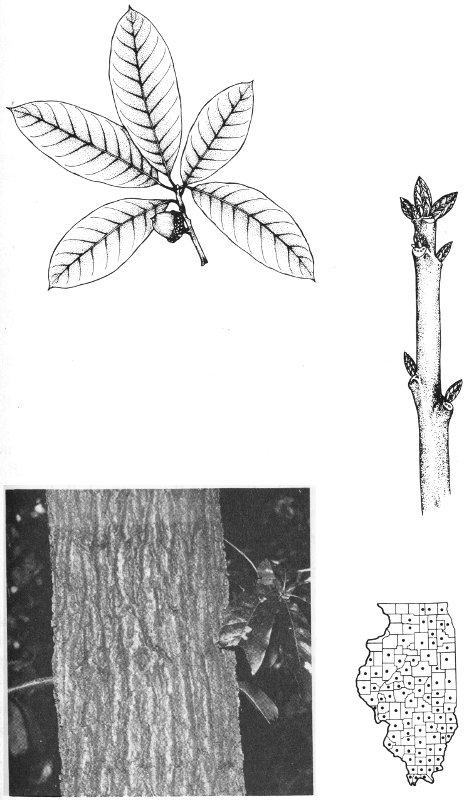
Growth Form: Medium to large tree up to 80 feet tall; trunk diameter up to 3 feet; crown rounded to oblong, with several branches, the lowermost often drooping; trunk straight, columnar.
Bark: Gray or grayish-brown, divided into flat, sometimes squarish, plates.
Twigs: Slender, smooth, buff-colored; pith star-shaped in cross-section; leaf scars alternate, but clustered near the tip of the twig, half-round, slightly elevated, with several bundle traces.
Buds: Nearly round, smooth, pale brown, up to ⅛ inch long.
Leaves: Alternate, simple; blades divided into 5-7 rounded lobes, the sinuses shallow to deep, up to 10 inches long, up to 4½ inches broad, dark green and smooth on the upper surface, pale and softly hairy to nearly smooth on the lower surface; leafstalk up to 1 inch long, smooth or hairy.
Flowers: Staminate and pistillate borne separately, but on the same plant, appearing when the leaves begin to unfold, minute, without petals, the staminate in slender, yellow, drooping catkins, the pistillate few in a group.
Fruit: Acorns solitary or 2 together, with or without a stalk, the nut nearly spherical, up to 1 inch in diameter, pale brown, often nearly entirely enclosed by the cup, the cup finely hairy, with some of the scales forming a ragged rim near the base.
Wood: Hard, heavy, strong, dark brown.
Uses: Interior finishing, cabinets, fuel, fence posts.
Habitat: Bottomland woods; swamps.
Range: Southern Virginia across to eastern Texas, north up the Mississippi Valley to southern Missouri, southern Illinois, and southern Indiana; also in Delaware, Maryland, and New Jersey; southward to Florida.
Distinguishing Features: The best identifying characteristic of this plant is the acorn in which the nut often is nearly enclosed by the cup.
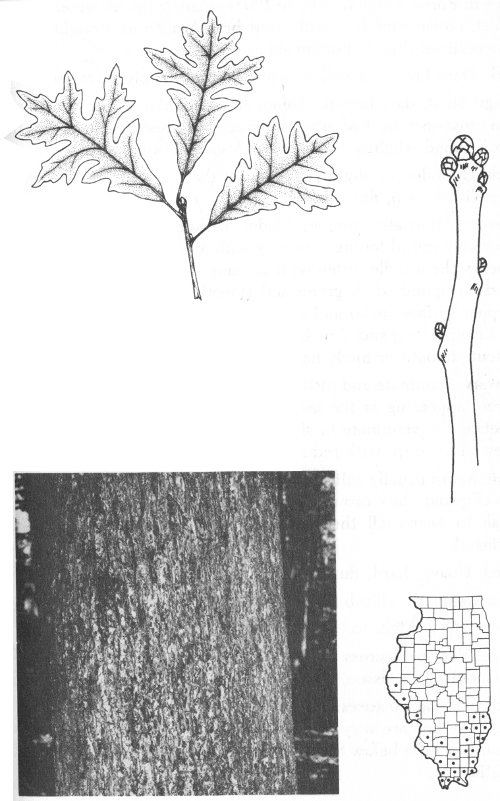
Other Name: Mossy-cup Oak.
Growth Form: Large tree up to 120 feet tall; trunk diameter up to 5 feet; crown rounded, with stout branches; trunk straight, stout, sometimes slightly buttressed at the base.
Bark: Dark brown or yellow-brown, rather deeply furrowed.
Twigs: Stout, dark brown, often with corky ridges; pith star-shaped in cross-section; leaf scars alternate but clustered near the tip, half-round, slightly elevated, with several bundle traces.
Buds: Rounded or slightly pointed at the tip, yellowish-brown to reddish-brown, finely hairy.
Leaves: Alternate, simple; blades broader at the upper end, coarsely round-toothed, usually with a pair of deep sinuses just below the middle, often with as many as 5-7 lobes, the lobes not bristle-tipped, dark green and smooth or slightly hairy on the upper surface, paler and softly hairy on the lower surface, up to 14 inches long and 7 inches wide; leaf stalks up to 1 inch long, stout, smooth or finely hairy.
Flowers: Staminate and pistillate borne separately, but on the same tree, appearing as the leaves begin to unfold, minute, without petals, the staminate in slender, drooping catkins, the pistillate few in a group, with red stigmas.
Fruit: Acorn usually solitary, with or without a stalk, the nut ovoid to ellipsoid, dark brown, up to 1¾ inches long, the cup covering half to nearly all the nut, hairy, the lowermost scales long-fringed.
Wood: Heavy, hard, durable, close-grained, brown.
Uses: Cabinets, ship-building, fenceposts, fuel, tight cooperage.
Habitat: Dry ridges to bottomland woods.
Range: Vermont across to North Dakota, south to Texas, east to Arkansas, Tennessee, and Maryland.
Distinguishing Features: The leaves of the Bur Oak are distinctive because they are very broad in the upper half with a pair of deep sinuses a little below the middle. The large, fringed cups are also distinctive.

Other Name: Scrub Oak.
Growth Form: Relatively small tree, at most attaining a height of 50 feet, usually much shorter and often very gnarled; trunk diameter up to 1½ feet; crown exceedingly round-topped, with numerous lower branches hanging downward.
Bark: Dark brown, shallowly ridged.
Twigs: Moderately stout, brown, more or less hairy; pith star-shaped in cross-section; leaf scars alternate but clustered near the top, half-round, slightly elevated, with several bundle traces.
Buds: Angular, from ¼-½ inch long, somewhat hairy.
Leaves: Alternate, simple; blades about 4-8 inches long, leathery, very much broader near the apex than the base, mostly rounded or even somewhat heart shaped at the base, more or less 3-lobed and bristle-tipped nearer the apex, the upper surface hairy at first, becoming shiny dark green at maturity, the lower surface permanently hairy; leafstalks less than 1 inch long.
Flowers: Staminate and pistillate on the same tree, appearing as the leaves unfold, inconspicuous, the staminate crowded in a catkin, the pistillate solitary or 2-3 together.
Fruit: Ripening in October of the second year, on very short stalks, or the stalks sometimes lacking; acorns nearly round, usually at most only ½ inch in diameter, the cup enclosing ½ the acorn, with rather loosely arranged scales.
Wood: Hard, strong, heavy, dark brown.
Uses: Excellent as a source of charcoal and fuel.
Habitat: Poor soil, particularly on dry, exposed rocky cliffs.
Range: New York across to Pennsylvania, Ohio, Indiana, Illinois, and southern Iowa to southeastern Nebraska, south into eastern Kansas, eastern Oklahoma, and eastern Texas, then east to northern Florida.
Distinguishing Features: The 3-lobed leaf, much broader at the apex, is the most distinctive characteristic of this oak.
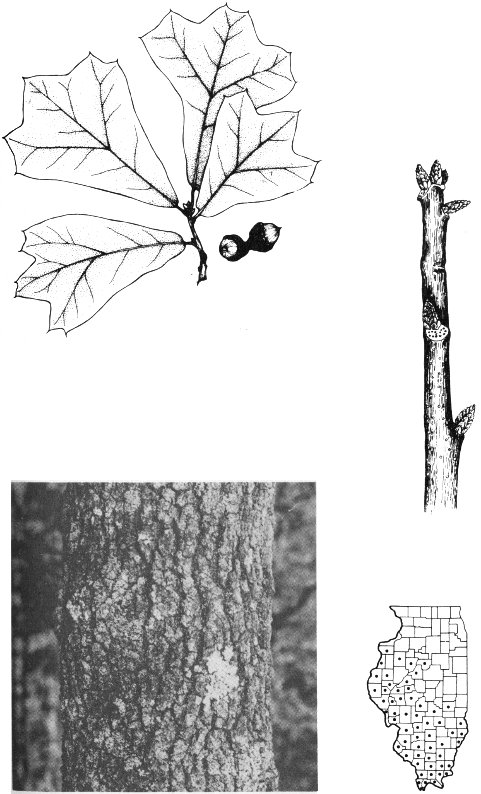
Other Names: Basket Oak; Cow Oak.
Growth Form: Medium to large tree up to nearly 100 feet tall; trunk diameter up to 6 feet; crown rounded.
Bark: Gray or silvery-white, scaly.
Twigs: Stout, reddish-brown to gray, smooth or nearly so; leaf scars alternate but crowded near the tip, half-round, slightly elevated, with several bundle traces; pith star-shaped in cross-section.
Buds: Pointed, finely hairy, reddish-brown, up to ¼ inch long.
Leaves: Alternate, simple; blades obovate, pointed at the tip, rounded or tapering to the base, up to 10 inches long and 6 inches broad, coarsely scalloped along the edges, thick, green and sparsely hairy on the upper surface, whitish and densely hairy on the lower surface; leafstalk up to 1½ inches long, hairy.
Flowers: Borne separately but on the same tree, minute, without petals, the staminate crowded into long, slender catkins, the pistillate few in a cluster.
Fruit: Acorns solitary or paired, with or without short stalks, the nut ovoid to ellipsoid, brown, up to 1½ inches long, enclosed about ⅓ its length by the cup, the cup thick, cup-shaped, hairy, short-fringed along the rim.
Wood: Hard, heavy, strong, close-grained, pale brown.
Uses: General construction, fuel, fence posts.
Habitat: Low woods.
Range: New Jersey across to southern Missouri, south to Texas, east to Florida.
Distinguishing Features: The Swamp Chestnut Oak is distinguished from other coarsely toothed oaks by the densely hairy, whitish lower leaf surfaces and its short-stalked acorns.
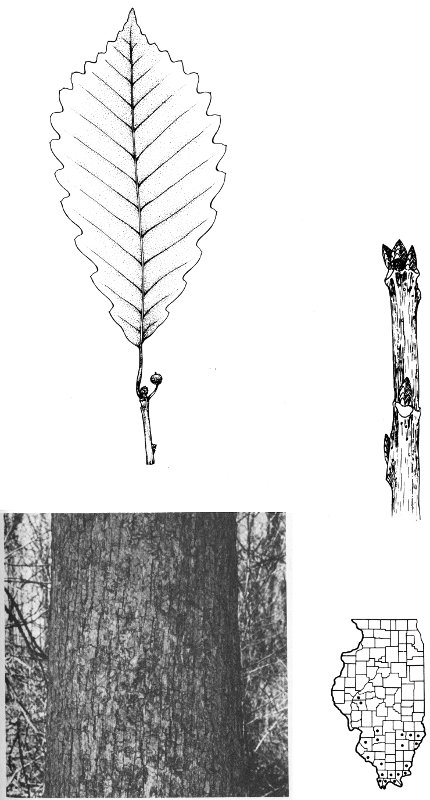
Other Names: Chinquapin; Chinquapin Oak.
Growth Form: Large tree up to 100 feet tall; trunk diameter up to 4 feet; crown oblong or rounded, with many branches; trunk straight, columnar, buttressed at the base.
Bark: Pale gray, with scaly ridges.
Twigs: Slender, yellow-brown or reddish-brown; pith star-shaped in cross-section; leaf scars alternate but clustered near the tip, half-round, with several bundle traces; pith star-shaped in cross-section.
Buds: Pointed, smooth, chestnut-brown, up to ¼ inch long.
Leaves: Alternate, simple; blades narrowly to broadly lanceolate, pointed at the tip, narrowed or rounded at the base, coarsely toothed along the edges, smooth and yellow-green on the upper surface, paler and usually finely hairy on the lower surface, up to 8 inches long and 5 inches broad; leafstalk up to 1½ inches long, slender, usually smooth.
Flowers: Staminate and pistillate borne separately, but on the same tree, minute, without petals, the staminate crowded into long, slender catkins, the pistillate few in a group, with red stigmas.
Fruit: Acorns borne in groups of 1 or 2, usually on a short stalk, the nut ovoid, chestnut-colored, up to ¾ inch long, the cup covering about ½ the nut, the scales of the cup hairy and usually with a short fringe.
Wood: Heavy, strong, durable, close-grained.
Uses: Fence posts, fuel, railroad ties.
Habitat: Low rich slopes; wooded hillsides; dry cliffs.
Range: Vermont across to southern Minnesota, south to eastern Nebraska and eastern Texas, east to northern Florida.
Distinguishing Features: The Yellow Chestnut Oak is distinguished from the other coarsely toothed oaks by its usually sharper pointed teeth and by the size and shape of its acorns.
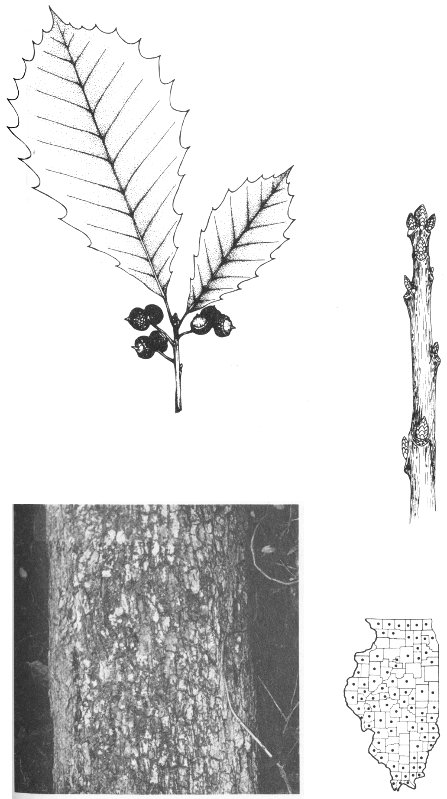
Other Name: Swamp Spanish Oak.
Growth Form: Large tree up to 100 feet tall; trunk diameter up to 4 feet; crown broadly rounded; trunk straight, columnar.
Bark: Dark gray, broken by narrow ridges into small scales.
Twigs: Rather stout, reddish-brown or gray, usually hairy when young, becoming smooth; pith star-shaped in cross-section; leaf scars alternate but clustered near tip of the twigs, half-round, slightly elevated, with several bundle traces.
Buds: Ovoid, pointed, angular, hairy, chestnut-brown, up to ¼ inch long.
Leaves: Alternate, simple; blades divided into 5-11 pointed lobes, the sinuses cut about half-way to the midvein, up to 10 inches long, up to 7 inches wide, dark green, smooth and shiny on the upper surface, pale and hairy on the lower surface; leafstalks up to 2 inches long, stout, hairy.
Flowers: Staminate and pistillate borne separately, but on the same plant, appearing when the leaves begin to unfold, minute, without petals, the staminate in slender, drooping catkins, the pistillate few together.
Fruit: Acorns solitary or 2 together, with or without a stalk, the nut ellipsoid, about ½ inch long, brown, enclosed for less than ⅓ its length by the cup, the cup finely hairy.
Wood: Strong, hard, coarse-grained, light reddish-brown.
Uses: Interior finishing, furniture, cabinets.
Habitat: Bottomlands and river banks.
Range: Southeastern Virginia to southeastern Missouri, south to Texas, east to Florida.
Distinguishing Features: The shape of the leaf is distinctive for this oak.
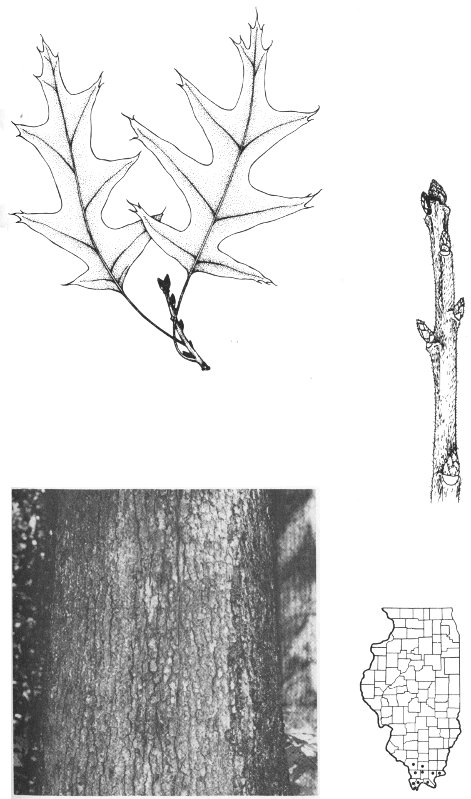
Growth Form: Medium tree up to 75 feet tall; trunk diameter usually less than 3 feet; crown narrowly rounded or oblong, but with the lower branches drooping; trunk straight, with pin-like stubs developing rather low on the trunk.
Bark: Light brown or dark brown, scarcely furrowed.
Twigs: Slender, smooth, reddish-brown to dark gray; pith star-shaped in cross-section; leaf scars alternate but crowded near the tip, half-round, usually slightly elevated, with several bundle traces.
Buds: Pointed, reddish-brown or dark gray, smooth, up to ⅛ inch long.
Leaves: Alternate, simple; blades divided more than half-way to the middle into 5-7 bristle-tipped lobes, dark green, shiny and more or less smooth on the upper surface, paler and with tufts of hairs along the veins on the lower surface, up to 7 inches long and 4 inches broad; leafstalk up to 2 inches long, slender, usually smooth.
Flowers: Staminate and pistillate borne separately, but on the same tree, appearing when the leaves begin to unfold, minute, without petals, the staminate in slender, drooping catkins, the pistillate in groups of 1-3.
Fruit: Acorns 1-4 together, with or without stalks, the nut hemispherical, up to ½ inch across, pale brown, frequently with darker lines, enclosed less than ¼ by the cup, the cup thin, saucer-shaped, reddish-brown, finely hairy.
Wood: Hard, heavy, coarse-grained, pale brown.
Uses: General construction, fuel, fence posts, ornamental.
Habitat: Moist soil; in floodplain woods; along streams; edges of swamps and ponds.
Range: Massachusetts across to southeastern Iowa, south to northeastern Oklahoma, east to northern Virginia.
Distinguishing Features: Pin Oak is recognized by its drooping lower branches and its small acorns.
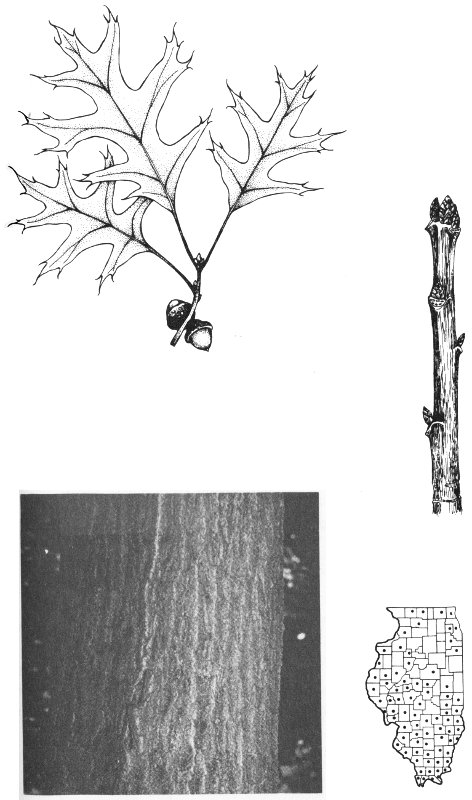
Growth Form: Medium tree to 75 feet tall; trunk diameter up to 3 feet; crown narrowly round-topped.
Bark: Reddish-brown, smooth at first, becoming irregularly and shallowly furrowed with age.
Twigs: Slender, smooth, reddish-brown; pith star-shaped in cross-section; leaf scars alternate but crowded near the tip of the twigs, half-round, slightly elevated, with several bundle traces.
Buds: Ovoid, pointed, smooth, up to ⅛ inch long.
Leaves: Alternate, simple; blades without lobes or teeth, narrowly lanceolate to narrowly oblong, with a bristle tip, narrowed to the base, up to 5 inches long, up to 1 inch broad, light green and smooth on the upper surface, usually smooth and paler on the lower surface; leafstalks up to ½ inch long, smooth or slightly hairy.
Flowers: Staminate and pistillate borne separately, but on the same tree, appearing as the leaves begin to unfold, minute, without petals, the staminate in slender, drooping catkins, the pistillate few in a cluster.
Fruit: Acorns solitary or 2 together, with or without a short stalk, the nut more or less spherical, pale yellow-brown, enclosed less than ¼ its length by the cup, the cup reddish-brown, finely hairy.
Wood: Heavy, rather soft, strong, coarse-grained, pale reddish-brown.
Use: General construction.
Habitat: Swampy woods.
Range: New York across to southern Illinois and eastern Oklahoma, south to Texas, east to Florida.
Distinguishing Features: This and the Shingle Oak are the only oaks in Illinois with unlobed, untoothed leaves. The leaves of the Willow Oak are usually much narrower than those of the Shingle Oak.
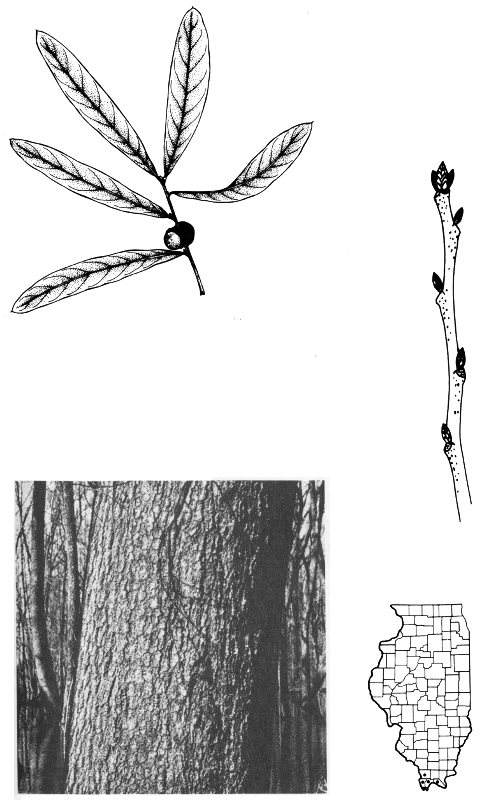
Other Name: Chestnut Oak.
Growth Form: Medium tree up to 55 feet tall; trunk diameter up to 2½ feet; crown broad but irregular.
Bark: Dark brown, with conspicuous furrows between the rounded ridges.
Twigs: Rather stout, reddish-brown, smooth or nearly so; leaf scars alternate, but clustered near the tip of the twig, half-round, with several bundle traces; pith star-shaped in cross-section.
Buds: Pointed, brown, somewhat hairy, up to ½ inch long.
Leaves: Alternate, simple; blades obovate to broadly lanceolate, pointed at the tip, narrowed to the base, thick and leathery, coarsely round-toothed along the edges, smooth, shiny, and yellow-green on the upper surface, finely hairy over all the lower surface, up to 9 inches long and up to 4 inches broad; leafstalk up to 1 inch long, smooth or slightly hairy.
Flowers: Staminate and pistillate borne separately, but on the same tree, minute, without petals, the staminate crowded into long, slender catkins, the pistillate few in a group.
Fruit: Acorns borne in groups of 1 or 2, usually on a short stalk, the nut ovoid to ellipsoid, chestnut-colored, up to 1½ inches long, the cup covering about ½ the nut or less, the scales of the cup reddish-brown and warty.
Wood: Hard, heavy, strong, close-grained.
Uses: Fence posts, railroad ties, fuel.
Habitat: Dry, rocky, wooded slopes.
Range: Maine across to southern Illinois, south to Mississippi and Georgia.
Distinguishing Features: The acorns of the Rock Chestnut Oak are about twice the size as those of the Yellow Chestnut Oak. The teeth of the leaves of the Rock Chestnut Oak tend to be more rounded than the pointed teeth of the Yellow Chestnut Oak.
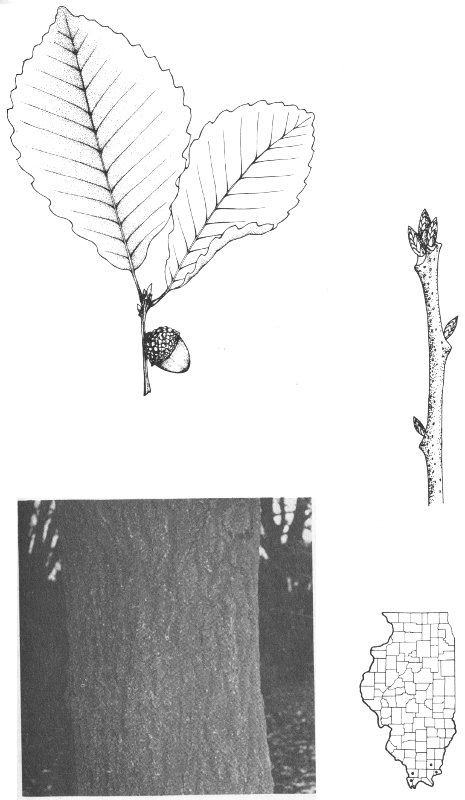
Other Name: Red Oak.
Growth Form: Medium to tall tree to 80 feet tall; trunk diameter up to 3 feet; crown broadly rounded, with large spreading branches; trunk straight, columnar, often buttressed at the base.
Bark: Grayish-brown, reddish-brown, blackish, or gray, with dark stripes.
Twigs: Slender, smooth, reddish-brown; pith star-shaped in cross-section; leaf scars alternate, but clustered near the tip of the twig, half-round, slightly elevated, with several bundle traces.
Buds: Pointed, smooth, reddish-brown, shiny, up to ¼ inch long.
Leaves: Alternate, simple; blades rather shallowly 7- to 11-lobed, the lobes bristle-tipped, dark green and smooth or somewhat hairy on the upper surface, paler and smooth or often with hairs along the veins on the lower surface, up to 10 inches long, up to 6 inches broad; leafstalks up to 2 inches long, stout, usually smooth.
Flowers: Staminate and pistillate borne separately, but on the same tree, appearing as the leaves begin to unfold, minute, without petals, the staminate in slender, drooping catkins, the pistillate in groups of 1-3.
Fruit: Acorns solitary or 2 together, with or without stalks, the nut ovoid, up to 1½ inches long, pale brown, covered less than ¼ by the cup, the cup reddish-brown, with tight scales.
Wood: Hard, heavy, close-grained, light brown.
Uses: Interior finishing, furniture, fuel, fence posts.
Habitat: Rich, upland woods; along river banks; on well-drained slopes.
Range: New Brunswick, across southern Quebec and Ontario, to northcentral Minnesota, south to eastern Kansas, east across Missouri, Illinois, Kentucky, and in the mountains of eastern Tennessee and northeastern Georgia.
Distinguishing Features: The acorn with its very shallow, saucer-shaped cap is the best identifying characteristic for the Red Oak. The leaves are generally more shallowly lobed than those of the Black Oak, Southern Red Oak, and Scarlet Oak.
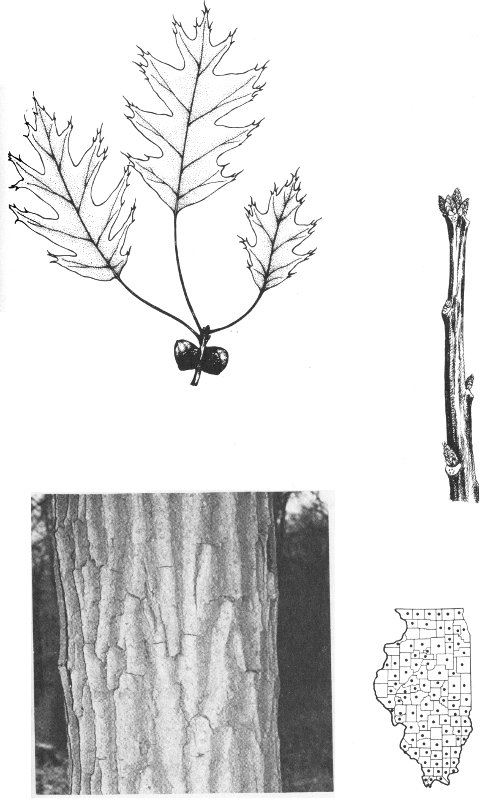
Other Names: Southern Red Oak; Schneck’s Oak.
Growth Form: Up to 120 feet tall; trunk up to 5 feet in diameter; crown broad and open, with wide-spreading branches.
Bark: Firmly ridged and dark brownish-black.
Twigs: Generally stouter than those of the Red Oak, smooth; pith star-shaped in cross-section; leaf scars alternate, but clustered near the tip of the twig, half-round, slightly elevated, with several bundle traces.
Buds: Smooth, red-brown, about one-third inch long.
Leaves: Alternate, simple; blades up to 8 inches long, straight across or somewhat wedge-shaped at the base, with 2-4 pairs of lobes divided over ⅔’s the way to the mid-nerve, each lobe toothed and bristle-pointed at the tips, the sinuses broadly rounded, dark green and shiny above, with white tufts of hair in the vein axils beneath; leafstalks slender, smooth, up to 2½ inches long.
Flowers: Staminate and pistillate on the same tree, appearing as the leaves unfold, inconspicuous, the staminate crowded in a catkin, the pistillate solitary or 2-3 together.
Fruit: Ripening in October of the second year, on stalks less than ¼ inch long, usually produced singly; acorns broadly egg-shaped, short-pointed at the base and flat at the top, up to 1¼ inches long and about ¾ as broad, light brown; cup shallow, about ¼-⅓ covering the acorn, with closely appressed, densely short-woolly scales.
Wood: Light, strong, durable; not distinguished commercially from Red Oak.
Uses: Interior finishing and furniture.
Habitat: Bottomland woods and stream banks.
Range: Most abundant in the Mississippi basin, but known from Florida and Texas, north to Maryland, Pennsylvania, eastcentral Kentucky, Indiana, central Illinois, the eastern half of Iowa, and southeastern Kansas. The largest known Shumard’s Oak in the country occurs at Beall Woods in Wabash County, Illinois.
Distinguishing Features: Deeply lobed, shiny leaves with broadly rounded sinuses.
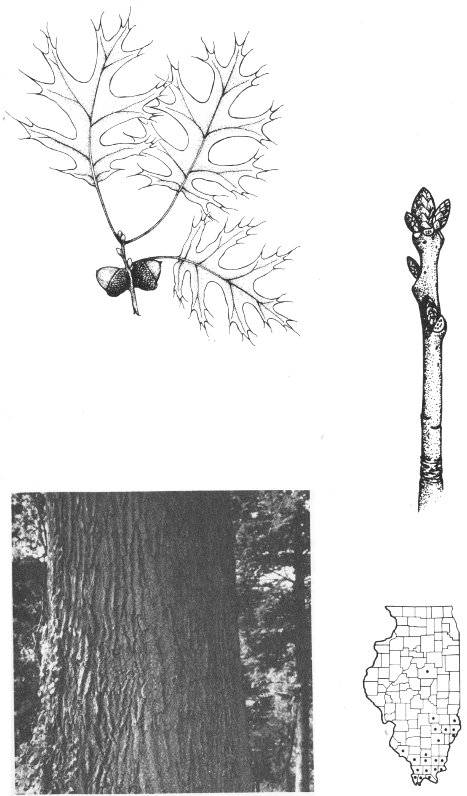
Growth Form: Small to medium tree up to 60 feet tall; trunk diameter up to 3 feet; crown rounded or obovoid, with rather stout branches; trunk gnarled or straight, usually not buttressed.
Bark: Gray or light brown, divided into flat, sometimes squarish, plates.
Twigs: Stout, brownish, covered when young by a tawny-colored fuzziness; pith star-shaped in cross-section; leaf scars alternate but densely clustered toward the tip, half-round, usually slightly elevated, with several bundle traces.
Buds: Spherical but often short-pointed, reddish-brown, up to ⅛ inch long.
Leaves: Alternate, simple; blades thick, 5-lobed, the upper three lobes squarish, separated from the lowest pair of lobes by a deep sinus, up to 6 inches long, up to 4½ inches wide, dark green and hairy on the upper surface, paler and hairy on the lower surface; leafstalks up to 1 inch long, stout, hairy.
Flowers: Staminate and pistillate borne separately, but on the same tree, appearing when the leaves begin to unfold, minute, without petals, the staminate in slender, yellow, drooping catkins, the pistillate few in a cluster.
Fruit: Acorns solitary or 2 together, with or without a short stalk, the nut oval to oblong, up to 1 inch long, pale brown, less than half enclosed by the cup, the cup reddish-brown, hairy.
Wood: Hard, heavy, close-grained, brown.
Uses: Fence posts, fuel, general construction.
Habitat: Dry woods; dry bluffs.
Range: Massachusetts across to Kansas, south to Texas, east to Florida.
Distinguishing Features: The 3 squarish lobes at the upper end of the thick leaves distinguish the Post Oak.
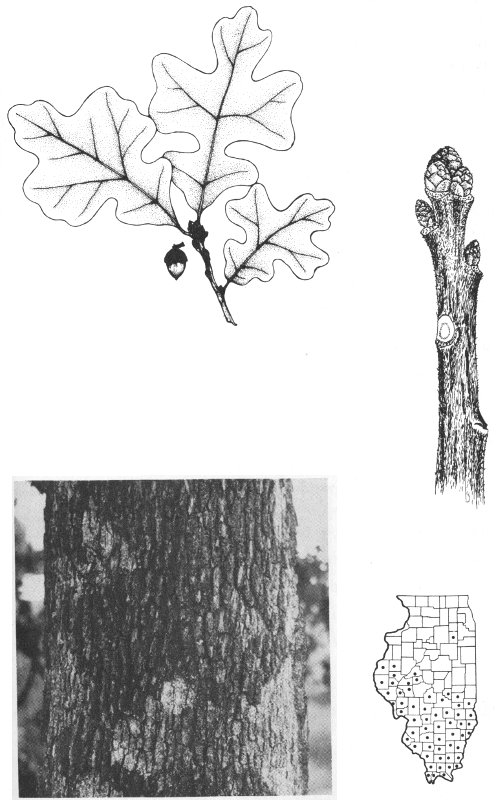
Other Name: Yellow-bark Oak.
Growth Form: Large tree up to 80 feet tall; trunk diameter up to 3½ feet; crown broadly rounded or oblong, with spreading branches; trunk straight, columnar, scarcely buttressed at the base.
Bark: Black, with a yellow or orange inner bark, deeply furrowed.
Twigs: Slender or rather stout, reddish-brown to dark brown; pith star-shaped in cross-section; leaf scars alternate but clustered near the tip, half-round, slightly elevated, with several bundle traces.
Buds: Pointed, angular, gray or reddish-brown, hairy, up to ½ inch long.
Leaves: Alternate, simple; blades deeply to shallowly 7- to 9-lobed, the lobes bristle-tipped, dark green, shiny and usually smooth on the upper surface, smooth, finely hairy, or hairy only along the veins on the lower surface, up to 10 inches long and 8 inches wide; leaf stalk up to 5 inches long, stout, smooth or finely hairy.
Flowers: Staminate and pistillate borne separately, but on the same tree, appearing when the leaves begin to unfold, minute, without petals, the staminate in slender, drooping clusters, the pistillate in groups of 1-4.
Fruit: Acorns solitary or 2 together, with or without a short stalk, the nut ovoid or ellipsoid, up to ¾ inch long, reddish-brown, not more than ½ enclosed by the cup, the cup with scales not appressed at the tip, thus appearing ragged.
Wood: Hard, heavy, coarse-grained, reddish-brown.
Uses: General construction, fuel, fence posts.
Habitat: Mostly upland woods.
Range: Maine across to south-central Minnesota, south to eastern Texas, east to northern Florida.
Distinguishing Features: Black Oak is easily distinguished by its large, angular, gray-hairy buds and its acorns with their ragged-edged cup.
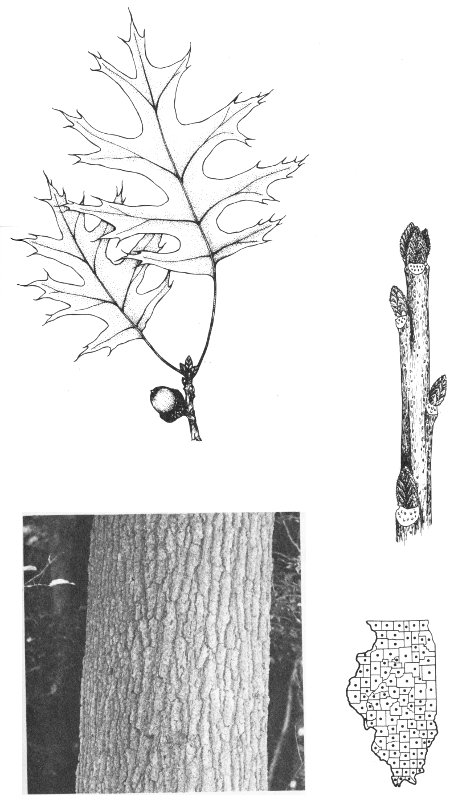
Growth Form: Small tree to 30 feet tall; trunk diameter up to 6 inches; crown spreading.
Bark: Gray, somewhat roughened.
Twigs: Slender, gray or pale brown, smooth or somewhat hairy; leaf scars alternate, crescent-shaped, with 3 bundle traces.
Buds: Lance-shaped, pointed, up to ¼ inch long, very hairy.
Leaves: Alternate, simple; blades elliptic, short-pointed at the tip, tapering or somewhat rounded at the base, up to 6 inches long, up to 2 inches broad, finely toothed or toothless along the edges, dark green, smooth, and glossy on the upper surface, paler and smooth or finely hairy on the lower surface; leafstalks finely hairy, up to 1 inch long.
Flowers: Few in umbrella-like clusters, inconspicuous, appearing when the leaves are nearly grown, each flower with 5 small petals.
Fruit: Spherical berries, up to ⅓ inch in diameter, red and shiny, containing 2-4 seeds.
Wood: Hard, light in weight, close-grained, light brown.
Use: Fuel.
Habitat: Rocky woods and along streams.
Range: Virginia across to Kansas, south to Texas, east to Florida.
Distinguishing Features: The Carolina Buckthorn is distinguished by its shiny, elliptical leaves, its red berries, and its small stature.
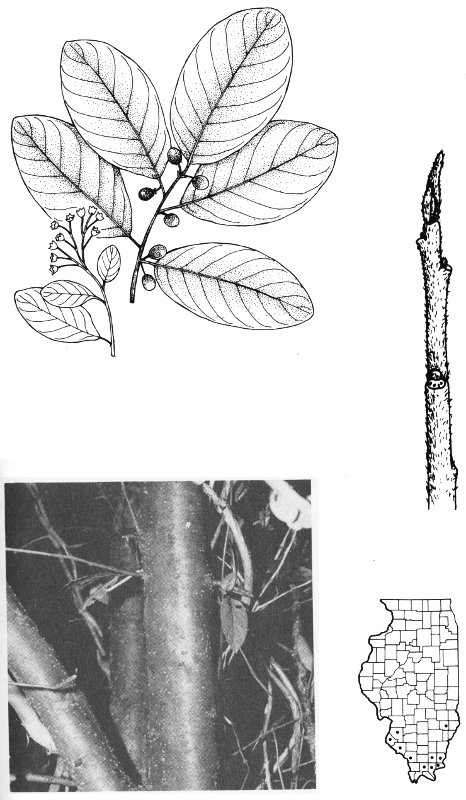
Growth Form: Small tree to 25 feet tall, often branching from near the base; trunk diameter up to 10 inches; crown spreading and irregular.
Bark: Gray to brown, roughened when mature.
Twigs: Gray to brown, usually smooth, some of them usually ending in a spine; leaf scars opposite to nearly so, narrow, with 3 bundle traces.
Buds: Lanceolate, brown, smooth, up to ¼ inch long.
Leaves: Broadly elliptic to ovate to nearly orbicular, rounded to pointed at the tip, usually rounded at the base, up to 2½ inches long and up to 1½ inches wide, finely toothed along the edges, smooth on both surfaces, the veins prominent; leafstalks slender, smooth, up to 1 inch long.
Flowers: Borne in clusters from the axils of the leaves, during May and June, some of them either only staminate or only pistillate, some of them with both stamens and pistils, each flower with 4 small petals.
Fruit: Nearly round, fleshy, black, up to ¼ inch in diameter, bitter, containing 3 or 4 seeds.
Wood: Heavy, hard, durable, yellowish, fine-grained.
Uses: This tree is sometimes planted as an ornamental hedge. The wood is used in making such things as tool handles. The fruits serve as a powerful purging agent.
Habitat: Thickets.
Range: Native of Europe and Asia; naturalized throughout much of northeastern North America.
Distinguishing Features: The spine-tipped twigs, nearly opposite leaves, and small black fruits readily distinguish this species.

Other Names: Dwarf Sumac; Winged Sumac.
Growth Form: Small tree to 35 feet tall; trunk diameter up to 6 inches; crown widely spreading.
Bark: Dark brown, roughened.
Twigs: Rather stout, gray-brown to reddish-brown, sometimes hairy, with conspicuous red lenticels; leaf scars alternate, U-shaped, elevated with 6-9 bundle traces.
Buds: More or less rounded, rusty-hairy, about ⅛ inch long.
Leaves: Alternate, pinnately compound, with as many as 21 leaflets; leaflets oblong to elliptic, up to 3 inches long and 1 inch broad, sharp pointed at the apex, tapering or rounded at the sometimes asymmetrical base, smooth or with low teeth along the edges, dark green, smooth and shiny on the upper surface, paler and hairy on the lower surface, all leaflets attached to a winged stalk. The leaves turn a deep red or wine color in the autumn.
Flowers: Staminate and pistillate sometimes borne on separate plants, sometimes on the same plant, sometimes in the same flower, numerous in much branched clusters, appearing from late May to mid-August, each flower greenish-yellow, small.
Fruit: Cluster of red berries, each berry round, finely hairy, up to ⅛ inch in diameter, containing a single orange seed.
Wood: Light in weight, soft, coarse-grained, pale brown.
Use: Sometimes grown as an ornamental.
Habitat: Dry hills, fields.
Range: Maine across southern Michigan to eastern Nebraska, south to Texas, east to Florida.
Distinguishing Features: The Shining Sumac is readily distinguished by the winged stalk to which the leaflets are attached.
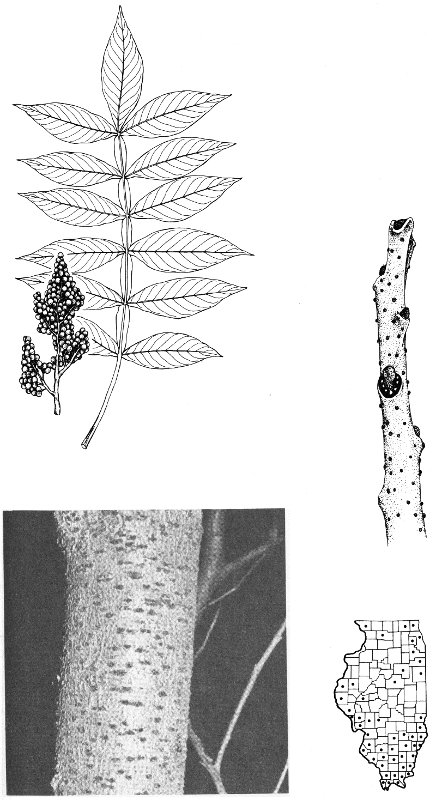
Growth Form: Small tree up to 20 feet tall; trunk diameter up to 8 inches; crown widely spreading.
Bark: Light brown, smooth on young plants, becoming somewhat rough at maturity.
Twigs: Stout, angular, smooth, reddish-brown or greenish-brown and covered by a whitish coat which can be wiped off, leaf scars alternate, nearly encircling the bud, elevated, with 6-9 bundle traces.
Buds: More or less rounded, smooth, about ⅛ inch long.
Leaves: Alternate, pinnately compound, with up to 31 leaflets; leaflets lance-shaped, up to 4 inches long, less than 2 inches broad, sharp pointed at the apex, tapering or rounded at the often asymmetrical base, toothed along the edges, green and smooth on the upper surface, nearly white and smooth on the lower surface. The leaves turn red in the autumn.
Flowers: Staminate and pistillate sometimes borne on separate plants, sometimes on the same plant, sometimes in the same flower, numerous in much branched clusters, appearing from late May to mid-August, each flower greenish-yellow, small.
Fruit: Cluster of red berries, each berry round, smooth, up to ⅛ inch in diameter, containing a single brown seed.
Wood: Light in weight, soft, pale.
Use: Sometimes grown as an ornamental.
Habitat: Woods, fields, disturbed areas.
Range: Nova Scotia across to Manitoba and North Dakota, south to Texas, east to Florida; also in Mexico.
Distinguishing Features: This species lacks the winged leaf stalks of the Shining Sumac and lacks the velvety twigs of the Staghorn Sumac.

Growth Form: Small to medium tree up to 40 feet tall; trunk diameter up to 15 inches; crown broadly rounded or sometimes flat.
Bark: Dark brown, smooth at first, becoming scaly in age.
Twigs: Stout, dark brown, covered by velvety hairs; leaf scars nearly encircling the twigs, with 6-9 bundle traces.
Buds: More or less rounded, hairy, about ⅛ inch long.
Leaves: Alternate, pinnately compound, with up to 31 leaflets; leaflets lance-shaped, up to 5 inches long, less than 2 inches broad, pointed at the tip, tapering or rounded at the usually asymmetrical base, toothed along the edges, dark green and smooth on the upper surface, paler and smooth except for the hairy veins on the lower surface. The leaves turn purple to red to orange in the autumn.
Flowers: Staminate and pistillate sometimes borne on separate plants, sometimes on the same plant, sometimes in the same flower, numerous in much branched clusters, appearing from June to August, each flower greenish, greenish-yellow, or reddish.
Fruit: Dense cluster of red berries, each berry round, conspicuously hairy, up to ⅛ inch in diameter, containing a single brown seed.
Wood: Light in weight, soft, coarse-grained, orange.
Use: Sometimes grown as an ornamental.
Habitat: Woods and thickets.
Range: Nova Scotia across to Minnesota, south to Iowa and Kentucky, east to North Carolina.
Distinguishing Features: The densely velvety twigs are distinctive for this species.
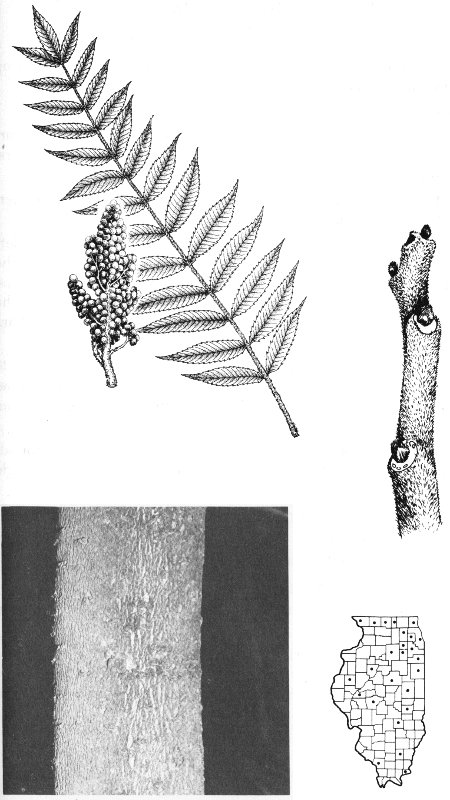
Growth Form: Small tree or shrub to 20 feet tall; trunk diameter up to 5 inches; crown narrowly rounded.
Bark: Gray, smooth.
Twigs: Rather stout, smooth, orange-brown to gray; leaf scars alternate, rounded except for where the bud is, with several bundle traces.
Buds: Rounded or somewhat pointed, about ¼ inch in diameter, except for the larger, terminal one, hairy, often purplish.
Leaves: Alternate, pinnately compound, with 7-13 leaflets; leaflets elliptic to obovate, pointed at the tip, rounded or tapering to the base, up to 4 inches long, up to half as wide, dark green and smooth on the upper surface, paler and usually smooth on the lower surface, the edges without teeth. The leaves turn a brilliant scarlet in the autumn.
Flowers: Staminate and pistillate sometimes borne on separate plants, sometimes on the same plant, sometimes in the same flower, numerous in much branched clusters, appearing from May to July, each flower greenish-yellow, small.
Fruit: Cluster of white or creamy berries, each berry round, smooth, shiny, up to ½ inch in diameter, containing a single yellow seed.
Wood: Soft, light in weight, coarse-grained, yellow-brown.
Use: Little used because of the extremely poisonous nature of most parts of the plant to the touch.
Habitat: Bogs and swampy woods.
Range: Maine across southern Ontario to Minnesota, south to Texas, east to Florida.
Distinguishing Features: This species differs from other sumacs with numerous leaflets by the absence of teeth along the edges of the leaves and by the absence of a winged stalk between the leaflets.
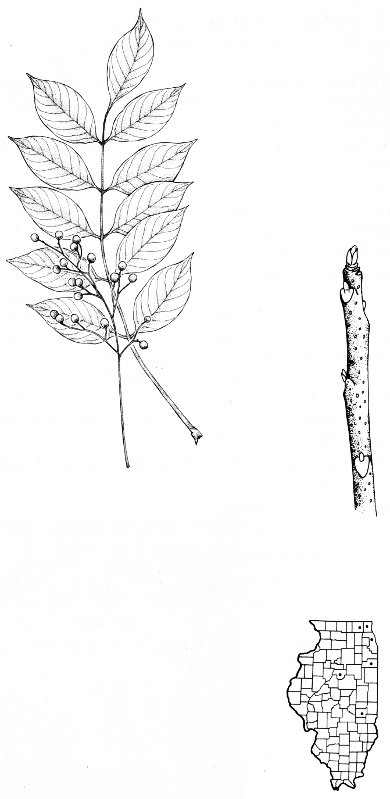
Growth Form: Moderate tree up to 70 feet tall; trunk diameter up to 2½ feet; crown narrowly oblong, with irregularly ascending or spreading branches.
Bark: Gray or black, deeply furrowed, with numerous, elevated, scaly ridges.
Twigs: Slender but strong, angular, often zigzag, reddish-brown, with a pair of short, sharp thorns where each leaf is attached; leaf scars alternate, three-lobed, with 3 bundle traces per lobe.
Buds: Sunken in the twigs, dark brown, without bud scales, up to one-eighth inch long.
Leaves: Alternate, pinnately compound, with 7-21 leaflets; leaflets oval, rounded at both ends but usually with a short point at the tip, without teeth, blue-green and smooth on the upper surface, paler and smooth on the lower surface except for the veins, up to two inches long and nearly half as wide. The leaflets turn yellow in the autumn.
Flowers: In long, drooping clusters, white with a yellow spot, very fragrant, up to 1 inch long, appearing in May and June.
Fruit: Legumes up to 4 inches long and about ½ inch wide, flat, smooth, reddish-brown, with 4-8 seeds.
Wood: Hard, heavy, strong, brown.
Uses: Fence posts, tool handles; often planted as an ornamental.
Habitat: Woodlands, thickets, roadsides.
Range: Pennsylvania across to Oklahoma, east to Georgia; often planted in other regions of the eastern United States.
Distinguishing Features: The pinnately compound leaves with up to 21 oval, smooth-edged leaflets, together with the pairs of spines, serve to distinguish this species.
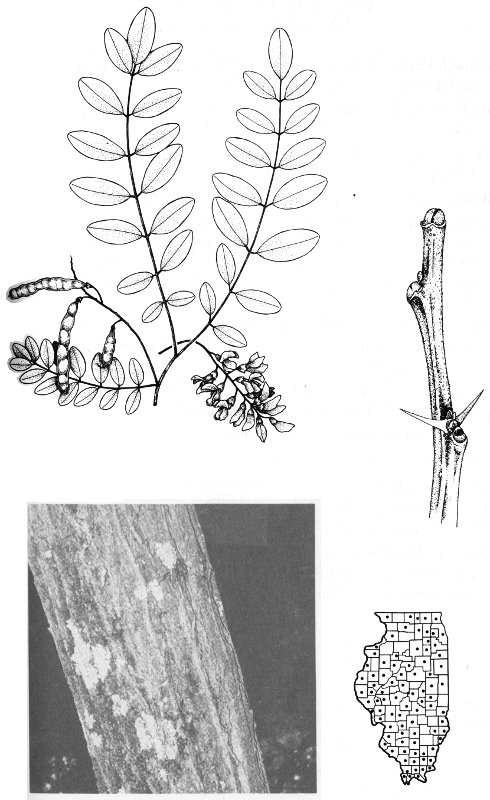
Growth Form: Moderate tree up to 60 feet tall; trunk diameter up to 1½ feet; crown narrowly rounded.
Bark: Grayish-brown, shallowly furrowed, becoming somewhat scaly.
Twigs: Slender, pale brown to grayish, smooth; leaf scars alternate, U-shaped, with 3 bundle traces.
Buds: Small, oblong, brown, up to one-sixth inch long.
Leaves: Alternate, simple; blades broadly lance-shaped, long-pointed at the tip, rounded or tapering to the base, up to 5 inches long, finely toothed along the edges, dark green and shiny on the upper surface, pale on the lower surface; leaf stalks up to ½ inch long.
Flowers: Staminate and pistillate flowers borne on separate trees, minute, crowded into elongated catkins, appearing as the leaves begin to unfold.
Fruit: Several rather broad, flask-shaped, brown capsules up to one-sixth inch long, crowded in elongated clusters.
Wood: Light weight, soft, pale brown.
Use: Fuel.
Habitat: Along streams, around lakes and ponds.
Range: Vermont across southern Ontario to British Columbia, south to New Mexico, east across southern Illinois to central New York.
Distinguishing Features: This willow has broader leaves than almost any other willow in Illinois. The pale lower surface of the leaves also distinguishes it from the Black Willow.
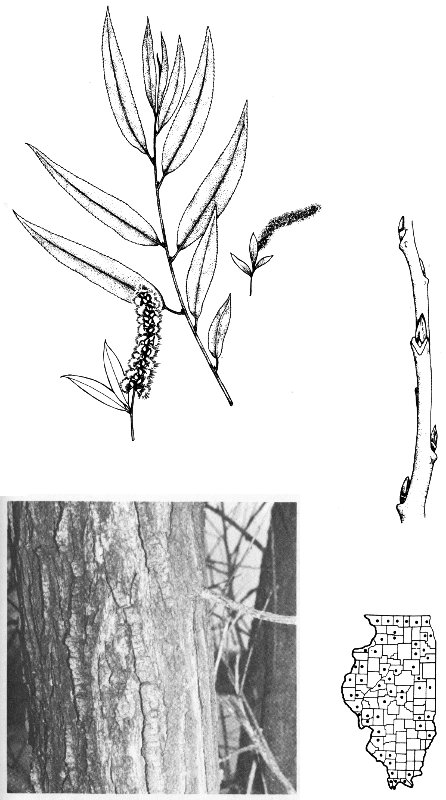
Other Name: Ward’s Willow.
Growth Form: Medium tree to 40 feet tall; trunk diameter up to 1 foot; crown widely spreading, often irregular.
Bark: Dark brown to gray to black, scaly and ridged.
Twigs: Slender, brown, usually finely hairy; leaf scars alternate, U-shaped, with 3 bundle traces.
Buds: Small, oblong, reddish-brown, smooth, up to one-eighth inch long.
Leaves: Alternate, simple; blades lanceolate, long-pointed at the tip, tapering to the base, up to 5 inches long and up to 1 inch broad, finely toothed along the edges, green and smooth on the upper surface, whitish and smooth on the lower surface; stipules conspicuous; leafstalks up to ½ inch long, hairy.
Flowers: Staminate and pistillate flowers borne on separate trees, appearing as the leaves begin to unfold, crowded in elongated, yellowish, hairy catkins.
Fruit: Several narrow, flask-shaped, brownish capsules up to ¼ inch long, crowded in elongated clusters.
Wood: Light weight, soft, not strong.
Use: Fuel.
Habitat: Moist woods, along streams.
Range: Maryland across southern Illinois to Kansas, south to Texas and Florida.
Distinguishing Features: The leaves of the Carolina Willow are shaped similarly to those of the Black Willow, but differ by being whitened on the lower surface.
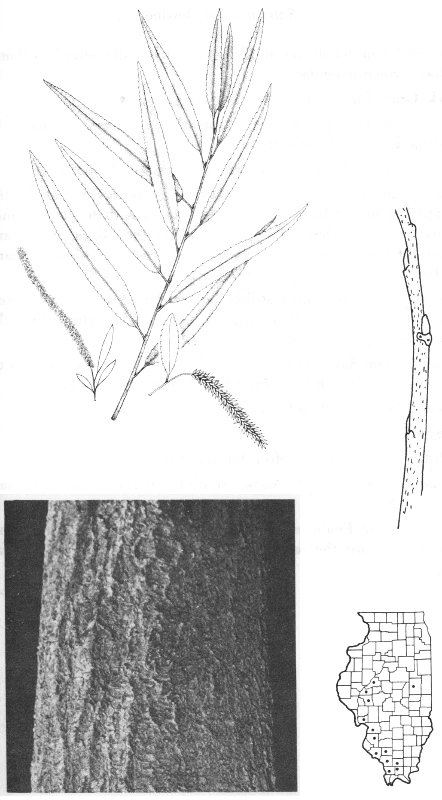
Growth Form: Small tree to 25 feet tall; trunk diameter less than 1 foot; crown irregular.
Bark: Gray, furrowed, broken into rough scales.
Twigs: Slender, grayish-green, smooth; leaf scars alternate, U-shaped, with 3 bundle traces.
Buds: Small, oblong, pale brown, up to one-sixth inch long.
Leaves: Alternate, simple; blades very narrow, pointed at the tip, tapering to the base, to 4 inches long, less than one-half inch broad, with widely spaced teeth along the edges, green and usually smooth on both surfaces when mature; leafstalks nearly absent.
Flowers: Staminate and pistillate flowers borne on separate trees, minute, crowded into elongated catkins, appearing when the leaves are partly grown.
Fruit: Several flask-shaped, brownish, smooth or silky capsules up to one-eighth inch long, crowded in elongated clusters.
Wood: Light weight, soft, weak.
Use: Fuel.
Habitat: Along streams, often forming thickets.
Range: Quebec across to Alaska, south to Oklahoma and Arkansas, east to Maryland.
Distinguishing Features: The best characteristics to identify this small tree are the narrow leaves with the teeth relatively far apart.

Growth Form: Medium to large tree up to 90 feet tall; trunk diameter up to three feet; crown usually round-topped, but sometimes irregular.
Bark: Rough, furrowed, forming elongated, vertical, rather tight scales.
Twigs: Slender, olive-green, smooth; leaf scars alternate, U-shaped, with 3 bundle traces.
Buds: Small, oblong, reddish-brown, up to one-eighth inch long.
Leaves: Alternate, simple; blades narrowly lance-shaped, usually curved, long-pointed at the tip, rounded or tapering at the base, up to 6 inches long, finely toothed along the edges, green and shiny on the upper surface, smooth or hairy on the veins of the lower surface; leafstalks short, often surrounded at the base by a pair of green leaf-like stipules.
Flowers: Staminate and pistillate flowers borne on separate trees, minute, crowded in elongated catkins, appearing as the leaves begin to unfold.
Fruit: Several narrow, flask-shaped, reddish-brown capsules up to one-eighth inch long, crowded in elongated clusters.
Wood: Light weight, soft, not strong.
Uses: Flooring, boxes, crates, fuel.
Habitat: Wet ground, frequently along rivers and streams.
Range: New Brunswick across to Ontario, south to Texas, east to Florida.
Distinguishing Features: The narrow lance-shaped leaves which are green on the lower surface and which have many fine teeth along the edges distinguish this willow from other willows in Illinois.
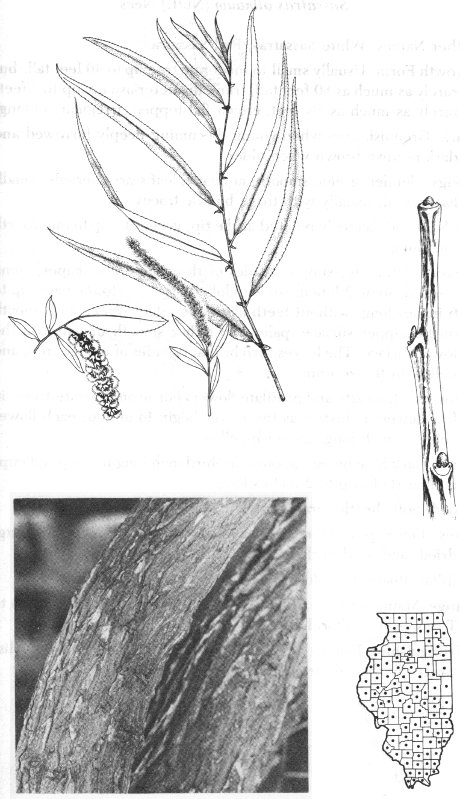
Other Names: White Sassafras; Red Sassafras.
Growth Form: Usually small to moderate tree up to 40 feet tall, but rarely as much as 80 feet tall; trunk diameter usually up to 2 feet, rarely as much as six feet; crown flat-topped, irregular, oblong.
Bark: Greenish-gray when young, becoming deeply furrowed and dark reddish-brown when older.
Twigs: Slender, green, smooth, aromatic; leaf scars alternate, small, half-round, usually with three bundle traces.
Buds: Ovoid, scarcely pointed at the tip, greenish, up to one-fourth inch long.
Leaves: Alternate, simple; blades of three different shapes, some 3-lobed, some 2-lobed, some unlobed, tapering to the base, up to 6 inches long, without teeth along the edges, green and smooth on the upper surface, paler and either smooth or hairy on the lower surface. The leaves turn brilliant shades of orange, red, and yellow in the autumn.
Flowers: Staminate and pistillate flowers borne on separate trees, in few-flowered clusters as the leaves begin to unfold, each flower about ⅓ inch long, greenish-yellow.
Fruit: Dark blue berries about one-third inch long in deep red cups and on stalks up to 2 inches long.
Wood: Soft, brittle, orange-brown.
Uses: Fence posts; the roots are strongly aromatic and are dug, dried, and used in the making of sassafras tea.
Habitat: Roadsides, old fields, woods.
Range: Maine across to Michigan and (formerly) Wisconsin, south to Texas, east to Florida.
Distinguishing Features: The Sassafras is distinguished by its distinctively shaped, aromatic leaves and its green twigs.
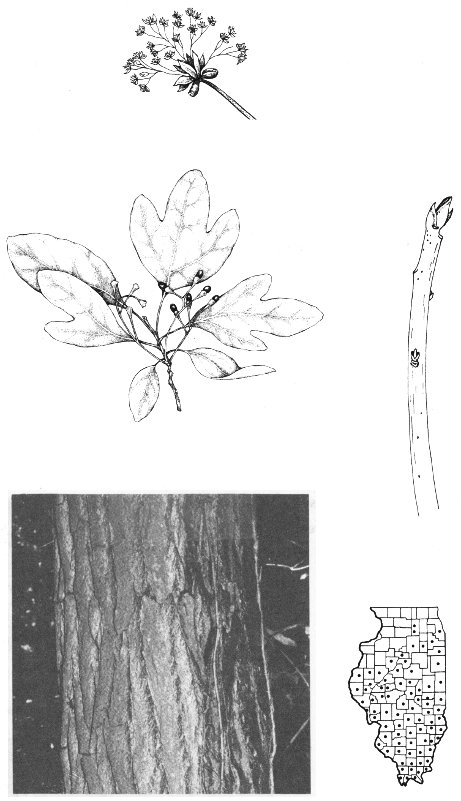
Growth Form: Large tree to over 100 feet tall; trunk diameter up to 8 feet; crown open and spreading to pyramidal; base of trunk often swollen; “knees” usually produced if tree is growing in water.
Bark: Pale reddish-brown, broken into numerous thin scales, becoming fibrous.
Twigs: Slender, reddish-brown; leaf scars absent.
Buds: Spherical, up to ⅛ inch in diameter, pale brown.
Leaves: Needles borne singly, pointed at the tip, up to ¾ inch long, yellow-green, falling away during the autumn.
Flowers: Staminate borne in branched clusters up to 5 inches long, purplish; pistillate few to several near the ends of the twigs, spherical.
Fruit: Cones nearly spherical, up to 1 inch in diameter, green to brown, wrinkled in appearance.
Wood: Soft, durable, light in weight, brown.
Uses: Railroad ties, fence posts, barrels, bridges; often planted as an ornamental.
Habitat: Swamps and low, wet woods.
Range: New Jersey across to southern Illinois and southern Missouri to eastern Texas, east to Florida.
Distinguishing Features: Bald Cypress is distinguished by the feathery appearance of its leaves and by its spherical, wrinkled cones.
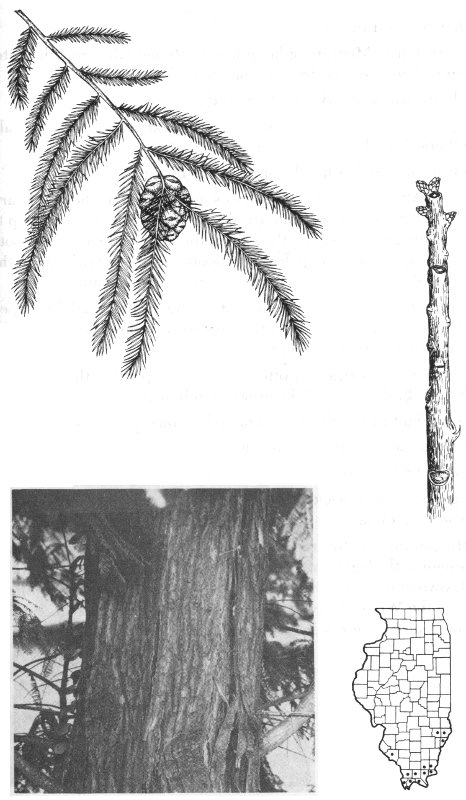
Other Name: Linden.
Growth Form: Medium or large tree to 80 feet tall; trunk diameter up to 2 feet; crown broadly rounded.
Bark: Brown, scaly, deeply furrowed.
Twigs: Slender, gray or brown, smooth; leaf scars alternate, half-elliptical, with 3 to several bundle traces.
Buds: Ovoid, red, smooth, up to ¼ inch long.
Leaves: Alternate, simple; blades ovate, pointed at the tip, heart-shaped at the very asymmetrical base, up to 8 inches long, up to ⅔ as broad, coarsely toothed along the edges, green and smooth on the upper surface, paler and smooth or with tufts of hair on the lower surface; leafstalks up to 2 inches long, smooth.
Flowers: Few in clusters on a long stalk attached to a paddle-shaped structure, each flower fragrant, greenish-yellow, with 5 petals, appearing in June and July.
Fruit: Hard, spherical but often with a short point at the tip, up to ⅓ inch in diameter, light brown, finely hairy.
Wood: Light in weight, close-grained, strong, not durable.
Uses: Coarse construction, furniture, paper pulp, fuel.
Habitat: Rich woods.
Range: New Brunswick across to Manitoba, south to Texas, east to North Carolina.
Distinguishing Features: The large, heart-shaped leaves sometimes resemble the leaves of the Red Mulberry, but the leafstalks of the Basswood do not have milky sap in them. The Basswood differs from the White Basswood by the virtual absence of hairs on the lower surface of the leaves.
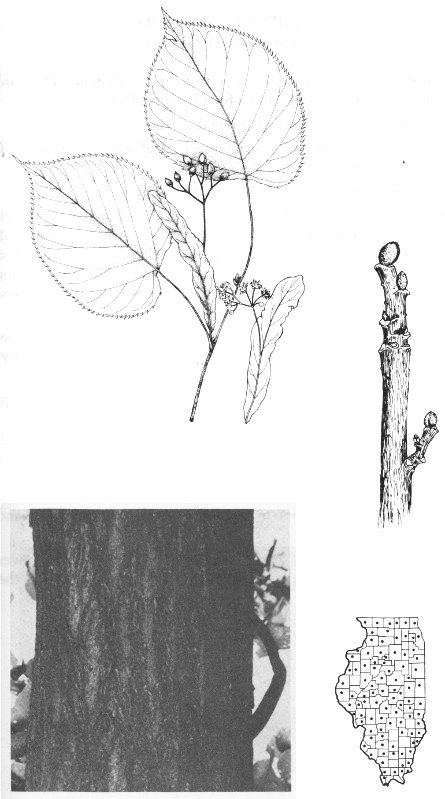
Growth Form: Medium to large tree up to 70 feet tall; trunk diameter up to 2 feet; crown broadly spreading.
Bark: Brown, scaly, deeply furrowed.
Twigs: Slender, pale red-brown, smooth; leaf scars alternate, half-elliptical, with 3 to several bundle traces.
Buds: Ovoid, red, usually smooth, up to ¼ inch long.
Leaves: Alternate, simple; blades ovate, pointed at the tip, heart-shaped at the asymmetrical base, up to 6 inches long, about half as wide, coarsely toothed along the edges, green and more or less smooth on the upper surface, densely covered with white hairs on the lower surface; leafstalks up to 2 inches long, more or less smooth.
Flowers: Several in clusters on a long stalk attached to a paddle-shaped structure, each flower fragrant, greenish-yellow, hairy, with 5 petals, appearing in June and July.
Fruit: Hard, more or less spherical, somewhat pointed at the tip, up to ⅓ inch in diameter, reddish-brown, finely hairy.
Wood: Light in weight, close-grained, strong, not durable.
Uses: Paper pulp, fuel.
Habitat: Low, moist woods.
Range: New York across to Missouri, south to Mississippi and Georgia.
Distinguishing Features: The dense coat of white hairs on the lower surface of the leaves distinguishes the White Basswood from the Basswood.
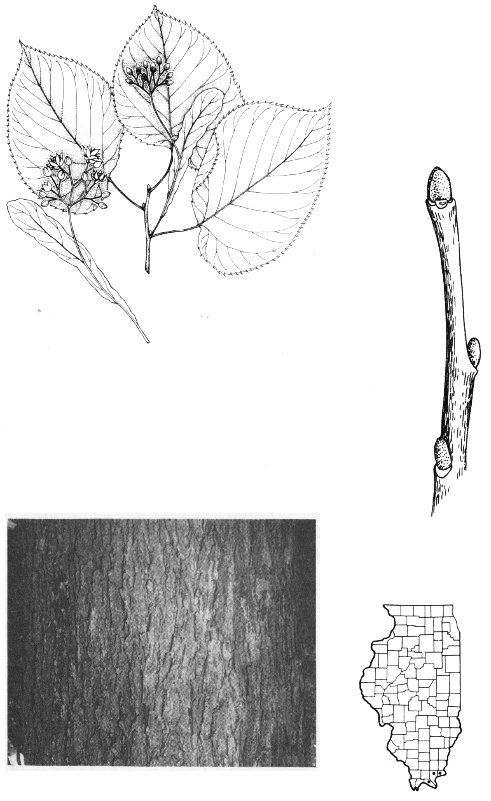
Other Name: Wahoo Elm.
Growth Form: Small or moderate tree to 60 feet tall; trunk diameter up to 2 feet, but usually much smaller; crown oblong and relatively narrow.
Bark: Dark gray, with shallow furrows.
Twigs: Slender, gray or brown, more or less zigzag, smooth, often with corky wings; leaf scars alternate, half-round, each with 3 bundle traces.
Buds: Narrow, pointed, brown, smooth or slightly hairy, up to one-fourth inch long.
Leaves: Alternate, simple; blades elliptic to oblong-lanceolate, pointed at the tip, rounded at the slightly asymmetrical base, up to three inches long, doubly toothed along the edges, green and smooth or slightly roughened on the upper surface, paler and hairy on the lower surface; leafstalks short, stout, hairy.
Flowers: In drooping clusters of 2-7, appearing before the leaves unfold, greenish, hairy, small.
Fruit: Oblong, winged, up to one-third inch long, hairy along the edges, each wing notched at the top and surrounding a single central seed.
Wood: Heavy, hard, pale brown.
Uses: Tool handles, small wooden articles.
Habitat: Dry cliffs, wooded slopes, rarely low woods.
Range: Virginia across to Missouri, south to Texas, east to Florida.
Distinguishing Features: The corky wings identify the Winged Elm from all other Illinois elms except the Rock Elm. It differs from the Rock Elm by its shorter, hairy leaf stalks and its usually smaller leaves.
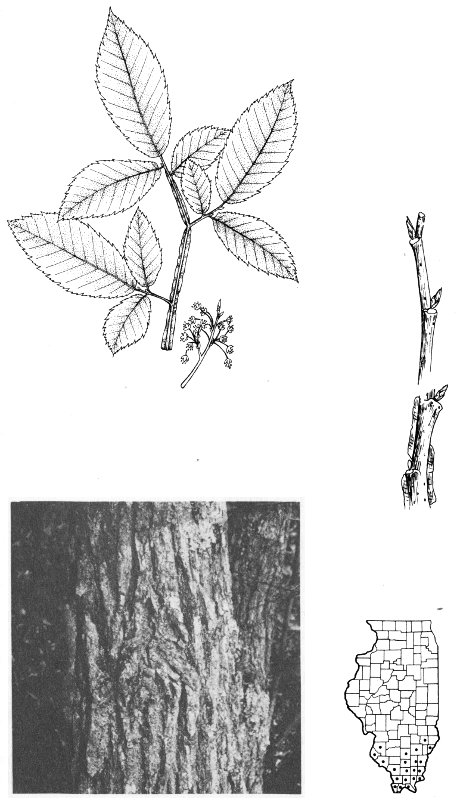
Other Name: White Elm.
Growth Form: Large tree up to 80 feet tall; trunk diameter up to 4 feet; crown broadly rounded or sometimes flat-topped, usually with drooping branchlets.
Bark: Light or dark gray, furrowed, at maturity breaking into thin plates.
Twigs: Brown, slender, smooth or sparsely hairy, often zigzag; leaf scars alternate, half-round, each with 3 bundle traces.
Buds: Broadly ovoid, reddish-brown, smooth or sparsely hairy, up to one-fourth inch long.
Leaves: Alternate, simple; blades oval to elliptic, pointed at the tip, strongly asymmetrical at the base, up to 6 inches long and about half as wide, coarsely doubly toothed along the edges, the upper surface dark green and smooth, the lower surface pale and either softly hairy or smooth; leafstalks very short, usually yellow.
Flowers: In drooping clusters of 3-4, appearing before the leaves unfold, greenish-red, hairy, small.
Fruit: Oval, winged fruits up to one-half inch long, hairy along the edges, each wing notched at the top and surrounding a single central seed.
Wood: Heavy, strong, pale brown.
Uses: Flooring, farm implements, shipbuilding; frequently planted as an ornamental and as a shade tree, but greatly diminished in number by the Dutch Elm disease and phloem necrosis.
Habitat: Bottomland woods, along streams.
Range: Nova Scotia across to southern Manitoba, south to central Texas, east to south-central Florida.
Distinguishing Features: American Elm may be distinguished from the Winged Elm and the Rock Elm by its lack of corky wings on the branchlets. It differs from the Slippery Elm by its relatively smooth leaves and the lack of rusty-colored hairs on its buds. The Siberian Elm, which is also similar, does not have distinctly asymmetrical leaves. Hackberry leaves, which are also somewhat similar in appearance, have three main veins originating at the base of each leaf blade.
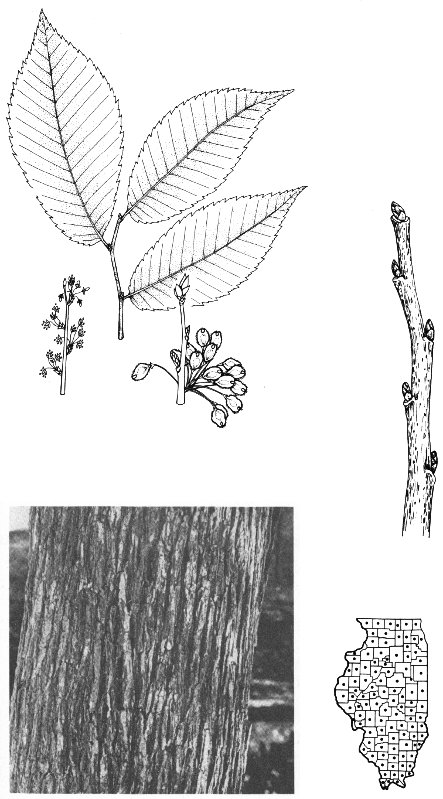
Growth Form: Small tree to 35 feet tall; trunk diameter up to 1 foot; crown broadly rounded, with slender branchlets.
Bark: Gray or brown, shallowly furrowed at maturity.
Twigs: Slender, brown or grayish, smooth; leaf scars alternate, half-round, with 3 bundle traces.
Buds: Spherical, reddish-brown, up to ⅛ inch in diameter, somewhat hairy.
Leaves: Alternate, simple; blades short-pointed at the tip, tapering or rounded at the asymmetrical base, up to 7 cm long, up to half as broad, mostly singly toothed along the edges, smooth on both surfaces; leafstalks very short, usually smooth.
Flowers: In drooping clusters of 2-5, appearing before the leaves begin to unfold, greenish, small, without petals.
Fruit: Nearly round, winged fruits, up to ½ inch in diameter, not notched, smooth, 1-seeded.
Wood: Hard, heavy, pale brown.
Use: Grown chiefly as an ornamental and frequently reproducing around old buildings.
Habitat: Along roads, around buildings.
Range: Native of Asia; widely planted in the United States and naturalized from Minnesota to Kansas and eastward.
Distinguishing Features: The Siberian Elm is distinguished by its small, smooth, singly-toothed leaves.
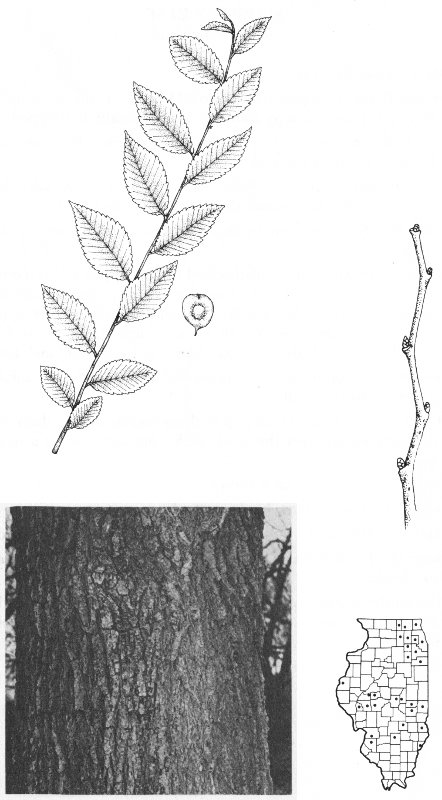
Other Name: Red Elm.
Growth Form: Moderate tree up to 80 feet tall; trunk diameter up to 4 feet; crown broadly rounded or occasionally flat-topped.
Bark: Reddish-brown to gray, with shallow furrows; the inner bark becomes slippery when chewed.
Twigs: Rather stout, reddish-brown, with short, gray hairs; leaf scars alternate, half-round, each with 3 bundle traces.
Buds: Nearly round, up to one-fourth inch in diameter, with rusty-colored hairs.
Leaves: Alternate, simple; blades oval to elliptic, pointed at the tip, strongly asymmetrical at the base, up to 7 inches long, about half as wide, coarsely doubly toothed along the edges, the upper surface green and very rough to the touch, the lower surface smooth or hairy; leafstalks stout, hairy, up to one-half inch long.
Flowers: In drooping clusters, appearing before the leaves unfold, greenish, hairy, small.
Fruit: Circular, winged fruits up to three-fourths inch in diameter, not hairy except over the seed, each wing surrounding a single seed.
Wood: Heavy, strong, dark brown.
Uses: Shipbuilding, farm implements, fence posts.
Habitat: Bottomland woods; along streams; rocky, upland woods.
Range: Quebec across Ontario to North Dakota, south to Texas, east to Florida.
Distinguishing Features: The rough, sandpapery texture of the asymmetrical leaves distinguishes this elm from all others in the state.
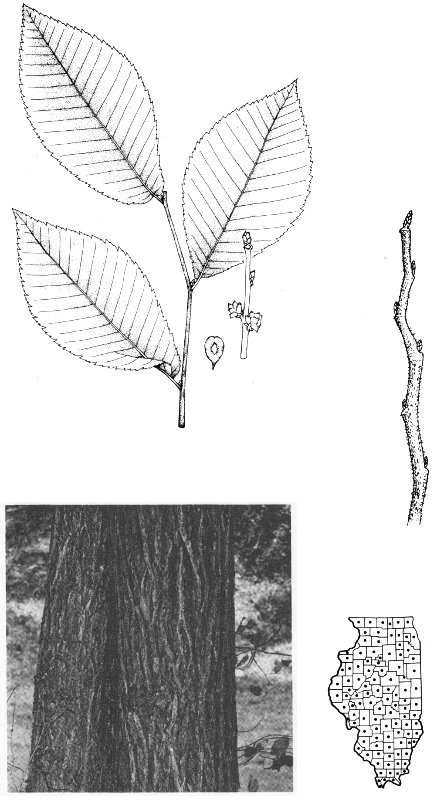
Other Name: Cork Elm.
Growth Form: Medium tree up to 75 feet tall; trunk diameter up to three feet; crown narrow, oblong, with drooping branches.
Bark: Grayish-brown, with shallow furrows.
Twigs: Slender, brown, smooth or finely hairy, usually with corky wings; leaf scars alternate, half-round, each with 3 bundle traces.
Buds: Lance-shaped, pointed, brown, more or less hairy, up to one-fourth inch long.
Leaves: Alternate, simple; blades oval to oblong, pointed at the tip, rounded at the slightly asymmetrical base, up to 4 inches long, doubly toothed, green, smooth, and shiny on the upper surface, paler and hairy on the lower surface; leafstalks up to one-half inch long, smooth.
Flowers: In drooping clusters of 2-4, appearing before the leaves begin to unfold, greenish-red, hairy, small.
Fruit: Oval, winged fruits up to one-half inch long, hairy, each wing with a shallow notch at the top and surrounding a single seed.
Wood: Hard, strong, heavy, close-grained, pale brown.
Uses: Railroad ties, farm implements, hockey sticks.
Habitat: Wooded slopes, rock ledges.
Range: Quebec to Ontario and Minnesota, southwestward to Kansas, east to Tennessee.
Distinguishing Features: Rock Elm differs from other elms in Illinois by its corky-winged twigs and its smooth leafstalks.
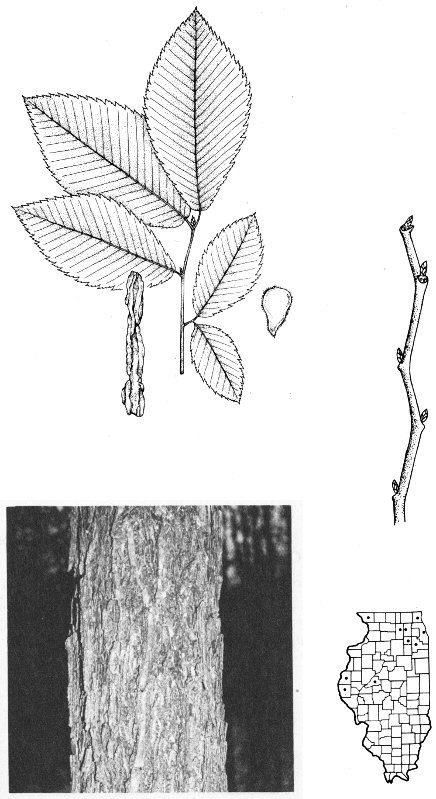
Other Names: Nannyberry; Wild Raisin; Sheepberry.
Growth Form: Small tree to 25 feet tall; trunk diameter up to 5 inches; crown rounded.
Bark: Reddish-brown, broken into irregular plates.
Twigs: Slender, grayish, sometimes with orange dots, smooth; leaf scars opposite, crescent-shaped, with 3 bundle traces.
Buds: Red, nearly smooth, long-pointed, up to ¾ inch long.
Leaves: Opposite, simple; blades ovate, pointed at the tip, tapering or rounded at the base, up to 3 inches long, about half as wide, sharply and finely toothed along the edges, green and slightly hairy on the upper surface, yellow-green and minutely black-dotted on the lower surface; leafstalks up to 1½ inches long, sometimes rusty-hairy, winged.
Flowers: Many in broad, round-topped clusters, slightly fragrant, appearing during April and May, each flower small and creamy-white.
Fruit: Fleshy, oval to ellipsoid, blue-black, up to ½ inch long, sweet, containing a single stone.
Wood: Hard, heavy, close-grained, dark orange-brown.
Use: Sometimes planted as an ornamental.
Habitat: Rocky woods; woods along streams.
Range: Quebec across to Manitoba, south to Colorado, east across northern Illinois to Georgia.
Distinguishing Features: The Sweet Viburnum, like other viburnums, has opposite, simple leaves which are finely and sharply toothed. It differs from other viburnums in Illinois by its long-pointed leaves and its winged leaf stalks.
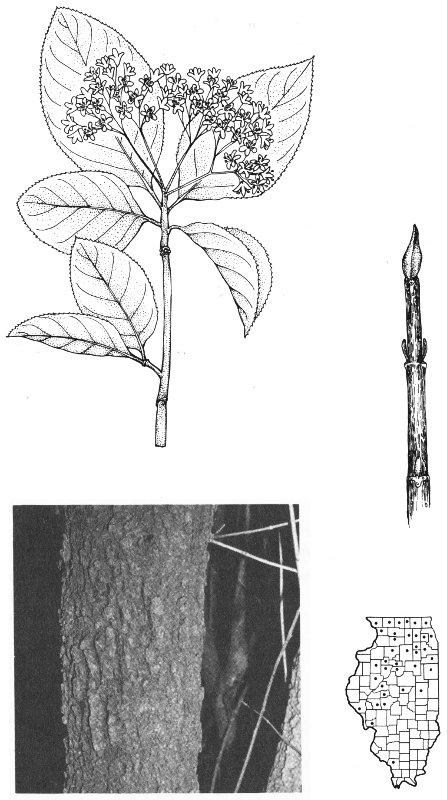
Other Name: Nannyberry.
Growth Form: Small tree to 25 feet tall; trunk diameter up to 6 inches; crown irregular.
Bark: Reddish-brown, broken into irregular plates.
Twigs: Slender, grayish, sometimes with orange dots, smooth; leaf scars opposite, crescent-shaped, with 3 bundle traces.
Buds: Brown, nearly smooth, up to ½ inch long.
Leaves: Opposite, simple; blades oval to ovate, short-pointed at the tip, rounded or tapering to the base, up to 3 inches long and 2 inches broad, finely and sharply toothed along the edges, dark green and smooth on the upper surface, paler and smooth on the lower surface; leafstalks up to ⅔ inch long, smooth, scarcely or not at all winged.
Flowers: Many in broad, round-topped clusters, appearing during April and May, each flower small and white.
Fruit: Fleshy, oval to ellipsoid, blue-black, up to ⅔ inch long, sweet, containing a single stone.
Wood: Hard, heavy, strong but brittle, coarse-grained, reddish-brown.
Use: Sometimes planted as an ornamental.
Habitat: Rocky woods.
Range: Connecticut across to Michigan, southwest to Kansas, south to Texas, east to Florida.
Distinguishing Features: Black Haw differs from the Sweet Viburnum by the absence of wings along the leafstalks. It differs from the Rusty Nannyberry by the absence of rusty hairs on the buds and leafstalks.
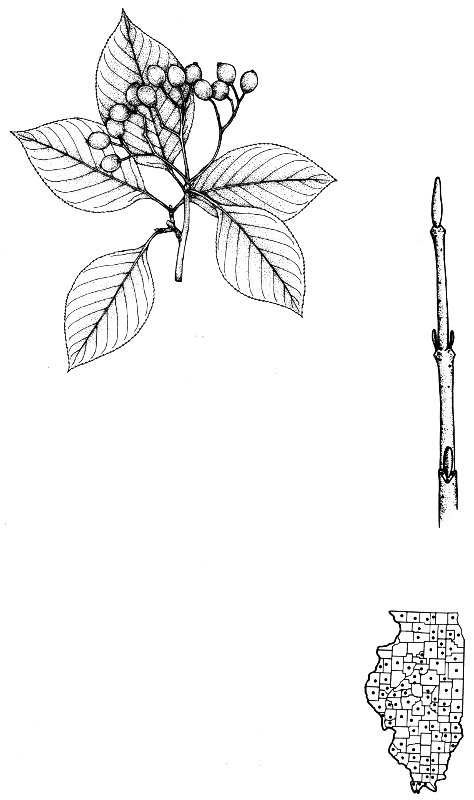
Other Name: Southern Black Haw.
Growth Form: Small tree to 30 feet tall; trunk diameter up to 8 inches; crown irregular.
Bark: Dark brown, broken into square plates.
Twigs: Slender, somewhat rusty-hairy; leaf scars opposite, crescent-shaped, with 3 bundle traces.
Buds: Rusty-hairy, up to ½ inch long.
Leaves: Opposite, simple; blades elliptic to obovate, short-pointed or rounded at the tip, rounded or tapering to the base, up to 3 inches long, about half as wide, sharply and finely toothed along the edges, dark green and usually smooth on the upper surface, paler and with some rusty hairs on the lower surface; leafstalks up to ¾ inch long, rusty-hairy.
Flowers: Many in broad, round-topped clusters, appearing during April and May, each flower small and creamy-white.
Fruit: Fleshy, oblong, to obovoid, blue-black, up to ⅔ inch long. sweet, containing a single stone.
Wood: Hard, heavy, strong but brittle, close-grained, dark orange-brown.
Use: Sometimes planted as an ornamental.
Habitat: Dry, rocky woods.
Range: Virginia across to Missouri, south to Texas, east to Florida.
Distinguishing Features: The most distinguishing characteristics of the Rusty Nannyberry are the rusty-hairy buds and leaf stalks.
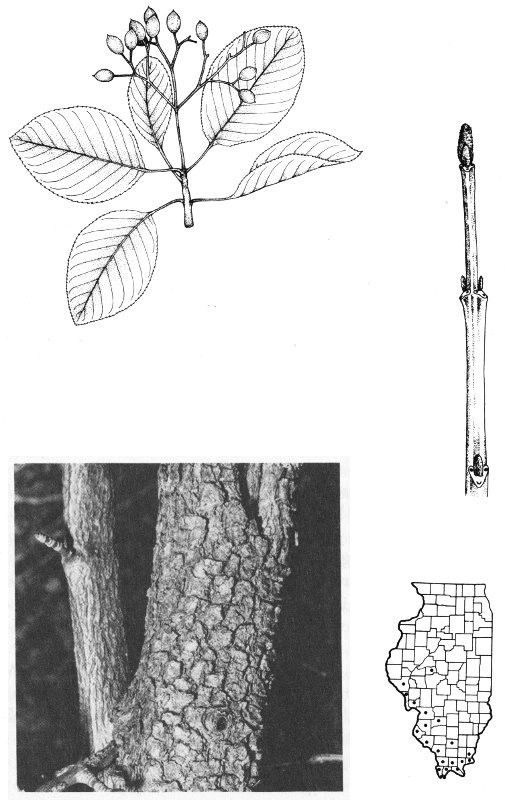
A number of places in the state of Illinois provide opportunities to study and to observe woody plants. Some of the major ones are briefly described below.
A good place to learn the trees of Illinois firsthand is the Morton Arboretum at Lisle, some twenty-five miles west of Chicago. This privately endowed educational and scientific institution is devoted to growing all kinds of woody plants that will survive in northern Illinois. On the Arboretum’s 1500 acres one can find large collections of oaks, maples, elms, ashes, lindens, junipers, pines, firs, spruces, and numerous other groupings of woody plants from places throughout the temperate world.
Certain collections in the Arboretum are along designated trails and are especially useful in learning to identify trees. Perhaps the most popular is the Illinois Trees Trail, where native trees are identified by plaques that show common and scientific names and give other interesting information about the trees. Another is the Evergreen Trail, which features conifers.
Some trails emphasize ecology or other aspects of biology but also feature trees. One of these is the Thornhill Trail, a general nature trail on which trees are prominent. Another trail links nearby nature study areas, including a mini-prairie, a wild flower garden, a northern coniferous forest, and a pond-marsh. A short garden trail, the Viburnum Walk, is unusual in that it utilizes a grouping of Viburnums and their relatives to illustrate some of the principles of plant classification.
Landscape plantings are another important feature in the Arboretum, and the extensive forested areas provide a dramatic backdrop for cultivated plantings that have been blended skillfully into the natural landscape. These are especially spectacular in spring when flowering trees are in bloom and in fall when the foliage is in color.
At the Morton Arboretum there is a continuous effort to learn more about the adaptability of trees and shrubs to the special growing conditions of northern Illinois, especially the soils and climate. The natural forests are being used as an outdoor laboratory for ecological studies, and certain cultivated collections are experimental. The Street Tree Collection, for example, is a large experimental assemblage of various trees thought to be suitable for street and shade purposes. The Heath (Ericaceous) Collection is valuable in determining the cultural requirements for growing certain azaleas and rhododendrons in northern Illinois.
The Morton Arboretum has been designed for learning through outdoor experiences. The grounds are open every day of the year, and visitors are always welcome. A modest admission fee is charged for each car entering. In the Visitor Center, an overall orientation is offered through exhibits and audio-visual presentations explaining the purposes and functions of the Arboretum. Groups planning to visit should request advance information about seasonal features, current hours, special programs, and eating facilities. The varied opportunities and abundant facilities at the Morton Arboretum make visits both pleasant and memorable.
The Illinois Natural History Survey is a research organization devoted to the scientific study of the living natural resources of Illinois. It is one of the Divisions of the Department of Registration and Education and is administered by a Board of Natural Resources and Conservation, consisting of the Director of the Department, the President of the University of Illinois, or his representative, the President of Southern Illinois University, or his representative, members and experts in the fields of geology, biology, chemistry, forestry, and engineering.
The Survey is organized into sections, five of which are engaged in scientific pursuits. These are aquatic biology, botany and plant pathology, economic entomology, faunistic survey, and wildlife. These sections pursue basic and scientific research in systematics, ecology, environmental quality, and control of plant diseases and insect pests. The zoological collections of the Survey, numbering about 8,800,000 specimens, rank among the largest and most valuable 320 in the world. The botanical collections are smaller in size. The vascular plant collections number over 145,000 specimens that are most representative for studies of distribution in Illinois. The mycological collections, with more than 35,000 specimens, include numerous types that are basic to scientific research.
The Survey is housed in the Natural Resources Building and the Natural Resources Studies Annex on the campus of the University of Illinois, Urbana. In addition, the Survey maintains special research facilities at Fox Ridge State Park, Stephen A. Forbes State Park, Havana, Sullivan, and elsewhere for studies of pond management, prairie chickens, pheasants, waterfowl, fish, and wildlife.
Southern Illinois University, Carbondale, has both a Department of Botany and a Department of Forestry where students may select courses from a broad curriculum to study various aspects of plant life. Many forest-oriented courses are available, and most of them include actual work in the field. The University has an arboretum on campus where ornamental species are emphasized. Guided tours of these arboreta, as well as of the display greenhouse, can be arranged by contacting the Chairman of the Department of Botany, Southern Illinois University, Carbondale, Illinois 62901.
The department has programs in instruction, research and public service. The instructional program offers professional undergraduate training in forest science and wood science and these are accredited by the Society of American Foresters. Graduate training is provided only at the Master’s level within the department. Doctoral work can be pursued through interdisciplinary programs in genetics, ecology, and plant physiology under the general direction of forestry staff who are members of these respective faculties.
Research is conducted at the main campus, the Dixon Springs Agricultural Center in southern Illinois (Pope County), Sinnissippi Forest in northern Illinois (Ogle County), and at other smaller outlying areas. Support is provided by the Agricultural Experiment Station and grants from industry and governmental agencies. Projects 321 cover a wide range of subjects related to the production and utilization of wood as well as the use of forests for non-timber values. The latter includes recreation and watershed management, with special emphasis on the role of forests and forestry in water quality.
At Dixon Springs the emphasis has been on the ecology and management of pine plantations. These plantings represent plant communities that have been interjected by man into the natural succession of abandoned agricultural land to forest. Factors affecting the growth of pine, and the effects of pine on soil conditions, stand composition, and the regeneration of native hardwood species are being investigated. Watershed management studies are also concentrated at Dixon Springs.
The 2,500-acre Sinnissippi Forest, a private estate provides the department with research opportunities. A nature tail is maintained as an outdoor laboratory that is widely used by both adult and youth groups. Sinnissippi Forest emphasizes the fact that a managed forest can be aesthetically pleasing.
Public service activities are carried on through the Cooperative Extension Service and provide advice and information to landowners, youth groups, and other citizens of the State. This is accomplished largely through group meetings and demonstrations and direct replies to individual requests for information. Major emphasis has been on establishment of windbreaks on farms in the prairie region; promotion of sound management practices for farm woodlands; and the care of trees in plantations and on farmsteads. Extension education emphasizes the development of an appreciation by Illinois youth for conservation of the forest resource; the promotion among adults of sound management of rural and urban woodlands; and program for primary and secondary industries that concerns the conversion of wood into useful products.
Much of the forested land in the southern tip of Illinois is in the Shawnee National Forest. The 257,000 acres of rolling topography in the forest contain 208 different kinds of native, woody plants. Some of the areas which have a high concentration of unusual plant life have been designated Botanical Areas by the United States Forest Service. At these areas, such as Little Grand Canyon, Jackson Hollow, Stone Face, and six others, plant life is protected. 322 These are excellent places to observe many of the woody plants of the State.
At other areas in the Shawnee National Forest, various forest management practices, such as selective timber-cutting, erosion control, and watershed protection, can be observed.
Numerous recreation facilities are dotted throughout the Shawnee. At many of these, nature trails have been developed which bring the hiker closer to nature. Descriptive brochures are available for most of the recreation areas. They may be obtained by visiting the district ranger offices at Vienna, Elizabethtown, Jonesboro, or Murphysboro, or by writing to the Forest Supervisor, Shawnee National Forest, Harrisburg, Illinois.
In 1972, the school children of Illinois selected the white oak, (Quercus alba L.), as the state tree. It is truly representative for it can be found throughout the state on a variety of sites. It grows to its largest size on upland, cool, well-drained coves, slopes, and terraces where it often reaches 100 feet of height and 3 feet of diameter.
White oak is one of Illinois’ most valuable trees. It makes an excellent shade tree of majestic beauty with a broad round head and wide spreading branches. Commercially it is an extremely valuable species used for lumber, veneer, barrels, furniture, flooring, and construction.
This species is also a part of our national heritage. In the war of 1812, sailors reported that during battle, cannon balls bounced off the hull of the U.S.S. Constitution. White oak helped make her “Old Ironsides” and a part of our history.
The Legislature has given this Division the responsibility for all activities concerning the forest and tree resource of Illinois. The Division strives to fulfill its responsibilities by:
323—protecting the resource against all detrimental factors such as fire, insects and diseases, improper harvesting, etc.
—making the public aware of the importance of this resource to the state’s health and economy.
—motivating and providing technical guidance to forest and tree owners for proper management.
—practicing and demonstrating proper forest management principles on Department lands.
The main objectives of this Division are to promote and achieve on suitable public and private lands the establishment, protection, management, use, and perpetuation of our tree resource for all of the benefits which may be derived from them.
The Division cooperates with and makes full use of federal, state, and private agency programs, efforts and monies to achieve Division objectives and benefit forestry in Illinois. Formal cooperative agreements exist with the United States Forest Service, U.S.D.A. Soil Conservation Service, Extension Service and other groups, associations and clubs active in forestry and its related fields.
The efforts of the Division are channeled through five disciplines: fire control, forest management, reforestation, marketing and utilization, and urban and community forestry. Each of these sections has technical leadership at state level plus resource specialists for field accomplishments. These five efforts intertwine very strongly at field level where all personnel carry out certain parts of these programs in designated geographic areas.
The Division of Forestry is cooperating with the American Forestry Association in an attempt to find the biggest trees of each kind in the United States and/or in Illinois. If you know of a tree that you think might qualify, send the following information to the State Forester’s office in Springfield: species, trunk circumference in inches (measured 4½ feet above the ground); total tree height in feet; and, average width of crown in feet. If your candidate appears to be a winner, a state forester will be sent to determine the exact measurements. If it is a winner your name, the kind of tree and its dimension will be placed on our list. You will receive a certificate stating that you have found a “Big Tree Champion.”
A B C D E F G H I J K L M N O P Q R S T U V W X Y Z
1. MT. CARROLL (815-244-3655)
Junction Rts. 78 & 88
P.O. Box 105 61053
2. OREGON (815-732-6184)
Ogle County Farm Bureau
P.O. Box 223 61061
3. LISLE (312-964-8081)
Morton Arboretum
P.O Box 472 60532
4. CAMBRIDGE (309-937-2122)
301 East North Street
P.O. Box 126 61238
5. PRINCETON (815-875-3125)
222 South Main
P.O. Box 236 61356
6. MACOMB (309-837-1124)
W. Jackson Rd. (Hwy. #136)
P.O. Box 335 61455
7. PEKIN (309-347-5119)
133 Parkway Dr.
P.O. Box 795 61554
8. HAVANA (309-543-3401)
720 S. 10th Street
P.O. Box 401 62644
9. SHELBYVILLE (217-644-2411)
Hidden Springs State Forest
P.O. Box 148 62565
10. CHARLESTON (217-345-2420)
Rt. 16 & Harrison St. Rd.
P.O. Box 129 61920
11. HILLSBORO (217-532-3562)
925 S. Main Street
P.O. Box 603 62049
12. CARROLLTON (217-942-3816)
202 N. 5th Street
P.O. Box 170 62016
13. PITTSFIELD (217-285-2221)
211 South Madison
P.O. Box 244 62363
14. SPARTA (618-443-2925)
1 Mile E. on Rt. 154
P.O. Box 21 62286
15. CARLYLE (618-594-4475)
Eldon Hazlet State Park
P.O. Box 149 62231
16. KINMUNDY (618-547-3477)
Stephen A. Forbes State Park
Rural Route 1 62854
17. OLNEY (618-393-6732)
200½ North Walnut
P.O. Box 313 62450
18. FAIRFIELD (618-847-3781)
1404 West Main
P.O. Box 206 62837
19. MURPHYSBORO (618-687-2622)
1010 N. 14th Avenue
P.O. Box 188 62966
20. HARRISBURG (618-253-7966)
200 S. Granger St.
P.O. Box F 62946
21. GOREVILLE (618-995-2568)
Ferne Clyffe State Park
P.O. Box 67 62939
▲ MASON NURSERY
R.R. 1, Box 71
Topeka, 61867
(309-535-2185)
⍟ UNION NURSERY
R.R. 1, Box 182
Jonesboro 62952
(618-833-6125)
● MAIN OFFICE
DIVISION OF FORESTRY
North West Plaza
600 N. Grand West
Springfield, IL 62706
